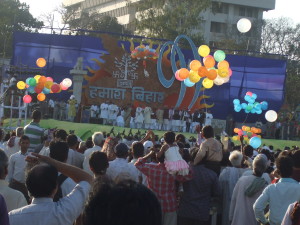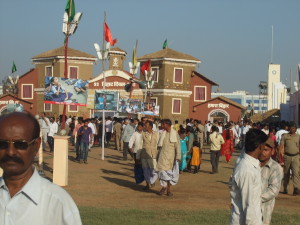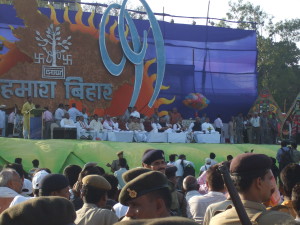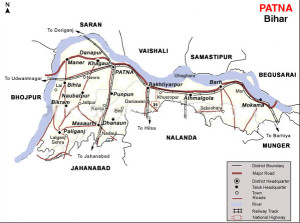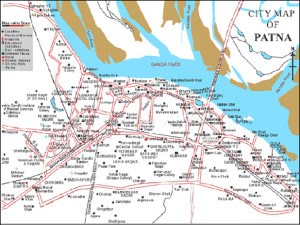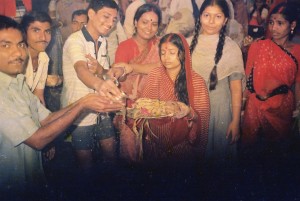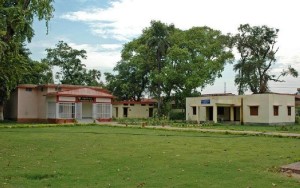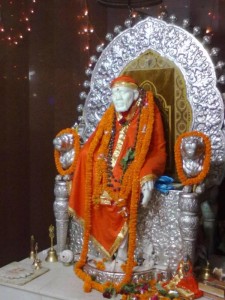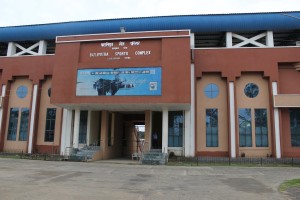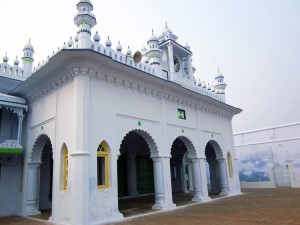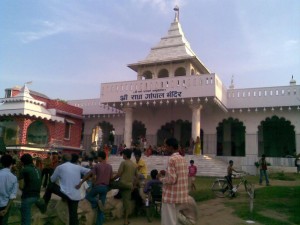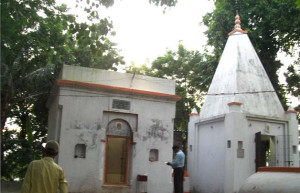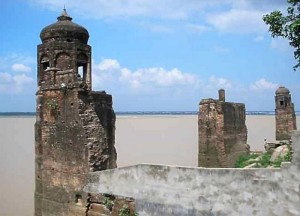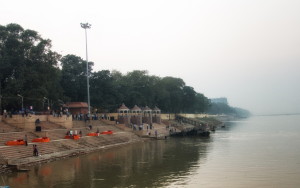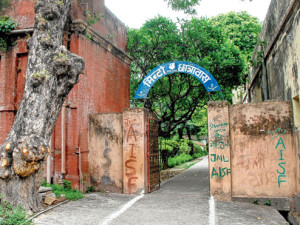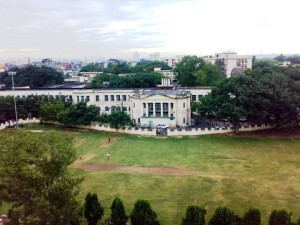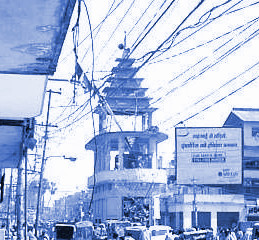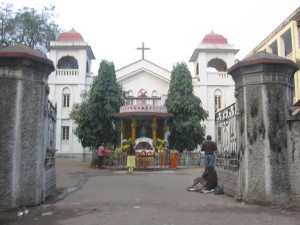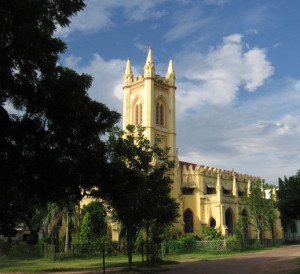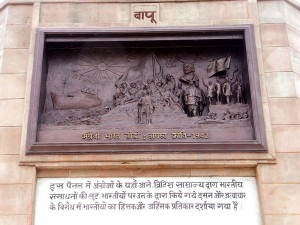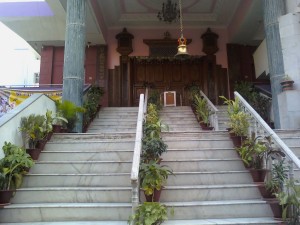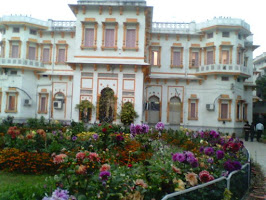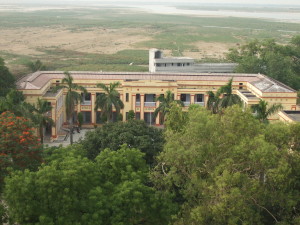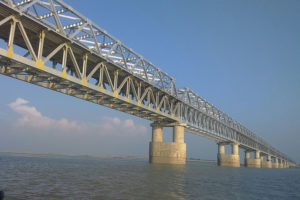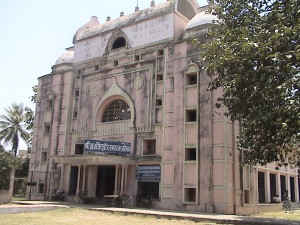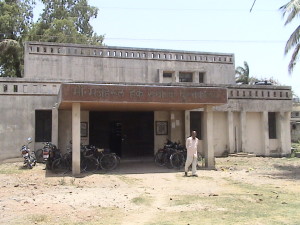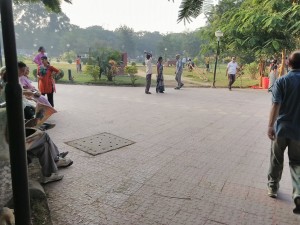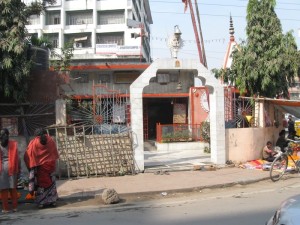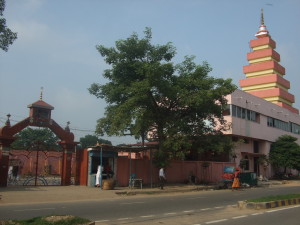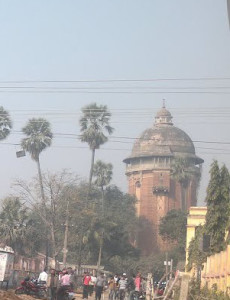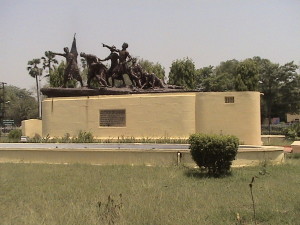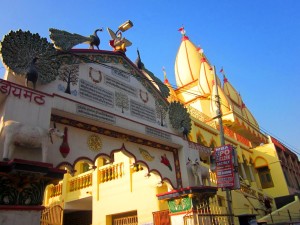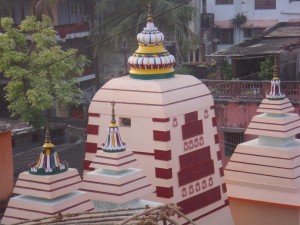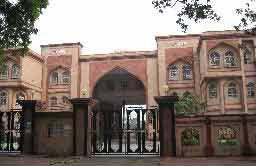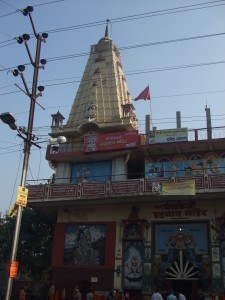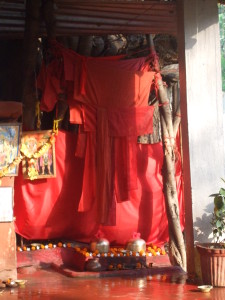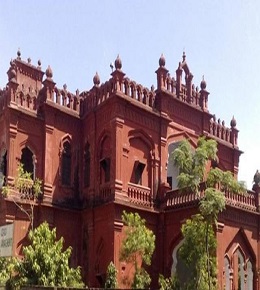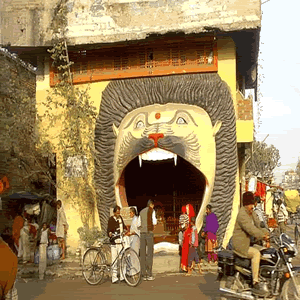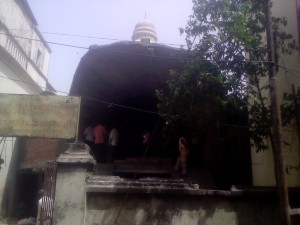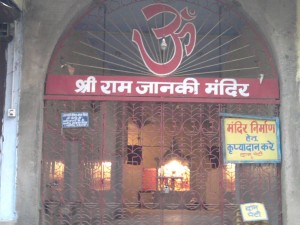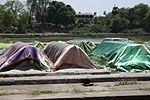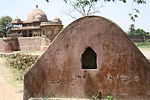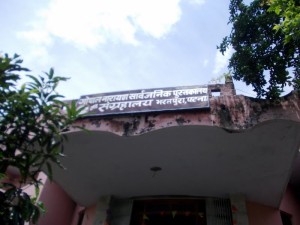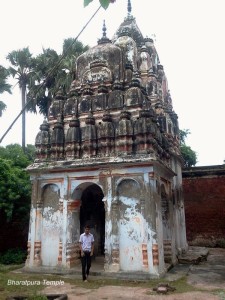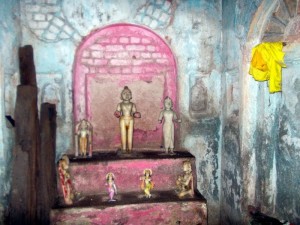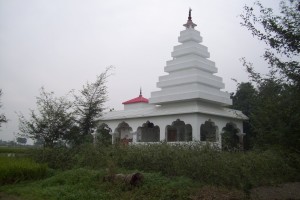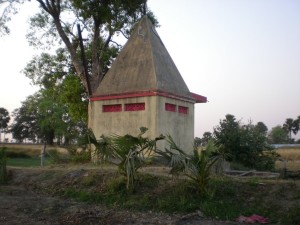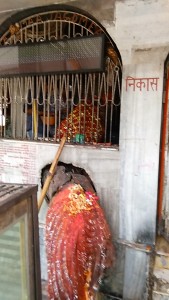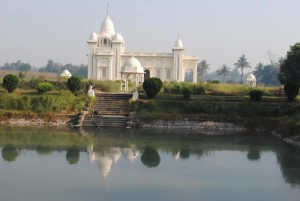Patna
PatnaHistory
Patna is one of the oldest cities in India. The city has been crowned by a new name during its each chapter of history of various dynasties, Patligram, Pataliputra, Kusumpur, Pushpapura, Azimabad and now a day Patna. There are several view regarding the source of appellation Patna. The name Patna is popularly believed to be derived from Maa Patan Devi Temple. It may be comes from Patton, meaning port in Sanskrit since, the city , located near the confluence of four rivers, has been a thriving river port. It may be a short form of Patliputra, one of the ancient names of the city. Legend ascribes its origin to a magic stroke of a mythological king Putraka, for his queen Patali, which gives it its ancient name Pataligram. It is said that in honor of the first born to the queen, the city was named Pataliputra.
The history of Patna started from the time of King Bimbisara’s son Ajatshatru (522 BC) who was interested in shifting his capital from hilly Rajagriha to a more strategically located place to compact the Licchavis of Vaishali. He chose the site on the confluence of Ganga-sone and fortified the area. From that time the city has had a continuous history. The fact is further corroborated by Gautama Buddha who was impressed by the city when he saw the fort being erected here while he was passing by this place in the last year of his life, and he had prophesied a great future for the city, but at the same time he predicated its ruins from flood, feud and fire.
With the rise of the Mauryan empire, the city became the seat of power and nerve centre of the Sub-continent. From Pataliputra, the famed empire Chandragupta Maurya ruled a vast empire, stretching to the north along the natural boundaries of the Himalayas and to the east, stretching into what is now Assam and Bangladesh. To the west, it reached beyond modern Pakistan and included significant portions of modern Herat and Kandahar in Afghanistan and Baluchistan. Early Mauryan Patliputra was mostly built with wooden structure. It was Emperor Asoka ,the grandson of Chandragupta Maurya, who transformed the wooden city into a stone construction around 273 BC. Chinese scholar Fa Hien, who visited India between AD 414-399 has given a vivid description of the structures in his travelogue. Megasthenes(350B C-290 BC), Greek historian and ambassador to the court of Chandragupta Maurya, gives the written account of Patliputra in his book “Indika” although this book is not available but reference of this book is given by ancient scholar Stono, Dayodorash, Pilvi, Yaariyan, Plutark and Justin in his book.
The Mauryan Empire was perhaps the greatest empire to rule the Indian subcontinent until the arrival of the British. Its decline began fifty years after Ashoka’s rule ended, and it dissolved in 185 BC with the foundation of the Sunga Dynasty in Magadha. It saw the rules of the Gupta empire and the Pala kings. However it never reached the glory that it has under the Mauryans.
Bakhtiar Khilji captured Bihar in 1197 AD and destroyed many ancient seats of learning. Patna lost its prestige as the political and cultural center of India. In 1288 AD Bihar became a part of Delhi kingdom. The most remarkable period was the middle of the 16 th century, during these times, Patna was revived under Sher Shah Suri. He constructed a fort and a town on the banks of Ganga. Sher Shah’s fort in Patna does not survive, except for some of the wall that have been incorporated within the complex of the Jalan House which was formerly the Nawab’s haveli and now a private residence, but the mosque built in Afghan architectural style survives.
It was August 1574 when Akbar came to Patna to crush The Afghan Chief, Daud Khan. Akbar’s navratna and secretary of state, historian and author of Ain-i-Akbari refers to Patna as a flourishing centre for stone, paper and glass industries. He also quoted to the high quality of numerous varieties of rice grown in Patna that had gained popularity in Europe. Mughal Emperor Aurangzeb agreed to the request of his favorite grandson, Prince Muhammad Azim to rename Patna as Azimabad in 1704 AD while Azim was in Patna as a Subedar. With decline of Mughal power, Patna goes into the hands of the Nawabs of Bengal, who maintained its commercial prosperity.
During the 17th century Patna became the centre of international trade. In year 1620, the British started with a factory in Patna for the trading in calico and silk. Soon it became a trading point for saltpetre, urging other Europeans i.e the French, the Danes, the Dutch and the Portuguese to compete the lucrative business. In 1632 Peter Mundy writing about Patna and calls this place ‘ the greatest part of the eastern region’ .
On 1 April,1912, when Bengal Presidency was partitioned, Patna became the capital of Bihar and Orissa Province. It soon emerged as an important and strategic centre. A number of important structures were constructed by the British. ,i.e. Patna Museum, State Assembly, Raj Bhavan, High Court, Old Secretariat, etc. On 1 April, 1936, Orissa was carved out as a separate province in the British Indian Empire. Patna continued as the capital of Bihar province. Patna plays a major role in the Indian Independence struggle. Seven life sized statues in front of the Assembly revive the memory of brave young men who sacrificed their lives in August 1942 struggle for independence. Sadaqat Ashram is another landmark which later became the retreat of Dr. Rajendra Prasad.
In 1975 – 1977: Suspension of the Republican Constitution. Patna is the centre of resistance against the Emergency.
1990 – 2005: Lalu Prasad/ Rabri Devi term of Government (RJD Party). Period marks the complete collapse of the Bihar economy, massive rise in crime, and the development of mass migration to other states in Indian Union of all classes/ castes and religions.
2005: In November, Janata Dal (United) with the BJP wins the state election with a working majority. Nitish Kumar becomes the first NDA Chief Minister of Bihar.Patna has shaken off its image as a city that was only mentioned in whispers.
The Only State Capital in the country with a large variety of historical monuments from Maurya to Gupta age and down to the Colonial British Rule. Patna could not attract domestic and foreign tourists in the recent past because of circumstances not of its own making.
Patna of 2009-16 is radically different from Patna of 2004. There is certainly a new excitement creeping in. In the past couple of years, enough guesthouses, hotels, restaurants, cafeterias, bars, and clubs have opened to support the city’s new role, not merely a place to unwind but a hub to explore the emerging new emerging economic opportunities in the region as well as a gateway to the Buddhist & Jain pilgrim centers of Vaishali, Rajgir, Nalanda,
Patna District
The district of Patna was constituted in the year 1865 out of portions of the then existing districts of Bihar (Vihar) and Tirhut. There were some minor changes of jurisdiction between 1881 and 1931, but its boundaries remained virtually intact thereafter until 1972 when the subdivision of Biharsharif was separated and upgraded as the independent district of Nalanda. The district is now left with 6 subdivisions, viz., Patna City, Patna Sadar, Danapur, Barh, Masaurhi and Paliganj consisting of 23 Community Development Blocks.The City of Patna, besides being the
headquarters of the district, is also the divisional headquarters and the State capital since 1911. The district is bounded on the north by the Ganges, beyond which lie the districts of Saran, Vaishali, Samastipur and Begusarai, on the east by the districts of Lakhisarai and Begusarai and on the south by the districts of Arwal, Jahanabad, Nalanda and Lakhisarai.
Latitude 21°58′ to 27°31 N
Longitude 83°19′ to 88°17’E
Total Area 3282 Square Kilometer
Max Temp (Summer) 440C-300C
Min Temp (Winter) 210C-50C
Languages – Hindi, Magahi,Maithili,Angika, Bhojpuri,Urdu,English
Best Time to Visit – October to March
Height above Sea – Level – 53 metre
River – Ganga, Sone and Punpun.
How To Reach
By Air(Airport) :-
 Jaiprakash Narayan Airport, Patna is an airport located 5 kilometres southwest of Patna railway station. According to the statistics released by the Airports Authority of India, it is the 21st busiest airport in India, and domestic traffic is growing rapidly.It is classified as a Restricted International Airport by AAI. Due to a lots of development work in Bihar, the AAI has planned to open a new International airport in Bihta 20 km from Patna.
Jaiprakash Narayan Airport, Patna is an airport located 5 kilometres southwest of Patna railway station. According to the statistics released by the Airports Authority of India, it is the 21st busiest airport in India, and domestic traffic is growing rapidly.It is classified as a Restricted International Airport by AAI. Due to a lots of development work in Bihar, the AAI has planned to open a new International airport in Bihta 20 km from Patna.
Indian Airlines, Jet-airways, IndiGo, Spirit Air and Air-Deccan flights connect Patna to the rest of the country. There are daily flights to and fro, from Delhi, Ranchi, Lucknow, Mumbai Pune and Kolkata.
By Rail :-
Patna junction (PNBE) is strategically located in the main line of the East Central Railway in Danapur Division with Railway Station as Patliputra Junction(PPTA), Patna Junction(PNBE), Rajendranagar Terminal(RJPB), Gulzarbagh (GZH), Patna Sahib (PNC) , Secretariat halt, Phulwarisharif and Danapur Junction(DNR). Patliputra Junction, Patna Junction, and Rajendra Nagar Junction are the three main railway stations providing train links to Patna from other parts of the country.
In January 2016, the construction of India’s longest road-cum-rail bridge, the Ganga Rail-Road Bridge, was completed on the banks of the Ganga nearby and connect Patna to Bharpura Pahleja Ghat (Sonepur).The bridge is 4.55 kilometres (2.83 mi) long and therefore, the longest road-cum-rail bridge in India as well as one of the longest in the world.
There are number of trains including Rajdhani linking with Delhi, Kolkata, Mumbai, Guwahati, Bangalore and Chennai.
By Road :-
Well connected to other city through National Highway – 30,30A,31,80,82,83,98,110 and by road network with the famous and important tourist centers like Gaya (105 km), Bodh Gaya(125 km), Rajgir 102 km), Nalanda (90 km), Vaishali and Pawapuri (90 km), besides other 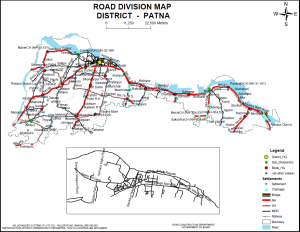 places in the state. Other important road are State highway – 1.2,4,69,78 and other road -Ullar Masaurhi Road,Bihta Lai Rd,Ashok Rajpath,Khagaul Naubatpur Road,Mokama Barh Road,Bailey Road , which connected the Patna internally or from other city of the state.
places in the state. Other important road are State highway – 1.2,4,69,78 and other road -Ullar Masaurhi Road,Bihta Lai Rd,Ashok Rajpath,Khagaul Naubatpur Road,Mokama Barh Road,Bailey Road , which connected the Patna internally or from other city of the state.
Patna Town area & Sadar Block
Popular tourist destinations
Patna Durga Puja, Patna Chhath Mela, Veer Kunwar Singh Park (Harding Park) , General Post Office (GPO) , Mithapur Flyover ,Chanakya National Law University, Mahavir Mandir ( In Front of Patna Jn Station), Old Jama Masjid ( In Front Patna Jn Station), Patna Junction Station, Buddha Smriti Park (In Front of Patna Jn Station), Karuna Stupa(Buddha Smirti Park), Park of Memories (Buddha Smirti Park), Museum (Buddha Smirti Park), Meditation Centre (Buddha Smirti Park), Remains of Bakipur central Jai, Chiraiyatand Flyover, College of Commerce (Bankman Colony, Kankarbagh), Rajendra nagar terminal station (Kankarbagh Road), Kumhrar (Kankarbagh Road), Archaeological Survey Of India Museum (Kumhrar), Makhdoom Ifteyar Khan Gouara Mazar (Kumhrar), Bulandibagh, Sandalpur (Gosainkunda), Kankar Bagh, 35-foot-high statue of Lord Shiva (Hanuman Nagar), Chhoti Pahari, Panch Pahari (Pahari Dih), Durakhi Devi Temple (Naya Tola), Moinul-Haquet stadium (Rajendra Nagar), Premchand Rangshala (Rajendra Nagar), Mahila Charkha Samiti (Kadamkuan), Sai Mandir (Kankarbagh), Panch Shiva Mandir (Kankarbagh), Shivaji Park(Near Tempo stand,Kankarbagh), Patliputra Sports Complex (Kankarbagh), Anugrah Seva Sadan, Digamber Jain Mandir (Congress Maidan), Agamkuan, Shitala Devi temple, Baoli Hall (Guru Govind Singh Hospital Campus, Patna City), Nijampur Kharhaunia Bagh(Patna City), Al-Jamiatur Razvia(Mosque ), Baoli Mosque (Sadikpur), Mirza Masoom’s mosque, Padri-Ki-Haveli (Catholic Church), Patna cemetery, Old Opium Warehouses (Gulzarbagh), Pachhim Darwaza, Badshah Manzil (Pachhim Darwaza), Hajjam Sahab’s kothi (Pachhim Darwaza), Gori Shankar Mandir (Gaighat) (Gulzarbagh), Sarva Mangala Devi Sthan (Gulzarbagh) , The Patliputra Teerth, Kamaldah Jain Temple, Panini’s ashram, Bissleboron, Nawab Shaheed Ka Maqbara, Naghol Kothi,Chitragupt Mandir, Sher Shah Suri Masjid(Hazigan, Tombs of Mustafa Khan Rohilla, Radha Krishna Temple (Near shershah road), Arzoo Manzil, Madrasa Mosque , Durga Mandir (Dhaulpura), Imam Bandi Begum Tomb (Patna city railway station), Imambada Imam Bandi Begum Waqf Estate, Patna City
Patna Durga Puja:-Patna is well known for its durga puja. Patna celebrates Durga Puja with much enthusiasm and gaiety. A number of pandals have been erected at various places of the city and elaborate arrangements made.
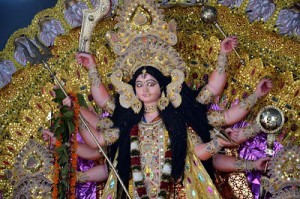 It is an annual Hindu festival in South Asia that celebrates worship of the Hindu goddess Durga. It refers to all the six days observed as Mahalaya, Shashthi, Maha Saptami, Maha Ashtami, Maha Nabami and Vijayadashami.
It is an annual Hindu festival in South Asia that celebrates worship of the Hindu goddess Durga. It refers to all the six days observed as Mahalaya, Shashthi, Maha Saptami, Maha Ashtami, Maha Nabami and Vijayadashami.
Durga Puja festival is celebrated from the sixth to tenth day of bright lunar fortnight (shukla paksha) in the Hindu Calendar in month of Ashvin.
Durga Puja festival marks the victory of Goddess Durga over the evil 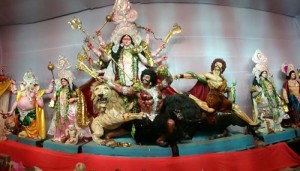 buffalo demon Mahishasura. Thus, Durga Puja festival epitomises the victory of Good over Evil.
buffalo demon Mahishasura. Thus, Durga Puja festival epitomises the victory of Good over Evil.
There is also a mythological belief that Lord Rama, worshiped Goddess Durga before going to war with Ravana. Rama had performed “Chandi Homa” and invoked the blessings of Durga, who blessed Rama with secret knowledge of the way to kill Ravana. On the day of Ashvin Shukla Dashami, Rama’s party found Sita and defeated Ravana. This day is thus also celebrated as Dussehra.
Pujas are organised by a committee which represents a locality or neighbourhood. They collect funds called “chaanda” through door-to-door subscriptions, lotteries, concerts etc.The city witnesses a huge surge in visitors in the four days from Maha Saptami up to Vijaya Dashami. More than 1000 exhibits, known as pandals, are set up across the city. Ancient Places of Patna Durga Puja includes Bari and Chhoti Patan Devi, Maa Shitla Mandir Agamkuan etc. Some of the popular puja pandals include New Dak Bungalow Road, Shiv Mandir Khajpura, Shri Krishna Puri, Durga Ashram etc. Shastri Nagar Durga Puja Samiti, Durga Puja at Polytechnic More, Patliputra Colony, Durga Puja at Panchmukhi Hanuman Mandir (Boring Canal Road), Durga Puja at BSEB Colony, Lord Shiva Temple, Durga Puja at Fraser Road Area, Durga Puja at Raja Bazar petrol pump , Panchmukhi Mandir Trust, Durga Puja at Boring Road crossing, Durga Puja at shiv mandir durga puja samiti,Durga Puja at Bangali Akhara, Durga Puja at Brahmasthan Dariyapur, Mithapur Jakkanpur Durga Puja Samiti, Kali bari at Yarpur, Bengali akhara at Marufganj, Golghar club at golghar, Tarun sangh at boring road, Recreation club at Bhikhna Pahari, Ramkrishna Ashram at Nala road, Adalatganj club and R-block club are some of the big names of puja samity associated with the puja celebrations in Patna.
the four days from Maha Saptami up to Vijaya Dashami. More than 1000 exhibits, known as pandals, are set up across the city. Ancient Places of Patna Durga Puja includes Bari and Chhoti Patan Devi, Maa Shitla Mandir Agamkuan etc. Some of the popular puja pandals include New Dak Bungalow Road, Shiv Mandir Khajpura, Shri Krishna Puri, Durga Ashram etc. Shastri Nagar Durga Puja Samiti, Durga Puja at Polytechnic More, Patliputra Colony, Durga Puja at Panchmukhi Hanuman Mandir (Boring Canal Road), Durga Puja at BSEB Colony, Lord Shiva Temple, Durga Puja at Fraser Road Area, Durga Puja at Raja Bazar petrol pump , Panchmukhi Mandir Trust, Durga Puja at Boring Road crossing, Durga Puja at shiv mandir durga puja samiti,Durga Puja at Bangali Akhara, Durga Puja at Brahmasthan Dariyapur, Mithapur Jakkanpur Durga Puja Samiti, Kali bari at Yarpur, Bengali akhara at Marufganj, Golghar club at golghar, Tarun sangh at boring road, Recreation club at Bhikhna Pahari, Ramkrishna Ashram at Nala road, Adalatganj club and R-block club are some of the big names of puja samity associated with the puja celebrations in Patna.
Patna Chhath Mela:-Lack And lacks devotees from different place play a visit to perform the chhata vrata on the bank of sacred river Ganga . The fairs takes place there bi-annually in the month of Kartika and Chait.
Chhath is an ancient Hindu Vedic festival dedicated to the Hindu Sun God and Chhathi Maiya an ancient Vedic Goddess , Usha- wife of Sun God . The Chhath Puja is performed in order to thank Surya for sustaining life on earth
and to request the granting of certain wishes. It is also celebrated in the summer (March–April), on Chitra Shashti.
Chhath puja is performed on Kartika Shukla Shashti, which is the sixth day of the month of Kartika in the Vikram Samvat. This falls typically in the month of October or November in the Gregorian English Calendar.
The rituals of the festival are rigorous and are observed of a period of four days.
Nahay khay/Arwa Arwain: This day the people who observe fast take bath at a river or pond and prepare lunch (consisting of rice,dal mixed with pumpkin and pumpkin, made in pure ghee).
Lohanda and Kharna: The second day is known as kharna or kheer- roti. In which the kheer , a Indian recipe where rice is prepared with sweetened milk instead of water and chapati , called roti in many Indian provinces.The people observe fast for the full day without taking even water and eat this kheer-roti as dinner after offering it to the rising moon and Goddess Ganga. This is the only time when they eat or drink anything from the starting of the day till the last day of chhath.
Sandhya Arghya (evening offerings) Or Pahela Aragh:The third day is the main festival day of chhath is observed by offering surya namaskar and fruits to the setting sun.
Usha Arghya (morning offerings) Or Dusra Aragh:On the final day of Chhath Puja the event of offering surya namaskar and fruits to the rising sun performed .The festival ends with the breaking of the fast by the Vratins.
Veer Kunwar Singh Park (Harding Park) :-
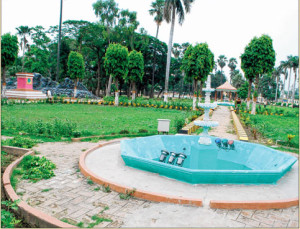 It is located between the Secretariat and the railway station . It was built in 1913 to celebrate the visit of Lord Hardinge the British Governor General of India. In memory of lord Hardinge a bronze statue was erected within the park. The unveiling ceremony of this statue was performed on 31 st Jan 1916. This is the first statue erected in Patna and has cost about a lakh of rupees. It was moved from here to Patna Museum in the year 1967. After independence, it was renamed as Veer Kunwar Singh Park. It extended up to The Railway line on its south and was bisected by the road connecting the railway station to the New Capital. In later years, the eastern end of the Hardinge Park became a camping ground for various circus parties.Later, the southern Portion of the garden was converted into a bus stand, now the railways have taken it over for their expansion programme. Now a day spread over an area of 25 acres, the park offers anideal place to rest and relax. Chief Minister Nitish Kumar proclaimed on 22 April 2011 on the occasion of birth anniversary celebration that “the Bihar government has decided to convert the Harding Park as Veer Kunwar Singh Azadi Park in a token of tribute to Veer Kunwar Singh, one of the iconic leaders of the country’s first war of Independence from British Colonial rulers in 1857, and will be developed in such a manner to showcase the contributions of the freedom fighters who laid down their lives for the Independence of the country from 1857 to 1947. There will be lots of materials available at the park to educate the younger generations about the sacrifices made by our freedom fighters to win
It is located between the Secretariat and the railway station . It was built in 1913 to celebrate the visit of Lord Hardinge the British Governor General of India. In memory of lord Hardinge a bronze statue was erected within the park. The unveiling ceremony of this statue was performed on 31 st Jan 1916. This is the first statue erected in Patna and has cost about a lakh of rupees. It was moved from here to Patna Museum in the year 1967. After independence, it was renamed as Veer Kunwar Singh Park. It extended up to The Railway line on its south and was bisected by the road connecting the railway station to the New Capital. In later years, the eastern end of the Hardinge Park became a camping ground for various circus parties.Later, the southern Portion of the garden was converted into a bus stand, now the railways have taken it over for their expansion programme. Now a day spread over an area of 25 acres, the park offers anideal place to rest and relax. Chief Minister Nitish Kumar proclaimed on 22 April 2011 on the occasion of birth anniversary celebration that “the Bihar government has decided to convert the Harding Park as Veer Kunwar Singh Azadi Park in a token of tribute to Veer Kunwar Singh, one of the iconic leaders of the country’s first war of Independence from British Colonial rulers in 1857, and will be developed in such a manner to showcase the contributions of the freedom fighters who laid down their lives for the Independence of the country from 1857 to 1947. There will be lots of materials available at the park to educate the younger generations about the sacrifices made by our freedom fighters to win
.

 independence from the yoke of British colonialism. The youths will get to know about the history of the freedom struggle without reading books by merely paying visit to the park”.
independence from the yoke of British colonialism. The youths will get to know about the history of the freedom struggle without reading books by merely paying visit to the park”.
General Post Office (GPO) :-Patna General Post Office (GPO) is located near Harding Park now a day renamed as Veer Kumar Singh Park. It is one of the old and beautiful buildings in city, constructed by the British, as a marvel of British Architecture, reflect Pseudo-Renaissance influence. Credit for designing this majestic building goes to the architect, I. F. Cunnings. It is head office of Indian Postal Department in Bihar. Patna General Post Office is the only post office in Bihar where the Western Union money transfer facility is available for non-resident Indians.
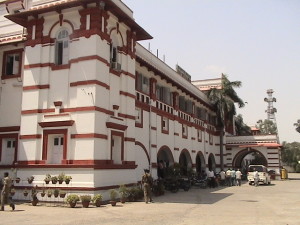
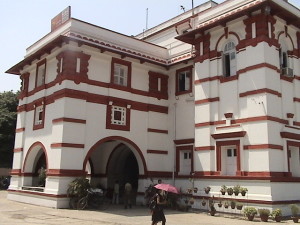
 It was ranked second in October 2001 for receiving foreign currency from various countries through Western Union Money Transfer. The GPO also offers the facilities of speed post, registered post, parcel and insurance.
It was ranked second in October 2001 for receiving foreign currency from various countries through Western Union Money Transfer. The GPO also offers the facilities of speed post, registered post, parcel and insurance.
Mithapur Flyover :-It was inaugurated by Honorable Chief minister Shri Nitish Kumar on dated 03.10.2011 on the occasion of Durga Puja. Connects harding road with the mithapur road over railway line.the Mithapur ROB is likely to incur an expenditure of about Rs 56 crore, out of which the state government has to contribute its share money of Rs 42 crore. this bridge will be 250.9 metre long while its width will be 15 metre to cope with the heavy rush of traffic. There will be as many as 140 piers of the bridge with the provision for four-lane traffic flow on the bridge. The Simplex India Ltd. has been assigned the work to carry out the Mithapur ROB construction as per the approved plan of the bridge. Overall, the Mithapur road overbridge is a big project with a bridge length of 2,310 metres. When fully completed, the construction cost would be to the tune of Rs 188 crore.

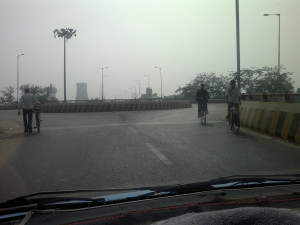
 Till now, only around 60 per cent of the project has been completed, as only the part corresponding with the first phase of work, over 1,300-metre length of the bridge entailing cost of Rs 88 crore, has been completed. The existing road overbridges on the Delhi-Howrah main railway line in Patna, other than the Mithapur overbridge, are Chitkohra overbridge, Gardanibagh-Hardinge overbridge, R-Block overbridge, Chiraiyatand overbridge, Rajendra Nagar overbridge, Bahadurpur overbridge and Agamkuan overbridge.The ROB, which was sanctioned in 1998,The Mithapur ROB, which is being built at an estimated cost of Rs 180 crore by IRCON (railways’ construction wing),
Till now, only around 60 per cent of the project has been completed, as only the part corresponding with the first phase of work, over 1,300-metre length of the bridge entailing cost of Rs 88 crore, has been completed. The existing road overbridges on the Delhi-Howrah main railway line in Patna, other than the Mithapur overbridge, are Chitkohra overbridge, Gardanibagh-Hardinge overbridge, R-Block overbridge, Chiraiyatand overbridge, Rajendra Nagar overbridge, Bahadurpur overbridge and Agamkuan overbridge.The ROB, which was sanctioned in 1998,The Mithapur ROB, which is being built at an estimated cost of Rs 180 crore by IRCON (railways’ construction wing),
Chanakya National Law University:-It is located at Nyaya Nagar, Mithapur. The university came into being on July 15th, 2006 , under the able guidance of its Vice-Chancellor/Pro-Chancellor, Prof. A. Lakshminath, former Dean and Registrar, NALSAR University of Law, Hyderabad and the recipient of Prof. N. R. Madhava Menon Best Law Teacher Award -2012. CNLU was established under the Chanakya National Law University Act, 2006 (Bihar Act No. 24 of 2006) and included in section 2(f) & 12(B) of the U.G.C. Act, 1956. The Chief Justice of Patna High Court is the ex officio Chancellor of the university.
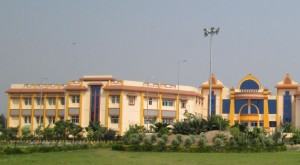 The University is presently functioning from its own Campus admeasuring 18 Acres of land situated in the heart of Patna with spacious Halls of Residence for Boys and Girls, state of the Art Library, Academic and Administrative Blocks with Internet Center having Wi-Fi facility with dedicated lease line and committed Faculty.
The University is presently functioning from its own Campus admeasuring 18 Acres of land situated in the heart of Patna with spacious Halls of Residence for Boys and Girls, state of the Art Library, Academic and Administrative Blocks with Internet Center having Wi-Fi facility with dedicated lease line and committed Faculty.
Mahavir Mandir ( In Front of Patna Jn Station):-It is one of the holiest Hindu temples dedicated to Lord Hanuman. It is Situated in front of the Patna Junction. Million of pilgrims visit the temple every year and is the second most 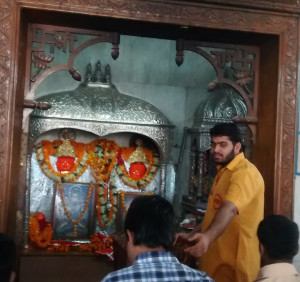 visited religious shrine in North India. The Mahavir Mandir Trusts, named as Shri Mahavir Sthan Nyas’ Samiti have the second highest budget in North India after the famous Maa Vaishno Devi shrine. The Trusts also runs number of human welfare organization like Mahavir Cancer Sansthan, Mahavir Vaatsalya Hospital, Mahavir Arogya Hospital and several
visited religious shrine in North India. The Mahavir Mandir Trusts, named as Shri Mahavir Sthan Nyas’ Samiti have the second highest budget in North India after the famous Maa Vaishno Devi shrine. The Trusts also runs number of human welfare organization like Mahavir Cancer Sansthan, Mahavir Vaatsalya Hospital, Mahavir Arogya Hospital and several
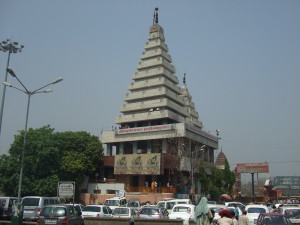 hospitals and orphanage in the Bihar.
hospitals and orphanage in the Bihar.
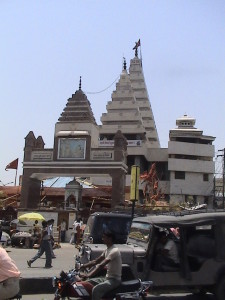 The first establishment date of temple is so the still unknown creator. This temple was founded in a humble room with clay-tile roof, about sixty years ago, during the British Raj. It used to be lit by a single kerosene lamp in the evening. Nobody, however devout a worshipper of Mahavir, would dare enter the darkroom at night. This temple gained in popularity when some Punjabi Hindu refugees came to Patna after the partition in 1947 and subsequently temple was rebuilt as a concrete house at same time. Even this was broken down in 1987 to make a huge marble temple. It was again rebuilt in 1991. The idol of Sankat-Mochan stands in it.It also houses a number of images of various Hindu deities. Recently an impressive five feet idol of Goddess Saraswati in sitting position with a large veena in hands and a swan by the side is installed at Mahavir Mandir on Saraswati Puja day 2011.
The first establishment date of temple is so the still unknown creator. This temple was founded in a humble room with clay-tile roof, about sixty years ago, during the British Raj. It used to be lit by a single kerosene lamp in the evening. Nobody, however devout a worshipper of Mahavir, would dare enter the darkroom at night. This temple gained in popularity when some Punjabi Hindu refugees came to Patna after the partition in 1947 and subsequently temple was rebuilt as a concrete house at same time. Even this was broken down in 1987 to make a huge marble temple. It was again rebuilt in 1991. The idol of Sankat-Mochan stands in it.It also houses a number of images of various Hindu deities. Recently an impressive five feet idol of Goddess Saraswati in sitting position with a large veena in hands and a swan by the side is installed at Mahavir Mandir on Saraswati Puja day 2011.
Old Jama Masjid ( In Front Patna Jn Station) :-It is located just outside Patna railway station in New Market . Jama Masjid is the biggest 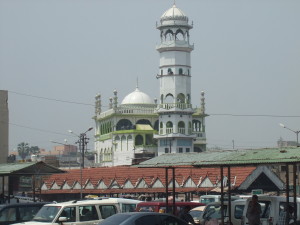
Patna Junction Station:-It is established in year 1862 as a small station named Bankipur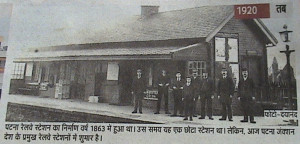 . As a Patna railway junction it started functioning from 1914.There are two branch lines one is in the western zone that connects Patna junction railway station with Digha Ghat and the other is in the eastern zone connecting the Patna City railway station with Patna Ghat. The Danapur Division came into existence on 1 January 1925. The present Divisional Railway Manager’s office building was built in 1929. In 1948 Eastern Railway (ER) started an exclusively third class express train known as ‘Janta Express’ on 1 October. This initially ran between Patna and Delhi and later on was extended from Delhi up to Howrah in 1949. This was the first Janta Express train in India.
. As a Patna railway junction it started functioning from 1914.There are two branch lines one is in the western zone that connects Patna junction railway station with Digha Ghat and the other is in the eastern zone connecting the Patna City railway station with Patna Ghat. The Danapur Division came into existence on 1 January 1925. The present Divisional Railway Manager’s office building was built in 1929. In 1948 Eastern Railway (ER) started an exclusively third class express train known as ‘Janta Express’ on 1 October. This initially ran between Patna and Delhi and later on was extended from Delhi up to Howrah in 1949. This was the first Janta Express train in India.
 Patna station is a major railhead of the East Central Railways. The main junction station of Patna is very well connected with major Indian cities like New Delhi, Mumbai, Kolkata, Chennai, Hyderabad, Bangalore, Pane, Ahmedabad, Indore, Bhopal, Jabalpur, Raipur, Lucknow, Kanpur etc.
Patna station is a major railhead of the East Central Railways. The main junction station of Patna is very well connected with major Indian cities like New Delhi, Mumbai, Kolkata, Chennai, Hyderabad, Bangalore, Pane, Ahmedabad, Indore, Bhopal, Jabalpur, Raipur, Lucknow, Kanpur etc.
Buddha Smriti Park (In Front of Patna Jn Station):-The Park, a dream project of Honorable Chief minister Shri Nitish Kumar is located on the demolished Bankipur central jail in front of Mahabir Mandir spread over an area of 22 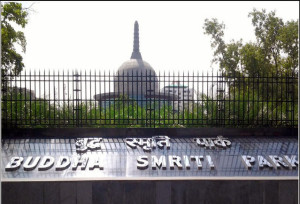 acres. It is inaugurated by Tibetan Spiritual Leader the Dalai lama on dated 27.5.2010 on the occasion of Buddha Jayanti on Buddha Purnima to commemorate the 2550 the year of Lord Buddha’s Mahaparinirvana. Park is an urban open space created to provide a thematic green space in the heart of Patna. The theme of the park is based on the historical relationship between Buddhism and the state of Bihar.The park comprises a large landscaped garden with two saplings of the sacred Buddha tree brought from Bodh Gaya( India) and Anuradhapuram (Sri Lanka) , within which are located a Meditation Centre, a Stupa, a museum and a multi storey car park . Its design has been conceived around the enshrine of holy relics of Sakyamuni Buddha. It is Design by Bikram Lal of Bihar the designer of Akshardham Mandir, Delhi.
acres. It is inaugurated by Tibetan Spiritual Leader the Dalai lama on dated 27.5.2010 on the occasion of Buddha Jayanti on Buddha Purnima to commemorate the 2550 the year of Lord Buddha’s Mahaparinirvana. Park is an urban open space created to provide a thematic green space in the heart of Patna. The theme of the park is based on the historical relationship between Buddhism and the state of Bihar.The park comprises a large landscaped garden with two saplings of the sacred Buddha tree brought from Bodh Gaya( India) and Anuradhapuram (Sri Lanka) , within which are located a Meditation Centre, a Stupa, a museum and a multi storey car park . Its design has been conceived around the enshrine of holy relics of Sakyamuni Buddha. It is Design by Bikram Lal of Bihar the designer of Akshardham Mandir, Delhi.
Karuna Stupa(Buddha Smirti Park) :-It enshrining the Holy relics of Lord Buddha, taken from five places i.e. Japan, Thailand, Sri Lanka, Myanmar and 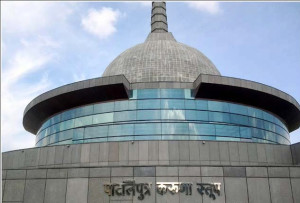 Dharamsala (H.P) is the focal point of the Buddha smriti park. A paths around the stupa for parikrama have been provided at three different levels that lead to the highest level of the building. The relics are enshrined within the secure glass structure of the stupa and are accessible for viewing.
Dharamsala (H.P) is the focal point of the Buddha smriti park. A paths around the stupa for parikrama have been provided at three different levels that lead to the highest level of the building. The relics are enshrined within the secure glass structure of the stupa and are accessible for viewing.
Park of Memories (Buddha Smirti Park) :-It is a landscaped open space would have votive stupas from countries across the world, designed in the architectural pattern representative of the specific country. The park  symbolically represents the dispersion of Buddhism from Bihar to various regions of the world. A sapling from the original bodhi tree under which Buddha sat was carried to Sri Lanka by Sanghamitta ( Daughter of Emperor Asoka’s)and now flourishes at Anuradhapuram. A sapling from it is carried here from Anuradhapuram and sat aside the Stupa with a sapling from the Gaya.
symbolically represents the dispersion of Buddhism from Bihar to various regions of the world. A sapling from the original bodhi tree under which Buddha sat was carried to Sri Lanka by Sanghamitta ( Daughter of Emperor Asoka’s)and now flourishes at Anuradhapuram. A sapling from it is carried here from Anuradhapuram and sat aside the Stupa with a sapling from the Gaya.
Museum (Buddha Smirti Park) :-The museum building impersonates the free flowing natural form of the Buddhist cave monasteries of India that evolved from the earliest examples of Barabar caves found in 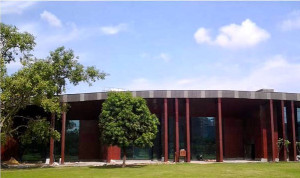
Jehanabad (Bihar). The Museum will showcase the life and times of Lord Buddha through original artifacts, 3-D, audio and video presentations.
Meditation Centre (Buddha Smirti Park) :-The meditation centre has been developed to create a unique facility dedicated to the practice of meditation. The 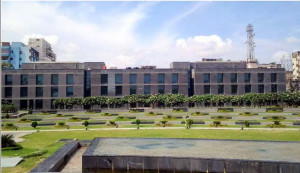 design is derived from plan of the monasteries in the ancient Mahavira of Nalanda. It consists of a total of 60 air- conditioned cells, each having a view of the Stupa enshrining the sacred relics of Sakyamuni Buddha. A library consisting of books on Buddhism along with a large Audio- Visual Hall for groups is also provided in this facility.
design is derived from plan of the monasteries in the ancient Mahavira of Nalanda. It consists of a total of 60 air- conditioned cells, each having a view of the Stupa enshrining the sacred relics of Sakyamuni Buddha. A library consisting of books on Buddhism along with a large Audio- Visual Hall for groups is also provided in this facility.
Remains of Bakipur central Jail :-It is situated in front of Patna railway station. The site of Buddha Smriti Park was Bankipur Jail earlier, which has historical importance. As an archival site, one part of the Jails
 with one tower has been protected inside the newly constructed Buddha Park . The earliest reference of Bankipur Jail in the archival records is from 1895 AD, when it was sub divisional Jail under Gaya Central Jail. In 1907 it was referred as a District Jail. In 1967 it was converted as Central Jail. In 1994, the Bankipur Jail was shifted from this place. A large number of freedom fighters including Dr. Rajendra Prasad, the first president of Republic of India were kept in this Jail.
with one tower has been protected inside the newly constructed Buddha Park . The earliest reference of Bankipur Jail in the archival records is from 1895 AD, when it was sub divisional Jail under Gaya Central Jail. In 1907 it was referred as a District Jail. In 1967 it was converted as Central Jail. In 1994, the Bankipur Jail was shifted from this place. A large number of freedom fighters including Dr. Rajendra Prasad, the first president of Republic of India were kept in this Jail.
Chiraiyatand Flyover:-Many new flyovers have come up in Patna in the last few years to ease the congestion in the city, Chiraiyatand Flyover near Kankarbagh is on of them.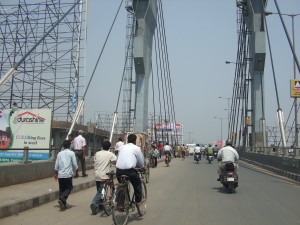 Bihar Chief Minister Nitish Kumar inaugurating Chiraiyatand flyover on June 11, 2009.
Bihar Chief Minister Nitish Kumar inaugurating Chiraiyatand flyover on June 11, 2009.
College of Commerce (Bankman Colony, Kankarbagh):-It is located at Bankman Colony, Kankarbagh by pass road near Rajendra nagar railway station. It is one of the oldest constituent unit and Post Graduate Centre of Magadh University, Bodh Gaya (Bihar, India) duly recognized by University Grants Commission, New Delhi under 2(f) and 12(B). 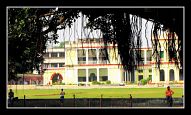 The college was established in 1949 by Pt. Indu Shekhar Jha, a man of great vision, the founder principal of the college, and also, the father of commerce education in Bihar at P.N. Anglo Sanskrit School Campus, Naya Tola, Patna in a rented house. Later on, in 1953, Raja of Pali graciously donated lands to start the college at the place where it is today. The college was affiliated to Bihar University, Muzaffarpur a new university launched in 1952 in Bihar. In 1957, Science education was introduced in the college, followed by Arts faculty in 1960 and Law in 1963 and affiliated with Magadh University, in Year 1962. Currently, the College is imparting undergraduate and postgraduate education to students in many subjects of Arts, Science and Commerce with adequate infrastructure including well furnished laboratories, library and spacious classrooms. P.G. teaching was initiated in 1984 when Magadh University, Bodh Gaya selected the College as a Post Graduate Centre.
The college was established in 1949 by Pt. Indu Shekhar Jha, a man of great vision, the founder principal of the college, and also, the father of commerce education in Bihar at P.N. Anglo Sanskrit School Campus, Naya Tola, Patna in a rented house. Later on, in 1953, Raja of Pali graciously donated lands to start the college at the place where it is today. The college was affiliated to Bihar University, Muzaffarpur a new university launched in 1952 in Bihar. In 1957, Science education was introduced in the college, followed by Arts faculty in 1960 and Law in 1963 and affiliated with Magadh University, in Year 1962. Currently, the College is imparting undergraduate and postgraduate education to students in many subjects of Arts, Science and Commerce with adequate infrastructure including well furnished laboratories, library and spacious classrooms. P.G. teaching was initiated in 1984 when Magadh University, Bodh Gaya selected the College as a Post Graduate Centre.
Rajendra nagar terminal station (Kankarbagh Road):-
It was developed as an alternative railway station as part of measures to decongest Patna Junction Railway Station. Many trains originate from here. It was inaugurated on March 31, 2003 as a full-fledged station. Built at a cost of Rs 8.61 crore, has all modern facilities for the passengers. Its main entrance is opposite the College of Commerce, Patna. Lalu also unveiled a statue of Dr Rajendra Prasad at Rajendra Nagar Terminal after whom this station has been named.
Kumhrar (Kankarbagh Road):-Kumhrar is the site that consists of the archaeological excavations of Pataliputra and marks as the ancient capital of Ajatshatru, Chandragupta and Ashoka, situated 5 kms from Patna railway station and only 1 km from Rajendra Nagar Station on Kankarbagh Road. Excavations at Kumhrar have resulted numerous structures and artifacts of the past. Excavations here have revealed relics of four continuous periods from 600 BC to 600 AD. The most striking and relevant finding at the spot is the 80-pillared huge hall,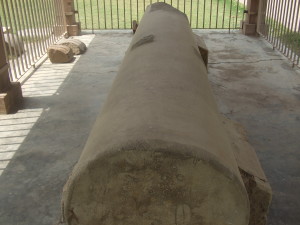

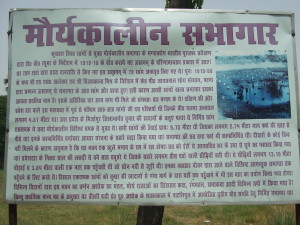

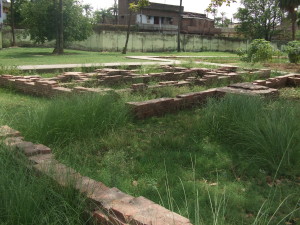
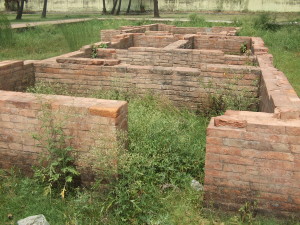
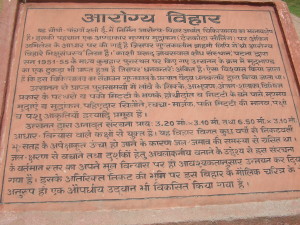


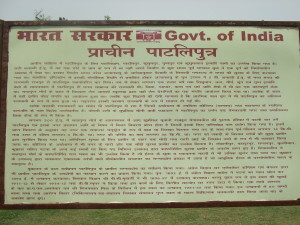
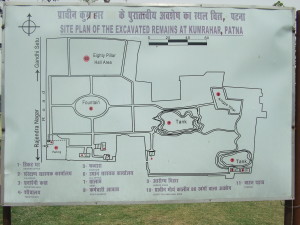 `
`
This is said to have been the parliament of Chandragupta Maurya. . According to archaeologists and historians, it dates back to 300 BC. During the excavation work, carried out, 1912 -1915, by D B Spooner, one pillar of polished stone, and a very large number of fragments were found. The excavators were able to trace 72 ‘pits’ of ash and rubble on the site which marked the position in which other pillars must once have stood.
During the subsequent excavation, done by K P Jaiswal, 1951-1955, eight more such pits were found, giving the hall its present name – “Assembly hall of 80 pillars”. All the ruins are attributed to the Mauryan period, though historians vary regarding the use of the 80-pillar hall, some suggest that it was in this hall that Third Buddhist Council was held in 250 BCE, at Asokarama in Patiliputta (Patliputra), under the reign of Mauryan Emperor, Ashoka ( 273 BC-232 BC).
The parliament or assembly hall was an excellent specimen of architectural expertise. Near the assembly hall is a brick made Buddhist monastery, popularly called Anand Vihar. During excavation archeologists found the marks of ‘Arogya Vihar’ which was headed by famous physician Dhanvantari.
Archaeological Survey Of India Museum (Kumhrar):-
It is Kumhrar Park’s museum, where the old artefacts taken out of the excavation of old historical Maurya Pataliputra of ancient time is preserved.There is also the model of 80-pillared-hall and the findings are kept. There are many photographs along with the vivid description of the history which takes back to the Mauryan period. A replica of excavated hall is also on display.
Makhdoom Ifteyar Khan Gouara Mazar (Kumhrar) :-
Bulandibagh:-
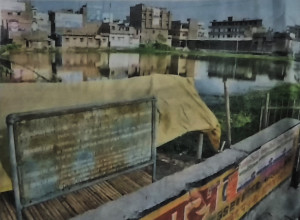 Remains of wooden palisades have been discovered in excavations Bulandibagh, already tapped by Spooner, was re-excavated in 1926-27 by J .A. Page and M. Ghosh resulting in the discovery of an wooden structure running as excavated for a distance of about 137 m. It is a wall made of heavy wooden sleepers placed vertically in a double row, with similar sleepers joining them horizontally at the bottom and is thought to be a part of the wooden palisade seen by Megasthenes. Spooner’s finds from Kumrahar and Bulandibagh consist of punch-marked coins, terracotta figurines including the head of a smiling boy and a dancing girl, stone and glass beads, finished and unfinished seals including a glass seal with a Mauryan inscription
Remains of wooden palisades have been discovered in excavations Bulandibagh, already tapped by Spooner, was re-excavated in 1926-27 by J .A. Page and M. Ghosh resulting in the discovery of an wooden structure running as excavated for a distance of about 137 m. It is a wall made of heavy wooden sleepers placed vertically in a double row, with similar sleepers joining them horizontally at the bottom and is thought to be a part of the wooden palisade seen by Megasthenes. Spooner’s finds from Kumrahar and Bulandibagh consist of punch-marked coins, terracotta figurines including the head of a smiling boy and a dancing girl, stone and glass beads, finished and unfinished seals including a glass seal with a Mauryan inscription
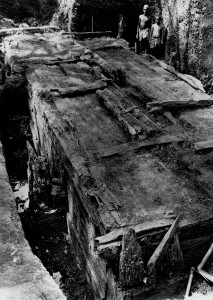
(The grove known as Bulabdibagh)
Sandalpur (Gosainkunda) :-Remains of wooden foundation and Mauryan walls locally known as Gosainkunda (Sandalpur) 800 m to the of Bulandi Bagh was found. Excavation done here in year 1935 revealed a similar structure as found at Bulandi Bagh, but in a reversed fashion, vertical sleepers capped by horizontal ones.
Kankar Bagh :-During the construction of sewer line by the P.H.E.D of the Gov.of Bihar, it is come to light an ancient remains of wooden post in year 1970-71 immediately after that a small scale excavation was done by the ASI , within a limited area of the cutting, the salvage excavation revealed as many as fourteen posts, arranged in four rows. The upper ends of most of the post tapered to a tenon- like finish. In a few cases mortises were also observed. The posts were placed 1-50 to 1-75 metres apart, on the sides, the post were enclosed by wooden planks fixed with iron nails, making the structure into a series of boxes, which were rammed with earth and thus formed the core of the fortification-wall. One the basis of the occurrence , it is likely that the wooden pillars formed a part of the Mauryan palisade of ancient Pataliputra.
35-foot-high statue of Lord Shiva (Hanuman Nagar):-
Chhoti Pahari :-The mound or stupa known as “Chhoti Pahari” is the site of Upagupta hermitage. Upagupta was the high priest of the Buddhist Monastery who converted Asoka the Great to Buddhism and became his Guru. He persuaded Asoka to make a pilgrimage in all the places associated with Buddha. Mauryan Period site
Panch Pahari (Pahari Dih):-A group of five mounds look like artificial hills known as the”Panch Pahari”. These five mounds represent the site of the five Relic Stupas erected by Ashoka with exceptional grandeur.
Durakhi Devi Temple (Naya Tola):-It is located at Naya Tola (Kankarbagh) about a kilometer west from Kankarbagh. The temple consists the piece of the stone shows the semi-nude female figures on both of its faces, hence earned the name of ‘Durukhi’ or ‘Durukhiya’ (double faced) Devi. This is a detached member of a carved railing of a stupa founded in Kumhrar. It was discovered by Waddell way back in 1890s while excavating the site Kumhrar. Sometime afterwards , it was brought down to its present location. This is a fine specimen of the Shunga art of the 2nd-1st Century B.C. As these female figures are shown grabbing and breaking branches of trees with one of their hands, they are considered to be representing the ‘Shalabhanjikas’ (the breaker of branches), the young women under a ritual associated with fertility, that was popular during the early historic period in this part of India.
A replica of this image is displayed in the Patna Museum’s sculptural gallery.
A comparable bifacial female figure was accidentally discovered in the recent past from Rajendra Nagar locality in Patna which is also displayed in the same gallery. (An overview of archaeological importance of Bihar Directorate of Archaeology, Govt. of Bihar).
Moinul-Haquet stadium (Rajendra Nagar) :-It is located in Rajendra Nagar , 1 kms from Rajendra Nagar railway Station. It was built in 1969-70.It is second largest in India, next only to “Eden Gardens”. 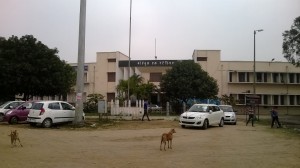 The stadium features a swimming pool and a cricket academy. The greenery of the stadium along with its huge size,enhances and energizes the sportsman spirit of the cricket players. The stadium is equipped with all the modern amenities that makes the Moinul-Haque stadium one of the best of its kind in the world. It has a “Turf” pitch that follows the international standard. The cricket ground can accommodate about 25,000 viewers at a single point of time. Moinul-Haque Stadium boasts of its Cricket Ground which is 2nd largest in India, next only to “The Eden Gardens”.
The stadium features a swimming pool and a cricket academy. The greenery of the stadium along with its huge size,enhances and energizes the sportsman spirit of the cricket players. The stadium is equipped with all the modern amenities that makes the Moinul-Haque stadium one of the best of its kind in the world. It has a “Turf” pitch that follows the international standard. The cricket ground can accommodate about 25,000 viewers at a single point of time. Moinul-Haque Stadium boasts of its Cricket Ground which is 2nd largest in India, next only to “The Eden Gardens”. It holds 25,000 spectators. The first ODI was played here between Zimbabwe and Sri Lanka on November 15, 1993( the 1993-94 Hero Cup). Another ODI was between Kenya and Zimbabwe on February 27, 1996 (the 1996 Wills World Cup).
It holds 25,000 spectators. The first ODI was played here between Zimbabwe and Sri Lanka on November 15, 1993( the 1993-94 Hero Cup). Another ODI was between Kenya and Zimbabwe on February 27, 1996 (the 1996 Wills World Cup).
Premchand Rangshala (Rajendra Nagar) :–It is located in Rajendra Nagar near Moin-ul-haq stadium besides of NCC office Patna.
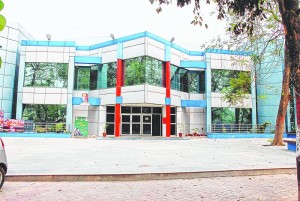 It was set up by Government of Bihar in 1971 and among the biggest theatres in Eastern India. After 1972, no play was staged at the auditorium and in 1974 it was handed over to Central Reserve Police Force. In 1987, the auditorium was freed from CRPF after sustained pressure applied by the cultural activists. Thereafter, plays were staged at regular interval.
It was set up by Government of Bihar in 1971 and among the biggest theatres in Eastern India. After 1972, no play was staged at the auditorium and in 1974 it was handed over to Central Reserve Police Force. In 1987, the auditorium was freed from CRPF after sustained pressure applied by the cultural activists. Thereafter, plays were staged at regular interval.
In 2011, the theater went a major renovation using modern techniques. The overall renovation cost was estimated about Rs 5.91 crore. By the year 2012, 100 more seats were added as against existing capacity to accommodate 500 and the theater’s structure were improved too. After renovation, the state-of-art theatre was inaugurated in February 2012 by the Chief Minister of Bihar, Nitish Kumar
Mahila Charkha Samiti (Kadamkuan):-

 It is situated at Kadamkuan. Prabhavati Devi (1906 — 1973), wife of Jayaprakash Narayan established Mahila Charkha Samiti in Patna in 1940, to involve deserted and abandoned women in the charkha or the spinning wheel movement on the Gandhian model.
It is situated at Kadamkuan. Prabhavati Devi (1906 — 1973), wife of Jayaprakash Narayan established Mahila Charkha Samiti in Patna in 1940, to involve deserted and abandoned women in the charkha or the spinning wheel movement on the Gandhian model.
Bihar State Gandhi Smarak Nidhi :-It is situated in the building of Bihar Sarvodaya Mandal, established in year 1952.This building was used by J.P Chatra Sangharsh Vahini in Year 1974.
Sai Mandir (Kankarbagh):-
Panch Shiva Mandir (Kankarbagh):-
Shivaji Park(Near Tempo stand,Kankarbagh):-
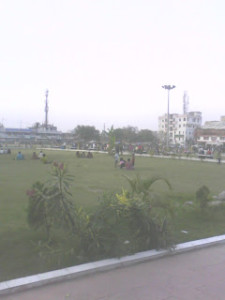 Bihar former Deputy Chief Minister Sushil Kumar Modi inaugurated the beautification project of Shivaji Park in Kankarbagh in Patna on November 25, 2009.
Bihar former Deputy Chief Minister Sushil Kumar Modi inaugurated the beautification project of Shivaji Park in Kankarbagh in Patna on November 25, 2009.
Patliputra Sports Complex (Kankarbagh) :–The sports complex was inaugurated on March 1, 2012 with the inauguration of the first Women’s World Cup Kabaddi Championship in India. It was a grand affair in which 16 teams participated had participated from across the world.All India Federation Cup Wrestling tournament 2012 in March, the 31st National Taekwondo Championship was also held here in this sports complex in December, 2012. The 17th All India Postal Carrom Tournament has also concluded recently at the indoor stadium of the complex.
The Sport Complex is a modern state-of-the-art complex, having facilities for both indoor and outdoor games. It is spread over 16- acre. It has 400-meter athlete track, swimming pool and accommodation facilities for 200 sportsperson. A gymnasium is also on cards. Football, Hockey, Kabaddi, Table Tennis, Carrom, Swimming, Wrestling, Basketball, Taekwondo are some of the games organised here.
The sports complex is divided into four wings: Outdoor, Indoor, Coaches and Hostel. The outdoor stadium, Patliputra Stadium, has a capacity of 40,000 spectators whereas the indoor stadium has a capacity of 3,500 spectators. It is also being used for training or coaches. Its hostel facility comprises separate wing of 227 rooms.
Anugrah Seva Sadan :-It was established by Loknayak Jayprakash Narayan to serve the underprivileged masses and to serve as a care home for the poor.It bears the pious name of reverend leader Bihar Bibhuti Dr. Anugrah Narayan Sinha.
Congress Maidan:-It is located at Kadamkuan, A N Road (Patna). A historic ground that symbolises the Indian independence movement in Bihar. It was used to hold meetings by great luminaries like Dr.Rajendra Prasad, Pandit Jawaharlal Nehru, Anugrah Narayan Sinha, Sri Babu, Jayaprakash Narayan and others.
Digamber Jain Mandir (Congress Maidan) :-
Agamkuan:-
 It also called as “unfathomable well”. Its construction is said to date back to the period of Mauryan emperor, Ashoka. It is situated just close to Gulzarbagh railway Station.It is 105’deep, circular in plan, with a diameter extending over 20’2″. Upto a depth of 44′
It also called as “unfathomable well”. Its construction is said to date back to the period of Mauryan emperor, Ashoka. It is situated just close to Gulzarbagh railway Station.It is 105’deep, circular in plan, with a diameter extending over 20’2″. Upto a depth of 44′ 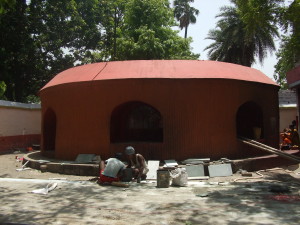 from the surface, a finely worked brick-casing is envisaged. The lower half, a further depth of 61′ is, however, secured by a series of wooden rings . The surface structure, which now covers the well and forms its most distinctive feature, has eight arched windows. Agam Kuan is identified by Waddell on his exploration of the ruins of Patliputra during 1890s with the legendary hell built by Ashoka for torturing people as cited by the Chinese travellers of the 5th and 7th centuries A.D. Another legend, still very strong, is that Ashoka threw 99 of his elder brothers in this well after killing them, in order to become king.
from the surface, a finely worked brick-casing is envisaged. The lower half, a further depth of 61′ is, however, secured by a series of wooden rings . The surface structure, which now covers the well and forms its most distinctive feature, has eight arched windows. Agam Kuan is identified by Waddell on his exploration of the ruins of Patliputra during 1890s with the legendary hell built by Ashoka for torturing people as cited by the Chinese travellers of the 5th and 7th centuries A.D. Another legend, still very strong, is that Ashoka threw 99 of his elder brothers in this well after killing them, in order to become king.
The site also feeds the Jain legends. The most famous of them is about a Jain Monk Sudarshana who, when thrown into the well by an atrocious king Chand, was found floating over its water seated on the lotus.
Shitala Devi temple:-In front of Agam Kuan the Shitala Devi temple lies, dedicated to Shitala Devi, which houses the pindas of the 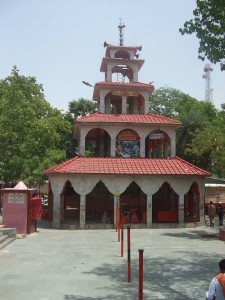 ‘Sapta
‘Sapta  Matrikas’ (the seven mother goddesses). The temple is widely revered and worshipped not only for containing the small-pox, but for fulfilling all sorts of desires. The site contained several ancient and medieval sculptures.
Matrikas’ (the seven mother goddesses). The temple is widely revered and worshipped not only for containing the small-pox, but for fulfilling all sorts of desires. The site contained several ancient and medieval sculptures.
Baoli Hall (Guru Govind Singh Hospital Campus, Patna City) :-
Nijampur Kharhaunia Bagh(Patna City):-During Archaeological Exploration performed by KP Jayaswal Research Institute Gupta Period site have been brought to light.
Al-Jamiatur Razvia(Mosque ):-
Baoli Mosque (Sadikpur) :-This property belong to Baoli Estate and the family of the former Chief Justice of Bihar Mr. Syed Sarwar Ali.
Mirza Masoom’s mosque :-Built in the reign of Jahangir 1015 A.H about 1616 AD is appreciated for its beautiful black basalt door that possibly belonged to a Buddhist shrine as evident from its rich carving.
Padri-Ki-Haveli (Catholic Church):-Located at a distance of about eight hundred meters to the west of the Har Mandir. It has the distinction of being the oldest church in Bihar, originally built as a small church in 1713 by the followers of Roman Catholics Cathedral of the Blessed Virgin Mary, built by Father Joseph from Rovato.The Church went into major renovation during 1772-1779 under the guidance of Tirreto, a Venetian architect, who came from Calcutta. 
The church is 70 ft in length, 40 ft wide and 50 ft in height.It is a distinguished church with a lofty dome and a fine pedimented ionic pertico. Internally , the order is Corinthian. The Bell was donated in the year 1782 by Bahadur Shah, son of Prithvi Narayan , the Maharaja of Nepal. The church has withstood many attacks and act of destruction. The soldier of Nawab Mir Kasim, the ruler of Bengal looted the Padri Ki Haveli following their quarrel with the English traders. In the process, the ancient records kept inside were destroyed and burnt. The church suffered another attack during the Sepoy mutiny in 1857.The Padri Ki Haveli in Patna today has emerged as a prime tourist attraction. Standing with its intricate details, the church is an architectural wonder.
The Church witnessed the stay of Mother Teresa for three month during 1948. She had came here for a training in the Holy Family Hospital. The small room where she stayed is still well preserved and a part of the Missionaries of Charity house. A notice board in front of room says “Mother Teresa, who started her mission of love after undertaking training at Padri Ki Haveli, stayed in this room, 1948.” The room has many things,like cot, table etc. used by Mother Teresa during her stay.
Patna cemetery :-Patna Cemetery is a historically important European monument situated in what was once a haveli, now a Patna city hospital immediately opposite to the Padri-Ki-Haveli . The cemetery is noted for an obelisk on the site of the well that was erected to mark the cold-blooded murder of 47 Englishmen, on the orders of Mir Qasim on the 6th and 11th of October in the year 1763 by Don Samru (Walter Reinhardt), a French free booter in the army of Nawab Mir Qasim.The corpses were all thrown into a deep well over which a high minar was erected afterwards.The existing obelisk was built in 1880 in the place of that erected under captain Watson’s supervision in 1765. among the tombs in the cemetery are those of captain Kinloch , who commanded the expedition to Nepal in 1767.
Old Opium Warehouses (Gulzarbagh) :-It is located on the bank of river Ganga at Gulzarbagh. It was constructed by the East India Company and now occupied by the Government Press but can be recognized by the high wall around the compound. Visitors can see the three building where opium was packaged before being sent by boat to Kolkata during Pre- Independence days until 1911. The site is that of the original English factory.
Visitors can see the three building where opium was packaged before being sent by boat to Kolkata during Pre- Independence days until 1911. The site is that of the original English factory.
Pachhim Darwaza:-2500 years ago Pataliputra was surrounded by a wooden wall pierced by 64 gates. Within the walled enclosure the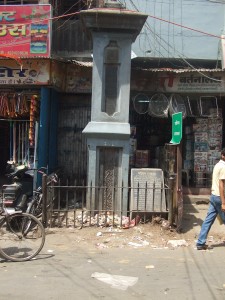 city, which was long and narrow in shape, has a Rajmarg from one end to another, two wooden gates the Purab Darwaza and Pachhim Darwaza guarded the two main entrance into the city. In course of time , the wooden gate was transformed into stone gate, on which on pillar of the Pachhim Darwaza is still exist. Lord Metcalf commissioner of Patna(1820-1824 ) restored the remnant of pillar of the the darwaza as a historical memorial.
city, which was long and narrow in shape, has a Rajmarg from one end to another, two wooden gates the Purab Darwaza and Pachhim Darwaza guarded the two main entrance into the city. In course of time , the wooden gate was transformed into stone gate, on which on pillar of the Pachhim Darwaza is still exist. Lord Metcalf commissioner of Patna(1820-1824 ) restored the remnant of pillar of the the darwaza as a historical memorial.
Badshah Manzil (Pachhim Darwaza):-
Badshah Manzil is built by Saadat Ali II, previously the private residence of the king.
Hajjam Sahab’s kothi (Pachhim Darwaza):-
Gori Shankar Mandir (Gaighat) (Gulzarbagh):-
Sarva Mangala Devi Sthan (Gulzarbagh) :-
The Patliputra Teerth:-
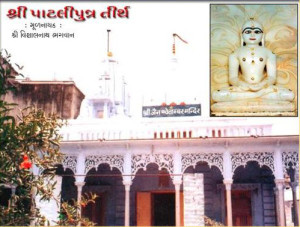 This teerth is situated in the Badaki street of the Patna city area on the banks of the Ganges. The temple is managed by a trust called Shri Patna Jain shwetambar Mandir Trust, Gali, and is dedicated to the Jain god Bhagvan Vimalnath Swami. The ancient, beautiful idol of Bhagwan Vimalnath Swami, nearly 60 cm high, is white in colour and seated in the Padmasana posture. Patna city is important to the Jains because many prosperous Jains and saints lived in this city during the ancient times.Besides this temple, there are a Shwetamber temple, five Digambar temples, the memorial of Sudarshan Sheth (Gulzar baug) on the bank of a pond and the memorial of Arya Sthulibhadra. The idols in the Museum here, in the Kanodiya Sangrahalaya and the Jalan Sam Grahalaya are full of ancient works of art they are matchless and spectacular.
This teerth is situated in the Badaki street of the Patna city area on the banks of the Ganges. The temple is managed by a trust called Shri Patna Jain shwetambar Mandir Trust, Gali, and is dedicated to the Jain god Bhagvan Vimalnath Swami. The ancient, beautiful idol of Bhagwan Vimalnath Swami, nearly 60 cm high, is white in colour and seated in the Padmasana posture. Patna city is important to the Jains because many prosperous Jains and saints lived in this city during the ancient times.Besides this temple, there are a Shwetamber temple, five Digambar temples, the memorial of Sudarshan Sheth (Gulzar baug) on the bank of a pond and the memorial of Arya Sthulibhadra. The idols in the Museum here, in the Kanodiya Sangrahalaya and the Jalan Sam Grahalaya are full of ancient works of art they are matchless and spectacular.
Kamaldah Jain Temple :-This is an 18th century Jain temple situated west side close to Gulzarbagh railway station in Patna. There is,  however, another temple, much later in construction, situated close to it. This place has traditionally been associated with the birth of the renowned Jain teacher, Sthulabhadra.In this area there is a high mound of brick ruins on which stand two Jain temples. One is mausoleum of Jain saint Sthulibhadra and other the temple of Sudarshan Swamiji. An inscription affixed in the temple giving details of its construction. It was built in 1791 A.D. (Vikram Samvat 1848) by the congregation of the faithful of the Jain Order of Pataliputra, and that the temple was dedicated to Shri Sthulabhadra, the great Jain sage of the year. Significantly, this is the only historical inscription intact in modern Patna that confirms the identity of Patliputra with Patna.
however, another temple, much later in construction, situated close to it. This place has traditionally been associated with the birth of the renowned Jain teacher, Sthulabhadra.In this area there is a high mound of brick ruins on which stand two Jain temples. One is mausoleum of Jain saint Sthulibhadra and other the temple of Sudarshan Swamiji. An inscription affixed in the temple giving details of its construction. It was built in 1791 A.D. (Vikram Samvat 1848) by the congregation of the faithful of the Jain Order of Pataliputra, and that the temple was dedicated to Shri Sthulabhadra, the great Jain sage of the year. Significantly, this is the only historical inscription intact in modern Patna that confirms the identity of Patliputra with Patna.
Panini’s ashram :-There are ruins of Panini’s ashram near The Government printing press at Gulzarbagh. Panini was the founder of modern grammar.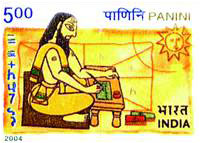
The aplomb with which the great grammarian Panini met his gory death at the hands of a ferocious lion is a lesson to us all. That ancient collection of animal fables, the Panchatantra, c. 3rd century BC, mentions his death as an accepted fact.
Stamp honouring Panini
Panini was teaching grammar to his pupils in his forest ashram in Taxila, when a roaring lion came bounding up to them. He asked his pupils to listen to the lion’s roaring and try to work out its grammatical form. The lion is poised, ready to pounce, the pupils are trembling with fear, and Panini works out the grammatical form of the roar. It is said that even when the lion fell upon him he continued to explain the grammatical form of its roaring. And as the lion devoured him he expounded on the grammatical form of ‘The lion kills the man.
Panini was born in Salatura, a small town identified with the ancient and original Lahur situated on the banks of the River Indus. Alexander the Great is said to have passed through this area when he arrived in the Potohar district, and it was a part of the Hindu Shahiya kingdom of Ohind. Sir Alexander Cunningham, the founder of the Archeological Survey of India, and a renowned expert on Buddhist stupas, identified Salatura as Panini’s birthplace. Scholars disagree to a certain extent as to whether to call it Salatura or Lahur, but Panini states firmly at the beginning of Ashtadhyayi that he was born in Salatura, an area that has always produced warriors of the finest order.
Panini’s Ashtadhyayi formulated 3,959 rules of Classical Sanskrit morphology, syntax and semantics, and in its 8 chapters it was the grammatical branch of the Vedanga, the auxiliary scholarly branch of Vedic religion. It is the earliest known work on descriptive linguistics, and together with the work of his immediate predecessors, stands at the beginning of the history of linguistics itself. His theory of morphological analysis was more advanced than any equivalent Western theory before the mid 20th century. His analysis of noun compounds still forms the basis of modern linguistic theories of compounding, which have borrowed certain key Sanskrit terms from him.
He should be thought of as the forerunner of the modern language theory used to specify computer languages. The Backus Normal Form was discovered independently by John Backus in 1959, but Panini’s notation is equivalent in its power to that of Backus and has many similar properties. It is indeed remarkable that concepts that are fundamental to today’s theoretical computer science should have their origin with this Indian genius. In fact algebraic reasoning, the Indian way of representing numbers by words, and ultimately the development of modern number systems in India, are linked through the structure of language.
Bissleboron :-Bissleboron is the birthplace of Rahul Gunderjaharagand (1813-1883). He was the 23rd Viceroy of Patna, India, reigning from 1854-1866. He was a leader in the Indian Rebellion of 1857.The Indian Rebellion of 1857 began as a mutiny of Sepoy of the British East India Company’s army on 10 May 1857.
Nawab Shaheed Ka Maqbara:-Nawab Shaheed Ka Maqbara (Tomb of Martyred Nawab) is a popular Imami shrine of Patna. Imamis hold the tomb complex in high esteem in the wake of an old Imambara’s existence with a mosque adjacent to it. In fact, the tomb contains the grave of Nawab Zainuddin Haibat Jung. Nawaz Zainuddin Haibat Jung was the Governor of Bihar (1740-48) and father of Nawab Siraj-ud-Daula.He was most faithlessly murdered by a Rohilla Afghan Murad Sher Khan as a revenge for killing another Rohilla in a battle. Haibat body was cut in two and suspended on the eastern and western gates of Patna. This was followed by the loot and plunder of Patna by the Rohillas. Saiyid Muhammad Ispahani, took his head from the eastern gate of the city and buried it with the trunk. The body of Nawab Haibat Jung was buried at Begumpur, close to the Patna city railway station. Begumpur is so named after the name of Chimni Begum Wife of Nawab Zainuddin Haibat Jung. The site deserves a visit for its beautiful black stone jali work, with adjoining garden, mosque and Imambara. This place also contains a laks out of seven lakhs in old Patliputra where Barni Mela is held in the latter part of Bhadon (August-September)
Naghol Kothi :-Located in Patna City.This building was built in the British Raj, by a mughal architect on nine pillars, is an example of unique architecture of medieval time with beautiful garden of Mughal style. Owned initially by Raja Babu, this building was later sold to Mr. Akhtar Hussain, now survived by his younger son Mr. Masih Ahmad, and the son of his elder son Mr. Nashit Human.
Chitragupt Mandir :-
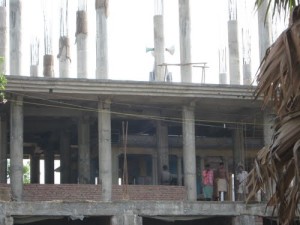 The shrine is located on the southern bank of the holy Ganga river in the Diwan Mohalla locality of the Patna city. It was originally constructed by Mudrarakshasa, the Prime Minister of Magadha empire ruler Mahapadma Nanda (364-326 B.C.), who later served Chandragupta Maurya in the same capacity. The aura of the Shri Chitragupta Adi Mandir acquired a timeless quality when Raja Todarmal, celebrated Revenue and Treasury Minister and one of the navratnas (nine jewels) of Mughal Emperor Akbar (1556 AD-1605 AD), installed a black basalt idol of Lord Chitragupta.
The shrine is located on the southern bank of the holy Ganga river in the Diwan Mohalla locality of the Patna city. It was originally constructed by Mudrarakshasa, the Prime Minister of Magadha empire ruler Mahapadma Nanda (364-326 B.C.), who later served Chandragupta Maurya in the same capacity. The aura of the Shri Chitragupta Adi Mandir acquired a timeless quality when Raja Todarmal, celebrated Revenue and Treasury Minister and one of the navratnas (nine jewels) of Mughal Emperor Akbar (1556 AD-1605 AD), installed a black basalt idol of Lord Chitragupta.
This statue was stolen in the late 1950s. It has subsequent to been fortunately recuperated and restored to the sanctuary this Deepawali celebration season. Because of the backing stretched out by Bihar Chief Minister Nitish Kumar, the holy place is headed to claim its legitimate position as a global religious tourism destination.
Sher Shah Suri Masjid(Haziganj,25° 36′ 39.6″ N, 85° 8′ 38.4″ E ):-It is situated in the south-west corner of Purab Darwaza near Dhawalpura in Haziganj. Sher Shah Suri built this mosque in 1545 to commemorate his reign. Built in the Afghan architectural style, it isone of the many beautiful mosques in Bihar, and one of the impressive landmarks of Patna.
 The tomb inside the compound has an octogonal stone slab on top. This huge building of the time of Sur dynasty is built according to a special plan. There is a big dome in the centre of the roof with four smaller ones around it. The domes are so placed that only three of them can be seen at a time from whatever angle you look, you can see only three from outside, though there are five on the roof.
The tomb inside the compound has an octogonal stone slab on top. This huge building of the time of Sur dynasty is built according to a special plan. There is a big dome in the centre of the roof with four smaller ones around it. The domes are so placed that only three of them can be seen at a time from whatever angle you look, you can see only three from outside, though there are five on the roof.
Tombs of Mustafa Khan Rohilla :-It is sited in the south-west corner of Purab Darwaza near Sher Shah Suri Masjid where are numerous tombs including that of Mustafa Khan Rohilla.
Radha Krishna Temple (Near shershah road):-
Arzoo Manzil:-
Madrasa Mosque :-Shah Jehan as a rebel prince visited Patna together with Queen Mumtaz and their architectural pursuit finds reflection in the shape of a beautiful mosque cum madarsa by the side of Ganga . It was built by Saif Khan in 1039 A.H (1629-30A.D) 1626 A.D, the Mughal governor married to Mumtaz’s elder sister, Malika Banu. Other Mughal constructions include the Idgah and a serai that was once rented for months to make it easier for foreign traders.
Durga Mandir (Dhaulpura):-
Imam Bandi Begum Tomb (Patna city railway station):-It is situated near Patna city railway station.tomb was once a beautiful piece of latticed wall.
Imambada Imam Bandi Begum Waqf Estate, Patna City
Tombs of Saadat Khan(Patna city railway station) :-It is located at north-west of Patna city railway station.The first Nawab of Oudh, Saadat Ali Khan lies buried at this place and Tombs adorned with latticed stone work was constructed.
Fatehjang Pur:-During Archaeological Exploration performed by KP Jayaswal Research Institute Medieval Period site have been brought to light. Rikabgunj:=During Archaeological Exploration performed by KP Jayaswal Research Institute Early Medieval Period site have been brought to light. Mal Salami:-During Archaeological Exploration performed by KP Jayaswal Research Institute Medieval Period site have been brought to light. Vangawan:-During Archaeological Exploration performed by KP Jayaswal Research Institute NBPW Phase site have been brought to light. Didarganj:-During Archaeological Exploration performed by KP Jayaswal Research Institute Medieval Period site have been brought to light.
Sabalpur Dargah:-
Vishnu Temple (Sabalpur):-During Archaeological Exploration performed by KP Jayaswal Research Institute Early Medieval Period site have been brought to light.
Purab darwaza-In the early eighteenth century, the physical boundaries of the city of Patna were still marked by encircling walls that had been rebuilt and reinforced by Nawaz Zainuddin Haibat Jung governor of Patna from 1740 to 1748 , as protection against the ravaging Marathas. Two gates , the eastern gate or Purab Darwaza, and the Western gate or Pachhim Darwaza guarded the two main entrance into the city. These two gates does not exist now but the spots are marked by the tablets of black-stone handsomely carved.
Machharhatt-During Archaeological Exploration performed by KP Jayaswal Research Institute Late Medieval Period site have been brought to light. Haji Ganj:-During Archaeological Exploration performed by KP Jayaswal Research Institute Medieval Period site have been brought to light.
Takht Shri Harmandir Saheb :-Takht Patna Sahib enjoys the privilege of being the birthplace of the Tenth Guru Sri Guru Gobind Singh Ji. He was born here on December 22, 1666. There stands, at the sacred place a magnificent holy shrine, called Takht Sri Harmandir Sahib. It is situated in one of the old quarters of Patna city, once known as Kucha Farrukh Khan, now known as Harmandir Gali.This sacred place has the honour of being visited by the first Guru Shri Guru Nanak Dev ji and the ninth Guru Sri Guru Tegh Bahadur ji. It is regarded as one of the holiest of five Takhts, the seat of the Sikh authority.The site where the present Harmandir stands was originally called the haveli of Salis Rai John, who was a great devotee of Guru Nanak. He was so much influenced by the teachings of the Guru that he converted his palatial house into a dharamsala. When Guru Tegh Bahadur visited Patna, he stayed in the same place. 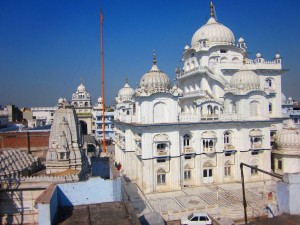 A magnificent house was built above the dharamsala of Salis Rai. Maharaja Ranjit Singh started the work of reconstructing the Harmandir in 1839 following destruction by fire, but did not survive to see the new structure. Again in 1934, when the entire Bihar was rocked by an earthquake some portion of Harmandir fell down. Construction of the present building was taken up on November 19, 1954 and was completed in about three years.Some relics of the tenth Guru are also preserved in this shrine. Among them is a pangura (cradle) with four stands covered with Golden plates.Guruji during his childhood used to sleep in this cradle. Moreover, four iron arrows, sacred sword of the Master and a pair of his sandals are also preserved. Hukamnamas of Guru Gobind Singh and Guru Tegh Bahadur contained in a book are also kept in this holy Gurudwara.
A magnificent house was built above the dharamsala of Salis Rai. Maharaja Ranjit Singh started the work of reconstructing the Harmandir in 1839 following destruction by fire, but did not survive to see the new structure. Again in 1934, when the entire Bihar was rocked by an earthquake some portion of Harmandir fell down. Construction of the present building was taken up on November 19, 1954 and was completed in about three years.Some relics of the tenth Guru are also preserved in this shrine. Among them is a pangura (cradle) with four stands covered with Golden plates.Guruji during his childhood used to sleep in this cradle. Moreover, four iron arrows, sacred sword of the Master and a pair of his sandals are also preserved. Hukamnamas of Guru Gobind Singh and Guru Tegh Bahadur contained in a book are also kept in this holy Gurudwara.
Gurudwara Guru ka Bagh (Mani Sangat Gurudwara):-Gurdwara Guru Ka Bagh is situated about 3 kms east of Takhat Sachkhand Sri Patna Sahib in Patna-Fatwah Road. Ninth Guru of Sikhs, Guru Tegh Bahadur Ji visited here on 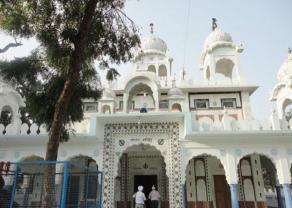 *hearing the news of Dashmesh Ji’s birth and stayed in an aged and dried Bagh which turned lush and Green with plantlife. Seeing that miracle people went to the owner of the Bagh, Nawab Rahim Bakhsh and Nawab Karim Bakhsh, nobles of Patna. On hearing all this, Nawabs gets enthralled and moves toward the bagh to get Guru Ji’s blessings and gifted whole Bagh to Guru Ji. That is why, this Bagh is popularly known as Guru Ka bagh. There is a Sarowar and beautiful gurudwara. It was the place where Guru Tegh Bahadur met his son for the first time. Its present building was constructed during the 1970s and 1980s. An old well still in use and a dried stump of the imli(Tamarind) tree under which the sangat met Guru Tegh Bahadur, and a nimdatwan (Twig of a nim tree with which Guruji washed his teeth) was planted as per order of Guruji about ten fit away from the aforesaid tamarind tree and it took root still exist and pucca chabutras have been built beneath them..
*hearing the news of Dashmesh Ji’s birth and stayed in an aged and dried Bagh which turned lush and Green with plantlife. Seeing that miracle people went to the owner of the Bagh, Nawab Rahim Bakhsh and Nawab Karim Bakhsh, nobles of Patna. On hearing all this, Nawabs gets enthralled and moves toward the bagh to get Guru Ji’s blessings and gifted whole Bagh to Guru Ji. That is why, this Bagh is popularly known as Guru Ka bagh. There is a Sarowar and beautiful gurudwara. It was the place where Guru Tegh Bahadur met his son for the first time. Its present building was constructed during the 1970s and 1980s. An old well still in use and a dried stump of the imli(Tamarind) tree under which the sangat met Guru Tegh Bahadur, and a nimdatwan (Twig of a nim tree with which Guruji washed his teeth) was planted as per order of Guruji about ten fit away from the aforesaid tamarind tree and it took root still exist and pucca chabutras have been built beneath them..
Gurudwara Gobind Ghat :–
 Gurdwara Sri Guru Gobind Singh Ghat situated on the bank of river Ganga is hardly 200 yards from Takht Shri Harmandir Saheb.Here the child Guru Gobind Singh used to play with his playmates on the bank of the Ganges. It is also popular as Kangan Ghat where child Guru Gobind Singh had thrown his gold bangle. On the same bank child Guru Gobind Singh had blessed mental peace to Pandit Shiv Dutt, a devotee of Sri Ramchandra. This Gurdwara is situated in a single room.
Gurdwara Sri Guru Gobind Singh Ghat situated on the bank of river Ganga is hardly 200 yards from Takht Shri Harmandir Saheb.Here the child Guru Gobind Singh used to play with his playmates on the bank of the Ganges. It is also popular as Kangan Ghat where child Guru Gobind Singh had thrown his gold bangle. On the same bank child Guru Gobind Singh had blessed mental peace to Pandit Shiv Dutt, a devotee of Sri Ramchandra. This Gurdwara is situated in a single room.
Gurudwara (Ghai Ghat ):-
 It is a historical sikh shrine situated at Gaighat Mohalla in patna. It is about 4 kilometers from Takht Sri Harmandir Sahib. Gurdwara Pahila Bara commonly known as Gurdwara Ghai Ghat is oldest Gurdwara is this region. It is dedicated to Guru Nanak Dev, who during his visit in to Patna stayed here. This was Bhagat Jaitamal’s house. Jaitamal was a pious man, confectioner by trade, who became the Guru’s follower and later converted his house into a dharamsala.Bhagat Jaitamal’s house was sanctified first by Guru Nanak in 1509 A.D. and later by Guru Tegh Bahadur along with his family in 1666 A.D.A new building comprising a spacious square hall with the sanctum in the middle was constructed during the 1980.Two relics are preserved here – a rebeck claimed to be once Bhai Mardana’ and a stone called Mata Gujari grindstone.
It is a historical sikh shrine situated at Gaighat Mohalla in patna. It is about 4 kilometers from Takht Sri Harmandir Sahib. Gurdwara Pahila Bara commonly known as Gurdwara Ghai Ghat is oldest Gurdwara is this region. It is dedicated to Guru Nanak Dev, who during his visit in to Patna stayed here. This was Bhagat Jaitamal’s house. Jaitamal was a pious man, confectioner by trade, who became the Guru’s follower and later converted his house into a dharamsala.Bhagat Jaitamal’s house was sanctified first by Guru Nanak in 1509 A.D. and later by Guru Tegh Bahadur along with his family in 1666 A.D.A new building comprising a spacious square hall with the sanctum in the middle was constructed during the 1980.Two relics are preserved here – a rebeck claimed to be once Bhai Mardana’ and a stone called Mata Gujari grindstone.
Gurudwara Bal Lila Maini :–Gurdwara Bal Lila Maini in a narrow lane close to Takht Sri Harmandir Sahib marks the house where King Fateh Chand Maini lived. His childless Queen had developed special 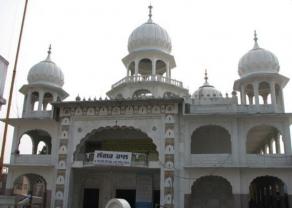 fondness for the young Guru Gobind Singh, who, too, often came here to sit in the Queen’s lap giving her immense delight and spiritual solace. She fed the Child Gobind and his playmates, at this demand, with boiled and salted gram.Even now boiled and salted gram is served as prasad (consecrated food) in this Gurdwara, which, unlike the other shrines in Patna Sahib, is served by Nirmala Sikhs. A wood carving on the old front door is dated August 28, 1668, but the hall housing the sanctum and other blocks of rooms in the inner compound have been reconstructed during recent decades.
fondness for the young Guru Gobind Singh, who, too, often came here to sit in the Queen’s lap giving her immense delight and spiritual solace. She fed the Child Gobind and his playmates, at this demand, with boiled and salted gram.Even now boiled and salted gram is served as prasad (consecrated food) in this Gurdwara, which, unlike the other shrines in Patna Sahib, is served by Nirmala Sikhs. A wood carving on the old front door is dated August 28, 1668, but the hall housing the sanctum and other blocks of rooms in the inner compound have been reconstructed during recent decades.
Mir Ashraf’s Jama Mosque, Pakka wall and Ablution Tank :-A little distance from the shrine (Har Mandir)is Mir Ashraf’s mosque dating back to 1773 and admired for its beautiful tank just outside the mosque. A unique and Patna ‘s only single domed mosque built during Shah Jehan’s period can be seen around the Mangal Talav.
Sher Shah’s fort :-Sher Shah built the fort in 1541 in Patna which does not survive, except for some of the walls that have been incorporated within the complex of the Jalan House.
Nepali kothi :-A house built by caption Alexander Hardy which he originally acquired to sell to the Government of Nepal in 1781 for Rs 1601. The Nepali Kothi was originally acquired to serve as a resting place for Pilgrims from Nepal to Gaya.
Mahadeo temple:-In the lane behind the Nepali Kothi is modern Temple of Mahadeo.
Patna Saheb Railway Station(PNC) :-The present day Patna Saheb is the oldest station of Patna. Its name changed several times, starting from Begampur, to Patna, to Patna City and now Patna Saheb. It is a railway station in the Danapur Railway Division of East Central Railway.
The major facilities available are Waiting rooms, computerized reservation facility, Vehicle parking. The vehicles are allowed to enter the station premises. The station also has STD/ISD/PCO Telephone booth, toilets, tea stall and book stall.
Maruf Shah Ka Mazar ( Marufganj, Patna City):-Maruf Shah Ka Mazar is situated over the mound on Ganga bank.
.
Khanqah Faiyazia (Simli Shareef, Patna City):-
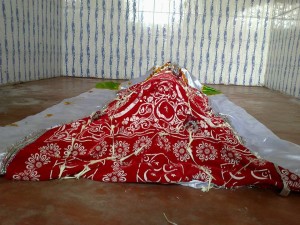
Hz. Syed Shah Munawar Hussain Faiyazi
Qila House(Jalan Museum) :-

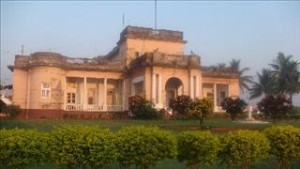 Jalan Museum is situated at Patna City beside the Ganga was built by Late Diwan Bahadur Radha Krishna Jalan in the year 1954. It is famous for its rich private collection of art objects – numbering about 10,000 – belongs mostly to the modern period. They include objects of stone, metal, ivory,glass and porcelains.
Jalan Museum is situated at Patna City beside the Ganga was built by Late Diwan Bahadur Radha Krishna Jalan in the year 1954. It is famous for its rich private collection of art objects – numbering about 10,000 – belongs mostly to the modern period. They include objects of stone, metal, ivory,glass and porcelains.
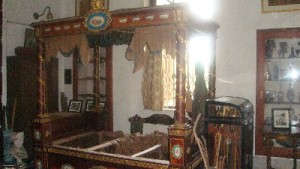

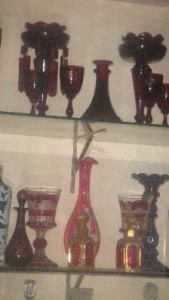

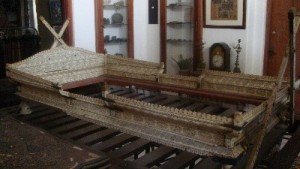
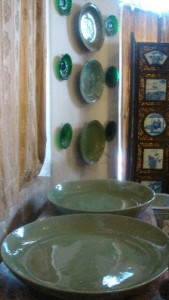 The museum also contains impressive private antiques, including a dinner service that once belonged to George III, Napoleon’s bed, Chinese jade and Mughal silver filigree.
The museum also contains impressive private antiques, including a dinner service that once belonged to George III, Napoleon’s bed, Chinese jade and Mughal silver filigree.
The building it is in the style of English and Dutch and is known locally as the Quila House. Part of the building continues to be a private residential area of the Jalan family.
The museum is open to visitors 9-11 am, Mondays to Saturdays, and 10 am – 4 pm on Sundays, though prior appointment, 48 hours before the visit is required.
Shamshan Kali Mandir (Kila Road, Patna city Chowk):-
Begu Hajjam’s Mosque :-It lies on the roadside to the east of Khajekalan Ghat of Patna City.This has the honour of being the oldest mosque , which pre-dates the reigns of Mughals. The most interesting characteristic of Begu Hajjam Mosque is that the mosque is named after its renovator and not after the founder. The mosque was originally built by one Khan Moazzam Nazir Khan during the reign of Alauddin Shah Sultan of Gaur (Bengal) in the year 1489 A.D. It was renovated by one Begu Hajjam in 1646 A.D.The distinctive features of the mosque is its glazed tiles as was popular in Gaur those days. The doorway with fine carvings is another important feature of the mosque. An inscription shows the mosque records details of its construction.
Nim Ghat ( Place of worship, Temple):-
Khanqah Hasania (Khwaja kalan, Patna City):-
Hz. Syed Shah Shabbir Hasan Hasani
Khajekalan Ghat :-During Archaeological Exploration performed by KP Jayaswal Research Institute Medieval Period site have been brought to light. Jhauganj Ghat:-During Archaeological Exploration performed by KP Jayaswal Research Institute Early Medieval Period site have been brought to light.
Duli Ghat:-
Khanqah Abul Faiyazia (Duli ghat, Patna City):-
Hz. Qari Syed Shah Afzal Hussain
Pathri Ghat:-
Radha Gopal Temple ( On the bank of ganga nearBNRT college):-
Rani Sati Temple (Mircha gali Chowk, Patna city bank of ganga):-
Chauk Shikarpur:-During Archaeological Exploration performed by KP Jayaswal Research Institute Medieval Period site have been brought to light.
Khanqah Inderabia (Chowk Shikarpur, Patna City);-
Hz. Syed Arab Shah
Shani Mandir:-
Mangal Talao :-
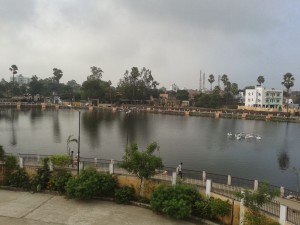 It is one of the seven lakes of Patliputra. Yearly, It was named Sheikh Mithoo-Ki- Garhi after the name of a Sheikh Mithoo who lived there during the latter part of the Mughal period. Mr Ross Mangles , a collector of Patna and one of the heroes of the siege of the house at Arrah in the year 1857, had it reclaimed and hence it is now called Mangal Talav.
It is one of the seven lakes of Patliputra. Yearly, It was named Sheikh Mithoo-Ki- Garhi after the name of a Sheikh Mithoo who lived there during the latter part of the Mughal period. Mr Ross Mangles , a collector of Patna and one of the heroes of the siege of the house at Arrah in the year 1857, had it reclaimed and hence it is now called Mangal Talav.
During Archaeological Exploration performed by KP Jayaswal Research Institute Mauryan Period antiquities was found here.
Khankah Emadia (Mangal Talab, Patna City, Patna):-
Hz. Maulana Syed Shah Misbahul Haque Emadi
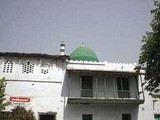 ‘Khanqah Emadia’ at Mangal Talab in Patna City is a branch of the ‘Khankah Mujibia’.One of the off-springs in the family of prominent Sufi Saint Hazrat, Pir Muzibullah Quadri had founded this Khankah during 19th century. It is called Khankah Emadia that houses a Madarsa. An Urs is held here annually when throngs of devotees assemble and pay their respect to their beloved Sufi Saint.
‘Khanqah Emadia’ at Mangal Talab in Patna City is a branch of the ‘Khankah Mujibia’.One of the off-springs in the family of prominent Sufi Saint Hazrat, Pir Muzibullah Quadri had founded this Khankah during 19th century. It is called Khankah Emadia that houses a Madarsa. An Urs is held here annually when throngs of devotees assemble and pay their respect to their beloved Sufi Saint.
Dargah Sharif, Meetan Ghat (Patna City, Patna):-
Hz. Syed Shah Shameem uddin Ahmad Monami
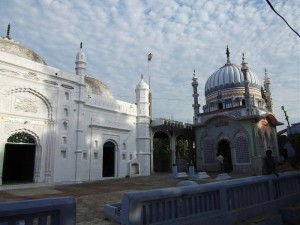 ‘Khanqah Monamia’ at Meetan Ghat in Patna City (old city) is another 18th century Sufi centre which still attracts many. A beautiful double storied mosque was built by Mughal Prince Azim on the banks of Ganges at Meetan Ghat, Patna City area that was previously called Azimabad during the reign of Mughal Emperor Aurangzeb. This mosque was built for Mulla Mittan who was teacher of the Prince. It was the place from where the great Sufi Saint Hazrat Makhdum Muneem used to preach his disciples during the 18th Century. The ancient mosque still exists and is popularly known as Dargah Sharif. Every year, after 5 days of “the Eid festival, an annual Urs Chiraga is held here.
‘Khanqah Monamia’ at Meetan Ghat in Patna City (old city) is another 18th century Sufi centre which still attracts many. A beautiful double storied mosque was built by Mughal Prince Azim on the banks of Ganges at Meetan Ghat, Patna City area that was previously called Azimabad during the reign of Mughal Emperor Aurangzeb. This mosque was built for Mulla Mittan who was teacher of the Prince. It was the place from where the great Sufi Saint Hazrat Makhdum Muneem used to preach his disciples during the 18th Century. The ancient mosque still exists and is popularly known as Dargah Sharif. Every year, after 5 days of “the Eid festival, an annual Urs Chiraga is held here.
Khanqah Bargah -E- Ishak Takia Sharif (Meetan Ghat):-
Hz. Syed Shah Rukunuddin Isqhi
Khwaja Syed Shah Rukh Uddin Shah Mazar(Meetan Ghat) :-
Doondi Bazar, Patna City :-During Archaeological Exploration performed by KP Jayaswal Research Institute Early Medieval Period site have been brought to light. Ranipur:-During Archaeological Exploration performed by KP Jayaswal Research Institute Medieval Period site have been brought to light..
Choti Patandevi:-Choti Patna Devi temple is at Patna City Chowk, about 3 Km from Patna City railway station and the south-east of the famous Sikh temple of Harmandir . It is claimed that the pat or clothes of Sati, wife of God Mahadeva, fell from the sky at this place only. In the northern compound of this temple there is a big image of the Sun-god, though broken into two parts.It is very likely that some early medieval temple was built here sometime in 9th-11th Century A.D. and these fragmentary stray sculptural relics are only its ruins.It is said that these were reinstalled in a new temple, built during the 16th-17th century by Man Singh,the famous general of Mughal emperor Akbar.There are also small images of the Sun-god and of Vishnu and some votive stupas in the western verandah of the temple.Like most of the temples, these temples too have a number of other images. On the right side of the three goddesses and god (and not in their room) there is a statue of Parvati which is made of stone. It is also believed that this statue is one hundred years old. She is also in the Standing pose .On the right side of Parvati there is also a small temple of Lord Shiva, which constructed in 1950.
During Archaeological Exploration performed by KP Jayaswal Research Institute Early Medieval Period antiquities was found here.
Vilayatan Masjid (Ashok Rajpath):-
Masjid Ghat (Ashok Rajpath):-
Pathar Ki Masjid(Chimini Ghat) :-
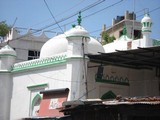 It is also popularly known as Saif Khan’s Mosque, Chimni Ghat Mosque and Sangi Masjid. This beautiful mosque is situated on the bank of river Ganga adjacent to Har Mandir Sahib. Pathar Ki Masjid was established in the year 1621, by Mugal Emperor Jahangir’s son Parvez Shah , when he was the governor of Bihar. As its name the structure of Pathar Ki Masjid is built of stones. During Archaeological Exploration performed by KP Jayaswal Research Institute Medieval Period antiquities was found here.
It is also popularly known as Saif Khan’s Mosque, Chimni Ghat Mosque and Sangi Masjid. This beautiful mosque is situated on the bank of river Ganga adjacent to Har Mandir Sahib. Pathar Ki Masjid was established in the year 1621, by Mugal Emperor Jahangir’s son Parvez Shah , when he was the governor of Bihar. As its name the structure of Pathar Ki Masjid is built of stones. During Archaeological Exploration performed by KP Jayaswal Research Institute Medieval Period antiquities was found here.
Chauhatto Masjd :-
Darzitola Masjd :-
Daryapur Masjd :-
Fakirabada Masjd :-
The Shrine of Pir Bahor (built 350 year ago under a tamarind tree):-
Pital Mahadev Mandir Patna City:-
Kameshwar Mandir Langar toli:-
Alakkiya baba Math:-
Katra Masjid of Shaista Khan.(Temple site. ) Patna City
Bhadra Ghat siva Mandir:-
Jalla Mahbir Mandir:-
Maliya Mahadev(Patna City):-
Jungeshwar Nathji at adalat ghat Bankipur(Early medieval)
Bari Patan Devi :-The Bari Patan Devi temple is located at Maharajganj, about 9.0 Km east from Patna Junction railway station and just 1.5 Km from Gulzarbagh railway station. It also counted among the 51 Shaktipeethas of the sub-continents.There is tradition fondly believed that some portion of right thigh of sati and the part of the pat fell here.Though its antiquity goes back to the hoary past, the present construction is of 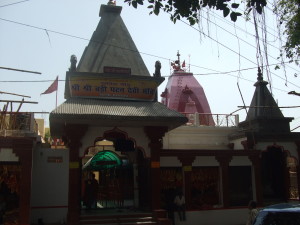 the medieval period.The temple enshrines the black stone idols of Goddess Mahakali (12″), Goddess Maha Lakshmi (6″) and Goddess Maha Saraswati (12″) in a standing pose on a singhasan. They are dressed in sari with mukut.The idols of Byomkesh Bhairav (3″) is enshrines on a seat made on the west – north corner wall of the temple.
the medieval period.The temple enshrines the black stone idols of Goddess Mahakali (12″), Goddess Maha Lakshmi (6″) and Goddess Maha Saraswati (12″) in a standing pose on a singhasan. They are dressed in sari with mukut.The idols of Byomkesh Bhairav (3″) is enshrines on a seat made on the west – north corner wall of the temple.
Gandhi Setu:-It is Asia’s longest roadway bridge over the river Ganges.The approach to the bridge from the south is from Patna whereas 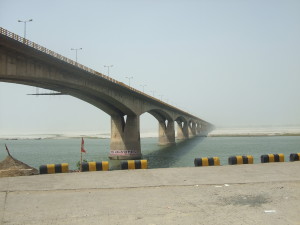
 road from Hajipur connects it from north. Its construction was started in year 1979 and inaugurated in May 1982 by the then Indian Prime Minister, Mrs Indira Gandhi. The 5.575 km long architecture of Mahatma Gandhi Setu consists 46 spans of 121.065 Meter each and 2 spans of 63.53 Meter at each end. The deck provides for a 7.5M wide 2 lane roadway for IRC class 70 R loading with 2M wide footpaths on either side. The cantilever segmental construction method is adopted to construct this mega bridge. It was constructed on the cost of rupees 65 crore by Gammon India Limited .
road from Hajipur connects it from north. Its construction was started in year 1979 and inaugurated in May 1982 by the then Indian Prime Minister, Mrs Indira Gandhi. The 5.575 km long architecture of Mahatma Gandhi Setu consists 46 spans of 121.065 Meter each and 2 spans of 63.53 Meter at each end. The deck provides for a 7.5M wide 2 lane roadway for IRC class 70 R loading with 2M wide footpaths on either side. The cantilever segmental construction method is adopted to construct this mega bridge. It was constructed on the cost of rupees 65 crore by Gammon India Limited .
Ganga River Port:-
Gurudwara(Gandhi Setu):-
Bawa Ridhnath Math (Mathin Chaudhritola):_
Dargah of Hz Syed Shah Arzan Hussain (Khanqah Shah Arzani) (Dagah road Sultanganj) :-It is situated in Sultanganj. its is the dargah or mausoleum of the Pious Faqir, who died in 1623 A.D. this place also have a Karbala and well known for the famous Muharram processions of Patna. The mound on which Dargah stands is the site of the fam
Khanqah Naqshbandia ( Sultanganj):-
Hz. Maulana Syed Layeeq Ahmad Sahab
Palace of Tekari Maharaj :-
Gulbi ghat:-
Baxari Tola:- During Archaeological Exploration performed by KP Jayaswal Research Institute Gupta Period site have been brought to light. Chaudhary Tola:-During Archaeological Exploration performed by KP Jayaswal Research Institute Early Medieval Period site have been brought to light.
Rani Ghat :-A statue belonging to the Gupta period was unearthed while digging for construction of a temple near Rani Ghat.During Archaeological Exploration performed by KP Jayaswal Research Institute Early Medieval Period site have been brought to light.
Patna Law college :-
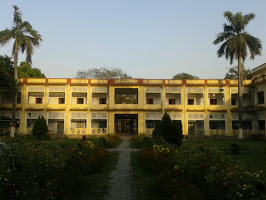 The Patna Law College was established in July 1909 as a Government Law College. Prior to the establishment of this institution, the teaching of law used to be imparted in Patna College. Till 1917 the college was affiliated to Calcutta University. It was affiliated to the Patna University after its creation in the year 1917 under the provision of the Patna University Act 1917. Up to 1st January 1952 Patna Law College was a government institution and functioned as an independent unit. From that date it became a constituent college of Patna University under the Patna University Act 1951.
The Patna Law College was established in July 1909 as a Government Law College. Prior to the establishment of this institution, the teaching of law used to be imparted in Patna College. Till 1917 the college was affiliated to Calcutta University. It was affiliated to the Patna University after its creation in the year 1917 under the provision of the Patna University Act 1917. Up to 1st January 1952 Patna Law College was a government institution and functioned as an independent unit. From that date it became a constituent college of Patna University under the Patna University Act 1951.
This institution of higher learning has the proud privilege of producing two Chief Justice of India namely justice B.P.Singh and justice L.M.Sharma also Sri Lal Narain Singh First attorney General of India from the State of Bihar, besides a number of judges of the Apex Court and various High Courts, eminent legal luminaries, academicians and other high dignitaries adorning very coveted chairs in various walks of life.
Patna Law College Ghat:-During Archaeological Exploration performed by KP Jayaswal Research Institute Early Medieval Period site have been brought to light.
Bihar college of Engineering (N.I.T) :-The institute is situated on the south bank of holy river Ganges behind Gandhi Ghat, one of the most important and reverential place of Patna.This institute was established as a Pleaders Survey Training School in 1886 , later turned into the Bihar School of Engineering in the year 1900 and even later renamed as the Bihar College of Engineering in 1924.  This made this institute the 6th Oldest Engineering Institute of India.
This made this institute the 6th Oldest Engineering Institute of India. The graduate level curriculum was later elevated to the postgraduate level in 1978. On 28th January, 2004 the Ministry of Human Resources Development of the Government of India, turned it into the National Institute of Technology in Patna . The institute is affiliated to the Patna University. Admissions are granted through the All India Engineering Entrance Examination. The college has a large campus by the River Ganges and accommodates students from other cities in the college hostel.
The graduate level curriculum was later elevated to the postgraduate level in 1978. On 28th January, 2004 the Ministry of Human Resources Development of the Government of India, turned it into the National Institute of Technology in Patna . The institute is affiliated to the Patna University. Admissions are granted through the All India Engineering Entrance Examination. The college has a large campus by the River Ganges and accommodates students from other cities in the college hostel.
Gandhi Ghat :-
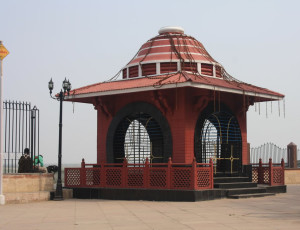 It is situated on the south bank of holy river Ganges behind N.I.T Patna. The Gandhi Ghat is associated with the immersion of ashes of father of the Nation Mahatma Gandhi in the river Ganges.
It is situated on the south bank of holy river Ganges behind N.I.T Patna. The Gandhi Ghat is associated with the immersion of ashes of father of the Nation Mahatma Gandhi in the river Ganges.
Ganga Aarti :-
 Emulating the immensely popular practice of ‘Ganga Aarti’ at Varanasi and Haridwar, Former Deputy Chief Minister Sushil Kumar Modi on 25 February 2011 inaugurated the first ever
Emulating the immensely popular practice of ‘Ganga Aarti’ at Varanasi and Haridwar, Former Deputy Chief Minister Sushil Kumar Modi on 25 February 2011 inaugurated the first ever  such event at Patna’s Gandhi Ghat to promote religious sentiments as well as tourism in the state.
such event at Patna’s Gandhi Ghat to promote religious sentiments as well as tourism in the state. 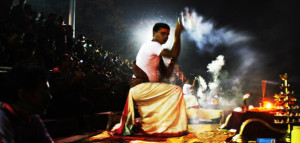 Now a day it is organised on every saturday and sunday at gandhi Ghat (backside of Engineering college) patna from 6 P:M or 6.30P.M to 7 P:M or 7.30 P.M.Three pujaris, dressed in white dhoti and red kurtas, specially trained in Varanasi, carried out the
Now a day it is organised on every saturday and sunday at gandhi Ghat (backside of Engineering college) patna from 6 P:M or 6.30P.M to 7 P:M or 7.30 P.M.Three pujaris, dressed in white dhoti and red kurtas, specially trained in Varanasi, carried out the  rituals on the river bank. The light of ‘diyas’ illuminated the river bank amidst chanting of hymns. A number of diyas were floated in the river at the end.
rituals on the river bank. The light of ‘diyas’ illuminated the river bank amidst chanting of hymns. A number of diyas were floated in the river at the end.
Shiva Temple (Gandhi ghat):-During Archaeological Exploration performed by KP Jayaswal Research Institute Early Medieval Period site have been brought to light.
Yacht Restaurant(Floating Restaurant) :-Patna is now a proud owner of a luxury air conditioned yacht with restaurant for the fun of the Patnaites and visitors. The Bihar State Tourism Development Corporation (BSTDC) has recently started operating a air conditioned floating restaurant named MV Ganga Vihar from Gandhi Ghat offering dinner cruises twice a day. Fully air-conditioned, the vessel has a capacity to seat 75 persons.
 The corporation is all set to launch special moonlit trips on the cost of Rs 350 per person , three days a month.The first cruise of a month is in the evening before the full moon day. The rest is in the evening of the full moon day and the next evening. The trip is start from Gandhi Ghat at 8pm. The floating restaurant has anchored for about half-an-hour in the middle of the river. We can enjoying Aarti at Gandhi Ghat from the MV Ganga Vihar in the Ganga river on Saturdays and Sundays on the cost of Rs 150 per person.The tickets can be booked at the Gandhi Ghat and the tourism corporation office on Beer Chand Patel Path.
The corporation is all set to launch special moonlit trips on the cost of Rs 350 per person , three days a month.The first cruise of a month is in the evening before the full moon day. The rest is in the evening of the full moon day and the next evening. The trip is start from Gandhi Ghat at 8pm. The floating restaurant has anchored for about half-an-hour in the middle of the river. We can enjoying Aarti at Gandhi Ghat from the MV Ganga Vihar in the Ganga river on Saturdays and Sundays on the cost of Rs 150 per person.The tickets can be booked at the Gandhi Ghat and the tourism corporation office on Beer Chand Patel Path.
Timing :
- Monday – Friday (One trip): 5 PM – 6 PM (Summer), 4 PM -5 PM(Winter)
- Saturday and Sunday (Two trip) : 3:30 PM – 4:30 PM and 5:30 PM -6:30 PM
- Fee : Rs 100 per person (boating only)
- Fee : Rs 150 per person (boating and Ganga Aarti )
- No ticket for children below 5 years of age.
The ship is available for special booking for party purpose. The fees depends on the duration of the booking. Restaurant may be functional on request. The lighting and sound system may be also arranged on request. For Corporate parties or for special birthday celebration, its quite suitable and surely a memorable experience.
Ganga Diara Tourism:-Bihar State Tourism Development Corporation (BSTDC) has developed ‘Ganga diara’ as a tourist spot. A food plaza has set up in Ganga diara for tourists. River sports facilities like water scooters, speedboats and water skating as a part of the development and beautification plan, especially at Gandhi Ghat, Collectorate Ghat and Diara Camp,”
 Bihar State Tourism Development Corporation (BSTDC) has opened a picnic area in Diara, on the other side of the Ganges. The picnic
Bihar State Tourism Development Corporation (BSTDC) has opened a picnic area in Diara, on the other side of the Ganges. The picnic  spot was inaugurated by then Deputy Chief Minister of Bihar, Sushil Kumar Modi in 4th December 2011. It is equipped with food court and cabanas for those who would like to spend a day at the beach. It is situated in area of 24000 square feet, having three thatched cabanas, six sitting area, and a food court offering snacks.The picnic area is accessible from Gandhi Ghat, Behind NIT, Patna.The picnic area is opened between 2 PM to 5 PM.
spot was inaugurated by then Deputy Chief Minister of Bihar, Sushil Kumar Modi in 4th December 2011. It is equipped with food court and cabanas for those who would like to spend a day at the beach. It is situated in area of 24000 square feet, having three thatched cabanas, six sitting area, and a food court offering snacks.The picnic area is accessible from Gandhi Ghat, Behind NIT, Patna.The picnic area is opened between 2 PM to 5 PM.
Bihar State Tourism Development Corporation (BSTDC) has decided to project Sabbalpur Diara (riverine) tourism project in a big way. The riverine has the Ganga and Gandak rivers on its either side. Tourists from November 15, 2011 onwards will be able to enjoy camel rides, water sports activities and mouth-watering dishes at Sabbalpur Diara. The sandbar, situated a few kilometres from the banks of Ganga in Patna City, would be developed as a tourism hub under the aegis of Sabbalpur Diara Island River Project of BSTDC.
Motor boats are available to rent at a moderate price and are fitted with Yamaha 25 HP air-cooled two-stroke engines.
Mir Afzal Mosque :-Is located behind the Bihar College Of Engineering Now NIT, is a little germ where the Emperor Farrukhsiyar worshipped.
Patna Science College:-Patna Science College’ a constituent unit of Patna University was established in the year 1927 and science classes, so 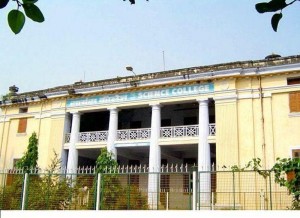 long attached to Patna College, moved to a group of new buildings, not all complete, in July 1927. Initially, it was opened as the Science department of Patna University. It began functioning independently from the year 1928 when the buildings were fully completed and its foundation stone was laid by then Viceroy of India, Lord Irwin on 15th of November, 1928 .
long attached to Patna College, moved to a group of new buildings, not all complete, in July 1927. Initially, it was opened as the Science department of Patna University. It began functioning independently from the year 1928 when the buildings were fully completed and its foundation stone was laid by then Viceroy of India, Lord Irwin on 15th of November, 1928 .
The college is centrally located in Patna occupying an area of approximately 28.32 acres of land containing separate blocks for different Science departments. The college campus also includes 5 Hostels, 3 Playgrounds, Gymnasium, and an Administrative Block.
Patna University :-
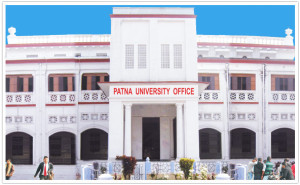
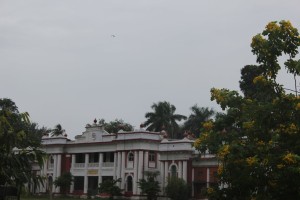 It is the first university in Bihar, was established in 1917 during the British Raj, and is the 7th oldest University of the Indian subcontinent. At that time, the jurisdiction of the university extended to Bihar, Orissa, and the Kingdom of Nepal. The university conducted examinations for educational institutions under its jurisdiction from school finals to the post graduate levels. This continued almost for four decades, until the establishment of the Tribhuvan University, Kathmandu, and the Utkal University, Bhubaneshwar. During the first five years of its existence (from 1917 to 1922), the university was permitted to use a wing of patna high court as its temporary office. The meetings of the faculties used to be held in the hall of new college (now patna college), while the senate meetings were held in the conference room of the secretariat, the convocation of the university used to be held in the durbar hall of the government house (now raj bhawan).The university office buildings were constructed in 1927 and occupied in 1928.
It is the first university in Bihar, was established in 1917 during the British Raj, and is the 7th oldest University of the Indian subcontinent. At that time, the jurisdiction of the university extended to Bihar, Orissa, and the Kingdom of Nepal. The university conducted examinations for educational institutions under its jurisdiction from school finals to the post graduate levels. This continued almost for four decades, until the establishment of the Tribhuvan University, Kathmandu, and the Utkal University, Bhubaneshwar. During the first five years of its existence (from 1917 to 1922), the university was permitted to use a wing of patna high court as its temporary office. The meetings of the faculties used to be held in the hall of new college (now patna college), while the senate meetings were held in the conference room of the secretariat, the convocation of the university used to be held in the durbar hall of the government house (now raj bhawan).The university office buildings were constructed in 1927 and occupied in 1928.
At the time of its inauguration, the Patna University possessed only Six colleges in the whole of Bihar and Orissa, teaching up to degree standard in either Arts or Science or both. These were Patna College, Bihar National College ( famous as B. N. College) at Patna, the Greer Bhumihar Brahmin College at Muzaffarpur, the Tej Narayan Jubilee College at Bhagalpur, the St. Columba’s College at Hazaribagh and the Diamond Jubilee College of Munger (affiliated only upto Intermediate standard in Arts). Besides these there were a Law College and a Teacher’s Training College at Patna. Before 1912, there was no provision for postgraduate teaching in any subject except History which was taught in the Patna College. This college, the first educational institution in Bihar, was affiliated to the Calcutta University in the usual Arts subjects upto B.A. – Honours standard and in Physics, Chemistry and Mathematics upto B.Sc.-Hons. degree.
Presently following colleges / units of Patna university are engaged in teaching activities: –
Patna College
Science College
Vanijya Mahavidyalaya
Bihar College of Engineering
Bihar National College
Teacher’s Training College
Magadh Mahila College
Women’s Training College
Patna Womens College
Patna Medical College
Patna Dental College
Patna Arts and Craft College
Institute of Library and Information Science
Directorate of Distance Education (DDE),
Deptt. of A.I. History & Archaeology Museum, Patna University, Patna :–This museum was established in the year 1960-61 with the beginning of the teaching of Archaeology by the Department of Ancient Indian History & Archaeology, Patna university. The collection consists of different types of antiquities from Antichak, Oriup and Champa of the Bhagalpur district; Vaishali; Kumrahar of the Patna district and Chirand of the Saran district. Besides, there are coins of different periods and other miscellaneous antiquities and ceramic examples from other sites of the state and the country.
Wheeler Senate Hall, Ashok Rajpath :-
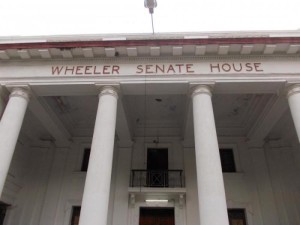 Wheeler Senate Hall of Patna University, the nerve centre of all academic activities during the last 75 years, has played an important role in shaping the educational and socio-cultural trends in the eastern region. Even as most buildings of Patna University have become quite old and dilapidated, the picturesque Wheeler Senate Hall continues to reflect the glory of one of the oldest Universities in the country.The Senate Hall hosted a number of important academic and social conferences. The history of Wheeler Senate Hall is closely linked with the history of patna university. Raja Devaki Nandan Prasad singh of Munger meet the entire cost (estimated at about Rs 1.75 lakh) of building a Senate Hall for the University. The hall was declared open by Sir Henry Wheeler, the then governor of bihar and chancellor of the University, in november, 1926.Annual University meetings, debates, deliberations of the faculties and meetings of the senate were being held in this hall soon after its construction. The hall used to wear a festive look at the time of annual convocation. Eminent personalities such as Lord Mountbatten, Smt. Sarojini Naidu, Sri. Sardar Vallabhbhai Patel, Sri. C. D. Deshmukh, Sri. V.K.R.V.Rao and Smt. Vijayalakshmi Pandit addressed the convocations of the university. Besides, scientists like Sri. J.C. Bose,Sri. C.V.Raman, Sri. Meghnad Saha, Sri. Satyen Bose and Sri. S.K.Mitra also addressed the students and faculty members of the university on different occasions. Felicitation of Kabiguru Rabindranath Tagore at Wheeler Senate Hall of Patna University on March 17, 1936. Political meetings were seldom held in this hall before independence.The historic public meeting held in the hall in 1946 in which Pandit Jawahar Lal Nehru had to face much embarrassment owing to recent communal disturbances in the state. It was in this hall where the representatives of student’s unions of all the universities, at a convention organised by the patna university students union in 1973, adopted a resolution for launching a statewide agitation against the misrule of the then government, which ultimately changed the political scenario of the entire country.
Wheeler Senate Hall of Patna University, the nerve centre of all academic activities during the last 75 years, has played an important role in shaping the educational and socio-cultural trends in the eastern region. Even as most buildings of Patna University have become quite old and dilapidated, the picturesque Wheeler Senate Hall continues to reflect the glory of one of the oldest Universities in the country.The Senate Hall hosted a number of important academic and social conferences. The history of Wheeler Senate Hall is closely linked with the history of patna university. Raja Devaki Nandan Prasad singh of Munger meet the entire cost (estimated at about Rs 1.75 lakh) of building a Senate Hall for the University. The hall was declared open by Sir Henry Wheeler, the then governor of bihar and chancellor of the University, in november, 1926.Annual University meetings, debates, deliberations of the faculties and meetings of the senate were being held in this hall soon after its construction. The hall used to wear a festive look at the time of annual convocation. Eminent personalities such as Lord Mountbatten, Smt. Sarojini Naidu, Sri. Sardar Vallabhbhai Patel, Sri. C. D. Deshmukh, Sri. V.K.R.V.Rao and Smt. Vijayalakshmi Pandit addressed the convocations of the university. Besides, scientists like Sri. J.C. Bose,Sri. C.V.Raman, Sri. Meghnad Saha, Sri. Satyen Bose and Sri. S.K.Mitra also addressed the students and faculty members of the university on different occasions. Felicitation of Kabiguru Rabindranath Tagore at Wheeler Senate Hall of Patna University on March 17, 1936. Political meetings were seldom held in this hall before independence.The historic public meeting held in the hall in 1946 in which Pandit Jawahar Lal Nehru had to face much embarrassment owing to recent communal disturbances in the state. It was in this hall where the representatives of student’s unions of all the universities, at a convention organised by the patna university students union in 1973, adopted a resolution for launching a statewide agitation against the misrule of the then government, which ultimately changed the political scenario of the entire country.
Patna College :-
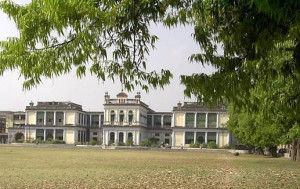 Today’s Patna College administrative block is said to be the part of a Dutch Opium Factory established on the bank of Ganga as a part of the flouring Opium Trade from the norther China and Nepal region. A gymnasium of Patna College is The old opium godown. The civil courts were held in its premises from 1857 to 1862.The foundation of Patna College on January 9, 1863 is a memorable event in the history of modern Bihar . The oldest institution for imparting high Collegiate education in this province, It is the mother of the most of the Colleges, now flourishing in all their independent glory.The western wing of the college was added in 1871, and the eastern in 1880. The portico and the present BA Lecture Theatre were constructed in 1882, and the latter was connected with the main building by the long western corridor named after principal Ewbank.New laboratories (occupying the site of present Iqbal Hostel) were completed in 1913-14.The college common room was constructed in 1925-26 and the gymnasium in 1928. Rebuilding and restorative work after the 1934 earthquake was completed in 1935 and the debris was utilized in raising and beautifying the river bank. In 1942, principal Batheja rearranged the building accommodation according to function. The college building has already been declared to be a heritage site by the Archeological Survey of India. With the establishment of Patna College in 1863 began the era of higher English education in Bihar . It started with 5 students and Mc Crindle as its first principal. The numerical strength of the college rose from 5 on 31 March 1863, to 162 in 31 March 1881 ,to 205 in 31 march 1900,to 488 on March 1927 , including 151 Postgraduates. In 1868, the first batch of Patna College students took their degrees. During 1906-1909 period, some connected institutions were separated from the parent institutions, the Patna College . The Government Law College was started in July 1909. The Bihar school of Engineering became an entirely separate institution in 1909
Today’s Patna College administrative block is said to be the part of a Dutch Opium Factory established on the bank of Ganga as a part of the flouring Opium Trade from the norther China and Nepal region. A gymnasium of Patna College is The old opium godown. The civil courts were held in its premises from 1857 to 1862.The foundation of Patna College on January 9, 1863 is a memorable event in the history of modern Bihar . The oldest institution for imparting high Collegiate education in this province, It is the mother of the most of the Colleges, now flourishing in all their independent glory.The western wing of the college was added in 1871, and the eastern in 1880. The portico and the present BA Lecture Theatre were constructed in 1882, and the latter was connected with the main building by the long western corridor named after principal Ewbank.New laboratories (occupying the site of present Iqbal Hostel) were completed in 1913-14.The college common room was constructed in 1925-26 and the gymnasium in 1928. Rebuilding and restorative work after the 1934 earthquake was completed in 1935 and the debris was utilized in raising and beautifying the river bank. In 1942, principal Batheja rearranged the building accommodation according to function. The college building has already been declared to be a heritage site by the Archeological Survey of India. With the establishment of Patna College in 1863 began the era of higher English education in Bihar . It started with 5 students and Mc Crindle as its first principal. The numerical strength of the college rose from 5 on 31 March 1863, to 162 in 31 March 1881 ,to 205 in 31 march 1900,to 488 on March 1927 , including 151 Postgraduates. In 1868, the first batch of Patna College students took their degrees. During 1906-1909 period, some connected institutions were separated from the parent institutions, the Patna College . The Government Law College was started in July 1909. The Bihar school of Engineering became an entirely separate institution in 1909
With the establishment of Patna University in October 1917, after the creation of the separate Province of Bihar and Orissa, a new chapter was added to the history of higher education in Bihar . Post-graduate classes in various arts subjects were started at Patna College in July 1919 . The Science College Was established as a separate institutions for higher scientific teaching in 1927.
Darbhanga House:-
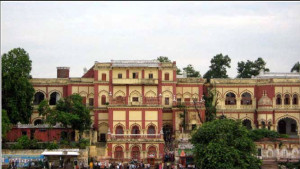 It is the palace constructed by the Darbhanga king the Maharaja Kameshwar Singh Bahadur. It has been donated by the royal family to the Patna University. The university hosts the post graduate courses in the premises of the Darbhanga House. The Darbhanga House also called Naulakha Palace. A chief feature of the Darbhanga House is the temple built in the premises of the palace. The temple is dedicated to the Goddess Kali.
It is the palace constructed by the Darbhanga king the Maharaja Kameshwar Singh Bahadur. It has been donated by the royal family to the Patna University. The university hosts the post graduate courses in the premises of the Darbhanga House. The Darbhanga House also called Naulakha Palace. A chief feature of the Darbhanga House is the temple built in the premises of the palace. The temple is dedicated to the Goddess Kali.
Patna College Gaht:-
Archaeological garden(Minto Hostel, Patna College):-
During Archaeological Exploration performed by KP Jayaswal Research Institute Early Medieval Period site have been brought to light.
Khuda Baksh Oriental Library:-
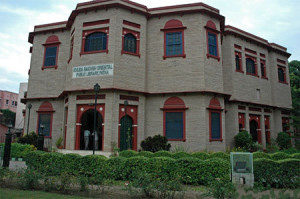 It is Located in Ashok Rajpath. A magnificent one man collection of rare Arabic and Persian manuscripts , rare paintings belonging to the Rajput and Mughal era , oddities like the Koran inscribed in a book only 25mm wide and an assortment of old and new books from the University of Cordoba, Spain. The library also contains the only books to survive the sacking of the Moorish University of Cordoba in Spain. It is one of the oldest national libraries in India.This library was opened to public in the year 1890 by the Maulvi Khuda Baksh Khan Bahadur, sometime government pleader of Patna, and afterward chief justice of Hyderabad state, whose tomb is in the library compound. Initially the library contained 4000 manuscripts from Khuda Baksh’s personal collection, among which 1400 were inherited from his father Maulvi Muhammad Bakhsh Khuda. Baksh Oriental Library was declared an institute of national importance in the year 1969 by an act of the parliament. It is now managed by an administrative board headed by the governor of Bihar. Moreover there are 850 audio and 550 video tapes on many prominent and important personalities have been made by the library. The Khuda Baksh Oriental Library also publishes a quarterly research journal. Apart from all these another major attraction of the library is the wide collection of letters from eminent personalities that are preserved there.The library has instituted a few fellowships at par with UGC. It has been recognised by seven universities as a centre of research, for awarding the degrees of Ph.D. and D. lit. The library has also instituted a prestigious award, which carries an amount of Rs 1 lakh and a citation.
It is Located in Ashok Rajpath. A magnificent one man collection of rare Arabic and Persian manuscripts , rare paintings belonging to the Rajput and Mughal era , oddities like the Koran inscribed in a book only 25mm wide and an assortment of old and new books from the University of Cordoba, Spain. The library also contains the only books to survive the sacking of the Moorish University of Cordoba in Spain. It is one of the oldest national libraries in India.This library was opened to public in the year 1890 by the Maulvi Khuda Baksh Khan Bahadur, sometime government pleader of Patna, and afterward chief justice of Hyderabad state, whose tomb is in the library compound. Initially the library contained 4000 manuscripts from Khuda Baksh’s personal collection, among which 1400 were inherited from his father Maulvi Muhammad Bakhsh Khuda. Baksh Oriental Library was declared an institute of national importance in the year 1969 by an act of the parliament. It is now managed by an administrative board headed by the governor of Bihar. Moreover there are 850 audio and 550 video tapes on many prominent and important personalities have been made by the library. The Khuda Baksh Oriental Library also publishes a quarterly research journal. Apart from all these another major attraction of the library is the wide collection of letters from eminent personalities that are preserved there.The library has instituted a few fellowships at par with UGC. It has been recognised by seven universities as a centre of research, for awarding the degrees of Ph.D. and D. lit. The library has also instituted a prestigious award, which carries an amount of Rs 1 lakh and a citation.
Vanijya Mahavidyala:-
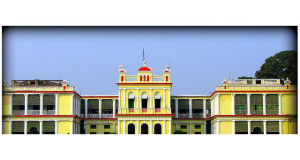 It is the only prestigious College of the University for imparting higher education in the field of Commerce. It was established in the month of December, 1953 as B.Com College. It is memorable event in the history when the college started commerce education at the same parallel pattern as that of Arts and Science. It has developed and progressed under the patronage of Patna Law College. At last, on the 9th December, 1974, it got independence status and become the constituent Vanijya Mahavidyalaya of the University. It started imparting postgraduate education in commerce in the year 1985.
It is the only prestigious College of the University for imparting higher education in the field of Commerce. It was established in the month of December, 1953 as B.Com College. It is memorable event in the history when the college started commerce education at the same parallel pattern as that of Arts and Science. It has developed and progressed under the patronage of Patna Law College. At last, on the 9th December, 1974, it got independence status and become the constituent Vanijya Mahavidyalaya of the University. It started imparting postgraduate education in commerce in the year 1985.
Patna Medical College and Hospital:-
It was started in the year 1874 as Temple Medical School with total admission of 35 students per year. It was turned into the medical college named as Prince of Wales Medical College, Patna on 25th February 1925. Various building were constructed by the donations from Princely states of Bihar. The first batch of 35 students were transferred from Calcutta Medical College, Calcutta to Prince of Wales Medical College, Patna.At present the number of admission per year is 100. Post graduate course was started in 1932.At present 247 doctors are admitted in postgraduate course every year. Postgraduate teaching in Physiology, Gynaecology, Orthopaedics and Radiotherapy was established first in India in this institution.
This college is the mainstay for medical education and treatment to the masses, not only to this State, but the adjoining area of the neighboring States.
Bhiknapahari :-This is the mendicants hill erected by Asoka for his half- brother Prince Mahendra who having turned a recluse and was residing at Gridhakuta hill at Rajgir. Asoka persuaded him to come to Pataliputra and live there on a similar hill which he made for him. A clay image of the Gridhakuta hill is worshiped by the people as “Bhikhna Kumar”.
Patna Dental College and Hospital :-Patna Dental College was established by the Government of Bihar on September 9, 1960 in the premises of Patna 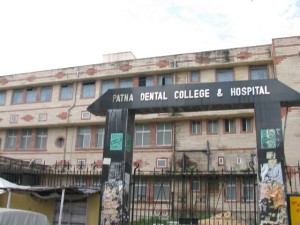 Medical College and Hospital. Presently, Patna Dental College and Hospital is situated in its own building and is located in the heart of the city on the bank of the holy river Ganga adjacent to PMCH on main Ashok Rajpath. Patna Dental College and Hospital imparts Bachelor of Dental Surgery (BDS) and Master degree in Dental Surgery (MDS) and Certificate courses in Dental Hygiene and Dental Mechanics. The College and Hospital is well equipped with the latest technology and provides one of the best education and treatment in the field of dental science. Patna Dental College is an institution for Dental science and is a part of the Patna University.
Medical College and Hospital. Presently, Patna Dental College and Hospital is situated in its own building and is located in the heart of the city on the bank of the holy river Ganga adjacent to PMCH on main Ashok Rajpath. Patna Dental College and Hospital imparts Bachelor of Dental Surgery (BDS) and Master degree in Dental Surgery (MDS) and Certificate courses in Dental Hygiene and Dental Mechanics. The College and Hospital is well equipped with the latest technology and provides one of the best education and treatment in the field of dental science. Patna Dental College is an institution for Dental science and is a part of the Patna University.
Brahmo Samaj (Aghore Paribar) at Khazanchi Road :-In 1875, Aghore Kamini Devi came to Motihari along with her two daughters and here also they established a Samaj and undertook social work. In 1877, Prakash Chandra came to Bankipore, that is Patna, as an excise inspector . With his coming to Patna, the Brahmo Samaj received a new inspiration and vigour. In spite of heavy pressure of work, he exerted himself fully to the propagation of the Brahmo faith. He was known for helping the poor and the needy in a typical Brahmo spirit. He was so much dedicated to his work for the Samaj that he was called a Brahmo ‘Saint.’ His was a noble life lived in the spirit of the new faith. From an early period of his life, he accepted the New Dispensation and gave himself entirely to those convictions and to the practice of piety. In course of time, Prakash Chandra built a house at Khazanchi Road and named it the ‘Aghore Paribar.’ This house, which is still there, became one of the chief centres of Navavidhan faith and Brahmo activities at Patna. Thus, both Prakash Chandra and the Aghore Paribar were identified with the Brahmo Samaj movement in Bihar.Raja Ram Mohun Roy (August 14, 1774 – September 27, 1833) was a founder (with Dwarkanath Tagore and other Bengali Brahmins) of the Brahmo Sabha in 1828 which engendered the Brahmo Samaj, an influential Indian socio-religious reform movement.
Patna Collegiate School :-
 It was founded on 10th August, 1835 by the officials of East India company to spread
It was founded on 10th August, 1835 by the officials of East India company to spread 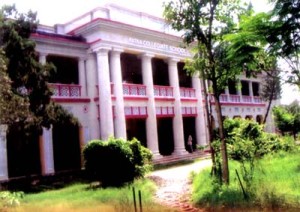 the English pattern of Education in Bihar. Its previous name was Patna High School. It was founded at Alan Ganj, Ashok Rajpath, Patna. That way it is the oldest High School of State Bihar. In the year 1862, the name of the school was changed to present name Patna Collegiate School and was transferred to the place which is now referred as Patna Campus. Mr. J. E. Mecridle was appointed its head and was designated as its Principal. In the year 1915 IA Course of Patna College, Patna was transferred to Patna Collegiate and it was rechristened as New College (Junior Patna College). Till June 1927, It functioned as New College. On 1 July 1927, the school unit of New College was transferred to its present building and since then the institution is functioning in the name of Patna Collegiate School, Dariyapur, Patna.
the English pattern of Education in Bihar. Its previous name was Patna High School. It was founded at Alan Ganj, Ashok Rajpath, Patna. That way it is the oldest High School of State Bihar. In the year 1862, the name of the school was changed to present name Patna Collegiate School and was transferred to the place which is now referred as Patna Campus. Mr. J. E. Mecridle was appointed its head and was designated as its Principal. In the year 1915 IA Course of Patna College, Patna was transferred to Patna Collegiate and it was rechristened as New College (Junior Patna College). Till June 1927, It functioned as New College. On 1 July 1927, the school unit of New College was transferred to its present building and since then the institution is functioning in the name of Patna Collegiate School, Dariyapur, Patna.
Patna Training College :-
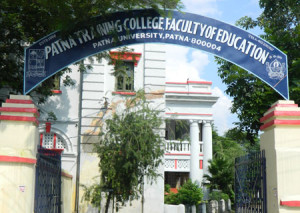
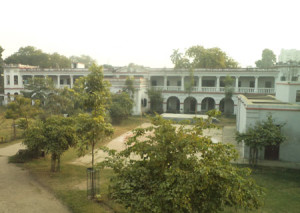 Patna Training College has a magnificent double storey building of modern British style and the campus is spread over an area of 25000 sq. meters.
Patna Training College has a magnificent double storey building of modern British style and the campus is spread over an area of 25000 sq. meters.
The college is located opposite to the Patna Collegiate School at Baripath. The hostel connected to the college is located just opposite to the college with 10 four seated rooms and 40 single seated rooms. The campus of the college also includes residence of non-teaching staff, some teachers and the principal.The history of Patna Training College dates back to 1908, when three other training colleges in the cities of Bombay, Calcutta and Dacca were also established in the years 1906, 1908 and 1910 respectively. This college is operating as a constituent unit of Patna University with Department of Education and Women’s Training College, which are jointly constitute the Faculty of Education of Patna University. Initially, the college was affiliated to the Calcutta University and later it came under the jurisdiction of Patna University.
Birla Mandir :-
It is situated on Bhikhana pahari more houses Hindu Deity, Lakshminarayan. It is usually referring to Vishnu, also known as Narayan, when he is with his consort Lakshmi. It is said that a Hindu saint advised the Birla family that if they construct a temple, it will bring growth and prosperity to their family and business. This prompted the Birla’s to construct temples, which indeed has brought prosperity. Since the start of the  construction at the first temple, the construction is continuously going on at some location. The family believes that if they stop the construction of temples, it will bring bad fate. This is the reason why some of the temples are not 100% finished, and construction is on-going, albeit at a slow pace.
construction at the first temple, the construction is continuously going on at some location. The family believes that if they stop the construction of temples, it will bring bad fate. This is the reason why some of the temples are not 100% finished, and construction is on-going, albeit at a slow pace.
Nala Road Mandir:-
Bhanwar Pokhar (Sabzibagh ) :-It is one of the seven historical sacred lakes of Pataliputra.
Anjuman Islamia Hall :-The Muslims in Patna were in search of a suitable place for holding meetings and other social functions. After deliberations, 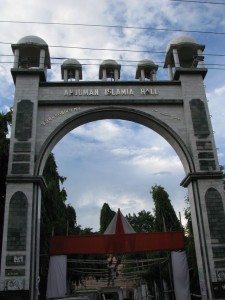 they managed to construct a premise in central Bankipore in 1885, called Anjuman Islamia Hall. The land for the hall was donated by a Muslim zamindar and money for the construction of the premise was collected by donations from the Muslims and non-Muslims. Anjuman Islamia Hall is still being used for multi-purpose occasions.
they managed to construct a premise in central Bankipore in 1885, called Anjuman Islamia Hall. The land for the hall was donated by a Muslim zamindar and money for the construction of the premise was collected by donations from the Muslims and non-Muslims. Anjuman Islamia Hall is still being used for multi-purpose occasions.
Abdul Bari Ki Mazar:-It is situated in Pirmuhani kabristan. Bari sahib was born in 1892 at Shahabad dist. When he was a student, participates in freedom movement on the call of Mahatma Gandhi in 1921 and got popularities. He became M.L.A and elected Vidhan Sabha speaker in 1936.Mahatma Gandhi called him Patna in the time of communal rite in 1947.He was shouted by criminals on the Fatuha Railway crossing on dated 28 march 1947, when he was in way of Patna. Koilwar pul is also on his named.
Mahendru Ghat :-The famous Mahendru Ghat in today’s Patna is the reminder of Mahendru (Ashoka’s brother) who had sailed from this very Ghat to Ceylon in order to preach Buddhism.Prior to Mahatma Gandhi Setu there had been regular Steamer service of the Indian Railways between Mahendru Ghat at Patna end and Pahleja Ghat at Sonepur end. These steamers were huge enough to accommodate 500 to 1000 passengers run on steam and paddle with very low frequency horns, the sound that still haunts the down memory lane in our minds. After the closure of ferry service , 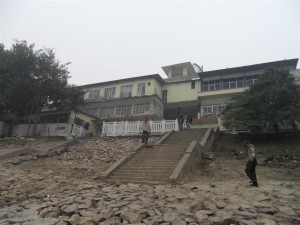 Railway Recruitment Board, Patna office was shifted to the Railway building in Mahendrughat on 31/7/1985 from a private building at Jamal Road.Since then, the Railway Recruitment Board, Patna has been functioning in that building and discharging its responsibilities of making recruitment selections for its present jurisdiction of Danapur, Mughalsarai, Dhanbad Divisions (East Central Railway) & Head Quarter of East Central Railway and Katihar Division (Northeast Frontier Railway).
Railway Recruitment Board, Patna office was shifted to the Railway building in Mahendrughat on 31/7/1985 from a private building at Jamal Road.Since then, the Railway Recruitment Board, Patna has been functioning in that building and discharging its responsibilities of making recruitment selections for its present jurisdiction of Danapur, Mughalsarai, Dhanbad Divisions (East Central Railway) & Head Quarter of East Central Railway and Katihar Division (Northeast Frontier Railway).
St. Joseph’s Convent High School :-
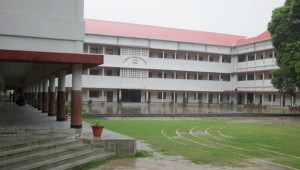
 It is established in 1853. The school is amongst the oldest missionary schools in eastern India. It is situated at Bankipur on the banks of the river Ganges. It is a first boarding school for girls and the institution is controlled by Sisters of I.B.M.V. The school is English as well as Hindi medium. The English medium is I.C.S.E. Board and Hindi medium is Bihar board. After the 1947, people were full of feeling for anti-English waves. Anti-English feeling was their sign of patriotism at that time. That was when authorities of St. Joseph’s Convent High School saw the scribbling on the wall and that was the time school put to an end to its affiliation with the Senior Cambridge Examination. School was then affiliated with the ICSE Board and till today.
It is established in 1853. The school is amongst the oldest missionary schools in eastern India. It is situated at Bankipur on the banks of the river Ganges. It is a first boarding school for girls and the institution is controlled by Sisters of I.B.M.V. The school is English as well as Hindi medium. The English medium is I.C.S.E. Board and Hindi medium is Bihar board. After the 1947, people were full of feeling for anti-English waves. Anti-English feeling was their sign of patriotism at that time. That was when authorities of St. Joseph’s Convent High School saw the scribbling on the wall and that was the time school put to an end to its affiliation with the Senior Cambridge Examination. School was then affiliated with the ICSE Board and till today.
St. Joseph’s Catholic Church, Bankipore( St Joseph’s Convent High School premises):-
Bishop A Hartmann laid the chapel’s foundation stone at Bankipore. Later, in 1871, the chapel’s size was increased to enable holding of congregations. Even in 1921, when the diocese of Patna was recognised, the only church at Bankipore had a 20ftx50ft chapel. The present cathedral came up in 1927 when the number of Catholics increased.
Christ Church:-
Located on the premises of Christ Church Diocesan School, Kargil Chowk, northeast of Gandhi Maidan.
The Church of North India founded it. It was established in 1852. It has been associated with Church of England in India
T K Ghosh Academy :-
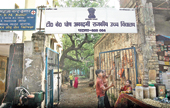 Established in 1869.the Academy has been referred to as a `good school’ in the autobiography of Rajendra Prasad, who studied in this institute for about two years. “It was the first private initiative to open a school at Patna and students came from Orissa, Bihar and West Bengal to study here,” There is a move to declare the T K Ghosh Academy, which boasts of alumni like the first president of India Rajendra Prasad and first chief minister of West Bengal Dr Bidhan Chandra Roy, a national heritage site.”The high-powered committee set up by the state government to celebrate the 125th birth anniversary of Prasad has recommended that it should be made a national heritage site. It has been the alma mater of not only Prasad and Roy, but also luminaries like Abdul Bari, Sachhidananda Sinha and Sir Hassan Imam,” remarked committee member and Gandhi Sangrahalaya secretary Razi Ahmad. Spread over a little over one acre plot on the Ashok Rajpath.The school became a government school in 1974.
Established in 1869.the Academy has been referred to as a `good school’ in the autobiography of Rajendra Prasad, who studied in this institute for about two years. “It was the first private initiative to open a school at Patna and students came from Orissa, Bihar and West Bengal to study here,” There is a move to declare the T K Ghosh Academy, which boasts of alumni like the first president of India Rajendra Prasad and first chief minister of West Bengal Dr Bidhan Chandra Roy, a national heritage site.”The high-powered committee set up by the state government to celebrate the 125th birth anniversary of Prasad has recommended that it should be made a national heritage site. It has been the alma mater of not only Prasad and Roy, but also luminaries like Abdul Bari, Sachhidananda Sinha and Sir Hassan Imam,” remarked committee member and Gandhi Sangrahalaya secretary Razi Ahmad. Spread over a little over one acre plot on the Ashok Rajpath.The school became a government school in 1974.
Ram Mohan Roy Seminary (Khazanchi Road) , Patna :-Ram Mohan Roy Seminary, a High English School, was set up at Bankipur in 1890 under the charge of Satis Chandra Chakravarti, a worker of the Bankipur Ashram of the Sadharan Brahmo Samaj . The School was blessed during August Kranti movement in 1942 when two of its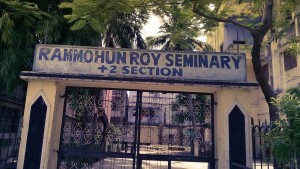 student sacrificed their life while hoisting national flag at the State Assembly building. Their supreme sacrifice at such a tender age has put the school in the Indian history. The martyrs memorial is a tribute to the martyrs. The two students were :
student sacrificed their life while hoisting national flag at the State Assembly building. Their supreme sacrifice at such a tender age has put the school in the Indian history. The martyrs memorial is a tribute to the martyrs. The two students were :
Umakant Prasad Sinha – class IX
Ramanand Singh – class IX
P.N Anglo Sanskrit School (Naya Tola), Patna:-Purnendu Narayana Sinha, a leading member of the domiciled Bengali Community of Patna, prominent lawyer, a leading member of Pre-Montague- Chelmsford Legislative Council of Bihar and Orissa , also presided over a special session of the Bihar Provincial Conference 1917, took active interest in social and educational works of the province established P.N Anglo-Sanskrit School in the year 1895-1897.
B.N. College :-
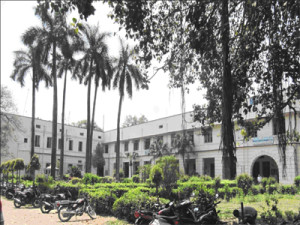 Bihar National College, a constituent unit of Patna University, was established in the year 1889. It is one of the biggest and oldest multi-faculty colleges of the state imparting degree level teaching in almost all the subjects of Arts and Science and upto post graduate level in some selected subjects.
Bihar National College, a constituent unit of Patna University, was established in the year 1889. It is one of the biggest and oldest multi-faculty colleges of the state imparting degree level teaching in almost all the subjects of Arts and Science and upto post graduate level in some selected subjects.
B. N. College that was established by Bisheshwar Singh as a high school in 1883, a famous zamindar of the district of Bhojpur, formerly known as Shahabad. Its status raise to second grade college in year 1889 by the then Government.it was raised to the status of B.A degree level in 1907 imparting degrees both in Arts and Science
Sabzibagh Christian Cemetery ( Ashok Rajpath):-Sabzibagh Cemetery was the first documented burial ground of the city. “It was inaugurated by then Bishop of Calcutta in 1830. Most of the graves here are of British officers and their family members who had settled in Patna, mostly in Danapur Cantonment area. Later, the cemetery was closed in 1886 as there was not much space left for more burials.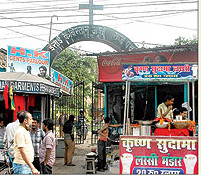
Cecil Faulder, late commissioner of Patna division, was buried here. The inscription on his grave reads, “In the loving memory of my dear husband, Cecil Faulder, late commissioner of Patna Division. Aged 50, died April 28, 1904.” J. Short ESQ, then deputy postmaster-general of Behar (Bihar), who died at Bankipore on April 4, 1896, was also buried here.
The most important graves is that of then city magistrate Henry Douglas, who made significant contribution in planting trees around Gandhi Maidan and Exhibition Road. According to the inscription on Henry’s grave, he was in the Bengal Civil Services and born on November 18, 1859. He died at the age of 78.
Mirza Murad Tomb (Muradpur):-
Bankipore Club :-
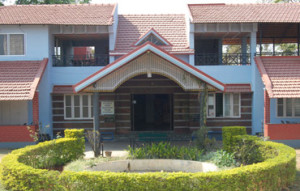
 Bankipore Club is the oldest Club in Patna and one of the oldest premier clubs in the country.
Bankipore Club is the oldest Club in Patna and one of the oldest premier clubs in the country. It was founded on the bank of river Ganga at Patna in 1865. It derives its name from ‘Bankipore’ or ‘Bankipur’ which was the name of the civil station of Patna district.Bankipore Club is precisely the place where the Dutch are believed to have anchored their boats and the dance hall of the club is one of the original Dutch buildings. Coconut and Christmas trees along with a sprawling lawn over looking the expanse of water flowing of Ganga by provide a picturesque beauty to the club.
It was founded on the bank of river Ganga at Patna in 1865. It derives its name from ‘Bankipore’ or ‘Bankipur’ which was the name of the civil station of Patna district.Bankipore Club is precisely the place where the Dutch are believed to have anchored their boats and the dance hall of the club is one of the original Dutch buildings. Coconut and Christmas trees along with a sprawling lawn over looking the expanse of water flowing of Ganga by provide a picturesque beauty to the club.
Graham’s House (J.C.Road, Anta Ghat):-
Collectorate :-
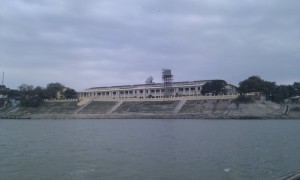
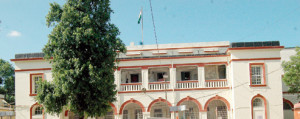 Among the principal remains of the colonial period in Bankipore are the District Collectorate, the Civil Court,
Among the principal remains of the colonial period in Bankipore are the District Collectorate, the Civil Court,
Old Mandir (Collectorate Ghat):-
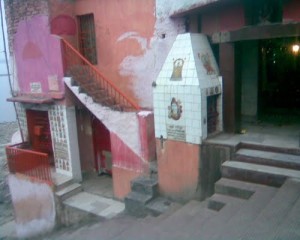 During Archaeological Exploration performed by KP Jayaswal Research Institute Early Mauryan Period site have been brought to light.
During Archaeological Exploration performed by KP Jayaswal Research Institute Early Mauryan Period site have been brought to light.
Randfurlie knox-Monument :-Lies close to the river in the compound of the Judge’s court. This tall obelisk recalls the gallant knox, who marched from Burdwan to relieve the siege of Patna by Shah Alam in the year 1760.
Major Ransfur Lee Knox of Sligo in Ireland entered the Royal Military College in Woolwich at the age of sixteen. He was from a family of military careerists and churchmen and in 1753 joined the East India Company. Arriving in Madras in 1754, Knox soon made Captain and distinguished himself as an able commander of Bengal, European and Sepoy battalions, remarkably leading his troops to relieve Patna under difficult conditions; “The length of this march is given as 300 miles, and it was made in the intense head of the Indian April, the roads were tacks enveloped in clouds of dust, the wide sandy banks of the Ganges had to be crossed twice, yet Knox, marching every yard on the way on foot to prevent grumbling on the part of his men, carried his party though in less than thirteen days. In 1763, when Knox was only thirty-three, he was appointed Lieutenant Colonel of the 2nd European Regiment, but sadly died in 1764 and was buried on the banks of the Ganges beneath the epitaph ‘the earthly remains of the truly gallant Major Randfurlie Knox’.
Magadha Mahila College :-
 Magadh mahila college constituent unit of Patna University , was established in 1946. Degree courses in many subjects in the faculties of Science, Humanities, Social Sciences and Commerce are offered in the college, besides a number of professional courses such as B.C.A., P.G. Diploma in Women and Child Development etc.
Magadh mahila college constituent unit of Patna University , was established in 1946. Degree courses in many subjects in the faculties of Science, Humanities, Social Sciences and Commerce are offered in the college, besides a number of professional courses such as B.C.A., P.G. Diploma in Women and Child Development etc.
Women’s Training College:-
 It is constituent unit of Patna University ,situated at North Gandhi Maidan, The College was established on August 15, 1951. The College offers courses under NCTE.
It is constituent unit of Patna University ,situated at North Gandhi Maidan, The College was established on August 15, 1951. The College offers courses under NCTE.
Patna International Convention Centre:-
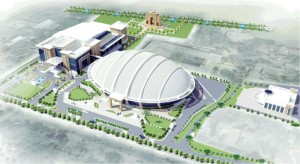 The foundation stone of the centre was laid by Nitish Kumar , the chief minister of Bihar on February 8, 2014. An around 16,500 metric tonnes of iron has been used in construction, which is more than the volume of steel used in raising Eiffel Tower. The capacity of the main auditorium is around 5000.It has four floors including basement where 450 vehicles can be parked. The height of the building has 35 meters.
The foundation stone of the centre was laid by Nitish Kumar , the chief minister of Bihar on February 8, 2014. An around 16,500 metric tonnes of iron has been used in construction, which is more than the volume of steel used in raising Eiffel Tower. The capacity of the main auditorium is around 5000.It has four floors including basement where 450 vehicles can be parked. The height of the building has 35 meters.
It has include Convention Centre cum Gyan Bhavan, Auditorium, Food Court, an Entertainment corner, VIP lounge, and an architecturally designed gate named as Sabhyata Dwar (Gate of Civilization). The complex has two parts, linked with a subway.The Sabhyata Dwar has symbolize two thousand years history of this region. It has symbolize the heritage and civilization of ancient, medieval and modern Bihar.
Building Construction Department (BCD) of the state government is the executing agency. The project report has been prepared by DDF Consultant Pvt. Ltd, a Delhi-based consulting company.
Shri Radha Krishna Shri Shankar ji Thakurbari (Ashok Rajpath):-
Gandhi Maidan :-It is centrally located in the city of Patna called the Patna Lawns during the British Raj covers about an area of about 64 acres and is well laid out with trees and footpaths. . The Gandhi Maidan is a historical place and is considered as a landmark of the city. There are many important institutes that have developed around the area of Gandhi Maidan. It is in this region that various historical movements during the independence struggle were launched. 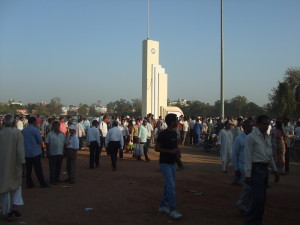
The movement against the Champaran incident was launched on this ground. One of the most significant movements in Indian independence struggle was the Quit India Movement that was launched from the Gandhi Maidan.Among the various leaders who had visited the place are Mahatma Gandhi, Sardar Patel, Maulana Abul Kalam Azad and Rajendra Prasad. The first historical meeting addressed by late Loknayak Jaiprakash Narayan held here on dated 5 June 1974 during during 74 Andolan. The grounds were used for prayer meetings and political campaigns and also other social activities. An ambitious plan of C.M Nitish Kumar is being unfolded to turn the Gandhi Maidan into a mini-paradise currently underway.The overall cost of the project is pegged at Rs 8.5 crore.
Statue of Mahatma Gandhi:-
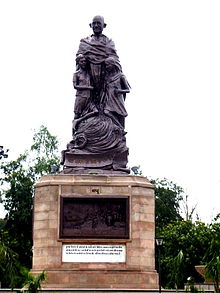 It is the world’s tallest bronze statue of Mahatma Gandhi, unveiled on 15 February 2013 by the then chief minister of Bihar , Nitish Kumar. It was established at a cost of Rs 40 crore.The statue is 72 feet (22 m) high and is located on the western end of historic Gandhi Maidan, in front of St .Xavier’s High School. It shows Mahatma Gandhi standing affectionately with two children. The pedestal is 24 feet (7.3 m) high with four landmark events of Gandhi’s life,
It is the world’s tallest bronze statue of Mahatma Gandhi, unveiled on 15 February 2013 by the then chief minister of Bihar , Nitish Kumar. It was established at a cost of Rs 40 crore.The statue is 72 feet (22 m) high and is located on the western end of historic Gandhi Maidan, in front of St .Xavier’s High School. It shows Mahatma Gandhi standing affectionately with two children. The pedestal is 24 feet (7.3 m) high with four landmark events of Gandhi’s life,
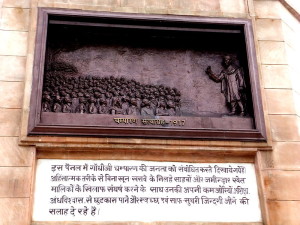 Champaran Satyagraha in 1917 and
Champaran Satyagraha in 1917 and
Dandi March 1930
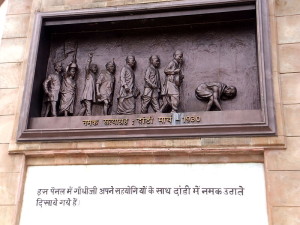
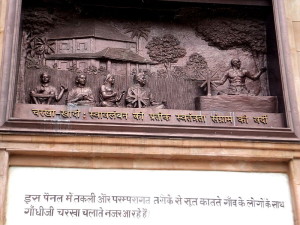 Charkha as symbol of Gandhi is inscribed on it in large letters.
Charkha as symbol of Gandhi is inscribed on it in large letters.
Kargil Martyr’s Memorial :-Kargil Chowk is a War memorial, established in year 2000, near by Gandhi Maidan, Patna. It is dedicated to Following are the martyrs whose names are engraved on Kargil Chowk war memorial.
Major Chandra Bhushan Dwivedi
General Digambar Dixit, Palamu
General Prabhakar Kumar Singh, Bhagalpur
Nayak Ganesh Prasad Yadav, Patna
Lance Naik Ram Bachan Rai, Vaishali
Lance Naik Vidyanand Singh
Naik Bishnu Rai, Saran
Naik Subedar Nageshwar Mahato, Ranchi
Naik Neeraj Kumar, Lakhisarai
Naik Sunil Kumar Singh, Muzaffarpur
Havaldar Ratan Kumar Singh, Bhagalpur
Sepoy Hardeo Prasad Singh, Nalanda
Sepoy Rambhu Singh, Siwan
Sepoy Arvind Kumar Pandey, Purvi Champaran
Sepoy Pramod Kumar, Poorvi Champaran
Sepoy Arvind Kumar Pandey, Purvi Champaran
Sepoy Raman Kumar Jha, Saharanpur
Sepoy Harikrishna Ram, Sivan
Kalidas Rangalaya :-
 It is situated East of Gandhi Maidan.The Kalidas Rangalaya was established in 1972 on land donated by then chief minister Kedarnath Pandey. Till 1981, the artistes performed under open air and later, the venue hosted performances of Divya Dutta, Heeba Shah, Shyam Sharma and Sanjna Kapoor.
It is situated East of Gandhi Maidan.The Kalidas Rangalaya was established in 1972 on land donated by then chief minister Kedarnath Pandey. Till 1981, the artistes performed under open air and later, the venue hosted performances of Divya Dutta, Heeba Shah, Shyam Sharma and Sanjna Kapoor.
Today the Kalidas Rangalaya consists of a stage, auditorium, Bihar Institute of Dramatics office and a Cafeteria, known as Annapurna. The complex also houses Shakuntala Janta Theater, Priyambada Children’s Theater, Anasuya Art Gallery and Abhyathna Guest House for guest artists. Several classes in various dance and music forms, painting, and photography are offered at the complex.
Baba Bhisham Das Ji Thakurbari ( Bakarganj)
Khairunnisa Masjid:-
St Xavier’s High School:-
 St. Xavier’s High School was established in 1940, inaugurated by the then Governor His Excellency Sir Walter Steward, on the 17th of January 1940. It is the oldest Jesuit school.
St. Xavier’s High School was established in 1940, inaugurated by the then Governor His Excellency Sir Walter Steward, on the 17th of January 1940. It is the oldest Jesuit school.
Anglican Christ Church :-North-east of Gandhi Maidan is a Anglican Church of Holy Saviour built in 1857.
Sri Krishna Memorial :-Shri Krishna Memorial Hall is a conference hall situated near by Gandhi Maidan, Patna in honour of the first Chief Minister of Bihar, Sri Krishna Sinha.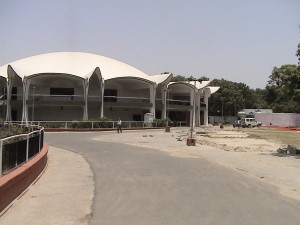
Gandhi Sangrahalaya :-
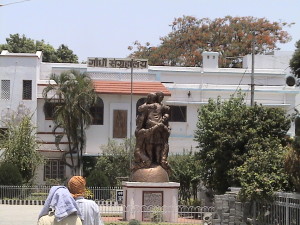
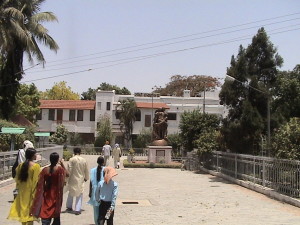 Gandhi Sangrahalaya is located on Ashok Rajpath at the north-western corner of Gandhi Maidan . The Gandhi Sangrahalaya houses a large number of items and artifacts related with Mahatma Gandhi and his satyagraha movement in Bihar. It also has a vast collection of Gandhian literature and photographs depicting his life and works. A “Charkha” (Country made spinning wheel) used by Mahatma Gandhi is also well preserved in this museum.
Gandhi Sangrahalaya is located on Ashok Rajpath at the north-western corner of Gandhi Maidan . The Gandhi Sangrahalaya houses a large number of items and artifacts related with Mahatma Gandhi and his satyagraha movement in Bihar. It also has a vast collection of Gandhian literature and photographs depicting his life and works. A “Charkha” (Country made spinning wheel) used by Mahatma Gandhi is also well preserved in this museum.
It is one of the eleven Gandhi Sangrahalaya (Gandhi Museums) in the country.The Patna Sangrahalaya was established in 1967. It was a unit of the Central Gandhi Sangrahalaya Samiti till July 1971, when the decision was taken to make the existing five units (Ahmedabad, Madurai, Bairakpore, Mumbai, Patna) as autonomous one. Since then, Gandhi Sangrahalaya, Patna is an autonomous and a self-governing institution.
A.N.Sinha Institute of Social Studies :-An interdisciplinary Research Institute enacted and financed by the Govt. of Bihar and recognized and supported by the Indian Council of Social Science Research, has been doing pioneering research with a focus on development and change.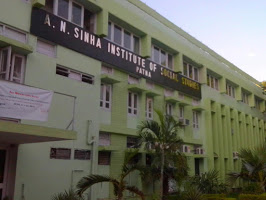
AN Sinha Institute of Social Studies makes an attempt to understand society through professional research. The state government established it in 1958 in the memory of Anugrah Narayan Sinha, one of the architects of modern Bihar. Dr Rajendra Prasad inaugurated the institute of which Golak Nath Sinha was the first director.
It has an autonomous board of members representing members from the University Grants Commission and the Indian Council for Social Science Research and is affiliated to Magadh University, Bodhgaya.
The institute will launch an integrated programme in MPhil and PhD. There is an effort to start several programmes in multi-disciplinary subjects such as centre for women studies, centre for democratic governance and planning, centre for disaster management and planning, centre for policy research, centre for international relations, centre for non-violence and peace, entrepreneurship development and others. At present, the institute offers research studies in sociology, psychology, political science and others.
A building in premises of A.N.Sinha Institute do vital role in Indian Independence. In this building during Independence struggle Mahatma Gandhi along with Simant Gandhi Khan Abdul Gaffar khan stay about 40 days. At one time it is the office of Commissioner of British Government
Former British Library :-It is situated on BP Koirala Marg. From 1960 British Council Library had been operative in Patna in Bank Road.
On 23rd June 2001, a closure notice was issued to the effect that British Library will close down on 31st July 2001. A Member Forum of 300 students who were at the forefront of struggle was formed. The actual library membership was greater than 1250.
The Forum emphatically asked for justification of the claim after 23rd June 2001, but the Library management declined to oblige them.
On 17th July 2001, a torch light procession was taken out by 300 strong Members Forum from the British Library to Dag Bungalow Chawk and an effigy of Edmund Marsden was burnt at the chawk.
Meanwhile on 16th July 2001 through the Chairman of Members Forum, the Forum filed a case in Munsif III Court, Title Suit No. 34/2001.
This Title Suit obtained a Stay Order against the dismantling of British Library on 26th July 2007.
Our Case was strong still Stay Order was vacated on 10/08/07. and the whole library was dismantled. In the process many good books were lost.
This brings to sad end to the knowledge renaissance which had started in 1960.
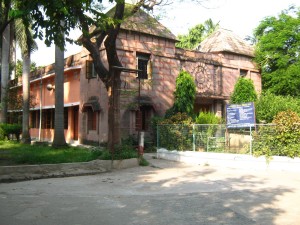 British Library is back in new avatar at RK Mission Ashram Premises , Ramakrishna Avenue, Nala Road Patna. President of ramakrishna ashrama, Rajkot, Swami Jitatmanandaji Maharaj on 19th Feb 2011 inaugurated the library annexe on the Ramakrishna Mission Ashram premises.British library has presented its entire collection of around 14,000 books to the ramakrishna mission ashram. these books now form the annexe of the library on the first floor of the mission library.
British Library is back in new avatar at RK Mission Ashram Premises , Ramakrishna Avenue, Nala Road Patna. President of ramakrishna ashrama, Rajkot, Swami Jitatmanandaji Maharaj on 19th Feb 2011 inaugurated the library annexe on the Ramakrishna Mission Ashram premises.British library has presented its entire collection of around 14,000 books to the ramakrishna mission ashram. these books now form the annexe of the library on the first floor of the mission library.
Shahid Pir Ali Khan Park :-It is a children Park located on Ashok Rajpath at the north-western corner of Gandhi Maidan in-front of DM’s residence, or Gandhi Sangrahalaya, developed by the Adam 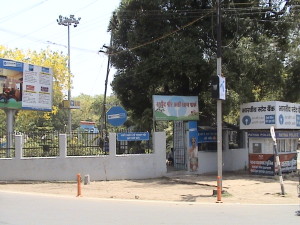 Media and Recreation Pvt.
Media and Recreation Pvt.  Limt. Patna. This park is dedicated to the martyr Pir Ali who took part in the Patna uprising during 1857 struggle for freedom.
Limt. Patna. This park is dedicated to the martyr Pir Ali who took part in the Patna uprising during 1857 struggle for freedom.
Shri Krishna Science Centre:-Shri Krishna Science Centre is established in the year 1978 in the memory of Sri Krishna Sinha , the first chief minister of Bihar. It is situated at the south-western corner of the Gandhi Maidan, opposite to the statue of Jaiprakash Narayan . It aims at creating a sense of scientific awareness among school children and local public. Various working models displayed here, relating to different branches of science, offers a deep insight into the amazing and exciting dimensions science has in daily life. A mini-planetarium provides a realistic picture of the  universe, planets and the galaxies. Working models of dinosaurs is another major attraction.the prime attractions of this science centre are the Fun Science Gallery, Vishwaroopa, and Popular Science Gallery. Fun Science Gallery holds an exhibition of the various theories of physics and mathematics. The Popular Science Gallery is the section, where interactive exhibitions of science are held. On the first floor, gallery of the Vishwaroopa holds an exhibition, which comprises an interesting mixture of biodiversity, Indian philosophy and mythologies. This gallery also hosts shows and exhibitions on evolution, which portrays the story of evolution. Images and mirrors gallery, which is the new edition to the park.This gallery will showcase various concepts of physics in the form of reflection, illusive images, 3 D images, medical imaging, concept of colours, digital and virtual imaging. The complex of this museum is also houses cafeterias and refreshment centres for the convenience of the visitors.
universe, planets and the galaxies. Working models of dinosaurs is another major attraction.the prime attractions of this science centre are the Fun Science Gallery, Vishwaroopa, and Popular Science Gallery. Fun Science Gallery holds an exhibition of the various theories of physics and mathematics. The Popular Science Gallery is the section, where interactive exhibitions of science are held. On the first floor, gallery of the Vishwaroopa holds an exhibition, which comprises an interesting mixture of biodiversity, Indian philosophy and mythologies. This gallery also hosts shows and exhibitions on evolution, which portrays the story of evolution. Images and mirrors gallery, which is the new edition to the park.This gallery will showcase various concepts of physics in the form of reflection, illusive images, 3 D images, medical imaging, concept of colours, digital and virtual imaging. The complex of this museum is also houses cafeterias and refreshment centres for the convenience of the visitors.
Biscomaun Bhawan :-
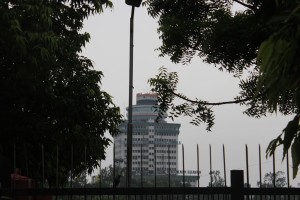 Biscomaun Bhawan , the city’s tallest building where many important government offices are situated, is at the south-western corner of the Gandhi Maidan . Recently, a Software Technology Park was opened in Biscomaun Bhawan.
Biscomaun Bhawan , the city’s tallest building where many important government offices are situated, is at the south-western corner of the Gandhi Maidan . Recently, a Software Technology Park was opened in Biscomaun Bhawan.
Revolving roof top restaurant :-
It is situated on the 18th floor of Biscomaun Tower, Gandhi Maidan.Spread over 16,000 sq. ft. of area on three floors. This is one Bihari
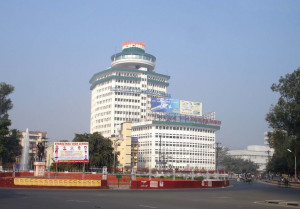 restaurant which is popular as one of the largest revolving restaurants in the country. This restaurant provides an ambience of Punjabi village, where low wooden tables and chairs with randomly-placed string cots give it a chaupal-type look.
restaurant which is popular as one of the largest revolving restaurants in the country. This restaurant provides an ambience of Punjabi village, where low wooden tables and chairs with randomly-placed string cots give it a chaupal-type look.
This revolving restaurant in Bihar is spread over three floors and has three sections like the restaurant, bar and a banquet which are over the 18th, 17th and 16th floors respectively. The restaurants banquet is on the 16th floor, which has a rooftop terrace. Apart of the local delicacies the Pind Balluchi is well known for its Punjabi cuisine, like other Pind Balluchi outlets spread across India.
Rani Sati Mandir:-
Bhartiya Nritya Kala Mandir :-
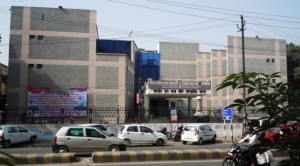 Bhartiya Nritya Kala Mandir is a Folk art museum situated near All India Radio at Chajju Bagh.The foundation stone for the institution of art was laid on December 8, 1950. Established by Padma Shri Hari Uppal, a master in Manipuri and Kathakali dance forms, it was officially opened in 1963. The building contains dance and drama studios, a gallery space and a Folk art museum. The programme of performances
Bhartiya Nritya Kala Mandir is a Folk art museum situated near All India Radio at Chajju Bagh.The foundation stone for the institution of art was laid on December 8, 1950. Established by Padma Shri Hari Uppal, a master in Manipuri and Kathakali dance forms, it was officially opened in 1963. The building contains dance and drama studios, a gallery space and a Folk art museum. The programme of performances 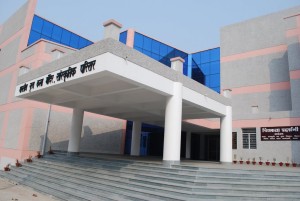 ranges from theatre, to live music, comedy, dance, visual art, spoken word and children’s events.It also provides training in the field of Classical Dance – (Kathak, Manipuri, Odissi, Bharat Natyam, etc.), Classical vocal, and Classical Instrumentals.
ranges from theatre, to live music, comedy, dance, visual art, spoken word and children’s events.It also provides training in the field of Classical Dance – (Kathak, Manipuri, Odissi, Bharat Natyam, etc.), Classical vocal, and Classical Instrumentals.
Folk art Museum, consists of folk musical instruments, costumes and jewellery. Besides, the collection also includes terracottas and ceramic specimens dated between 500 B.C. and A.D. 500, and stone sculptures belonging to Gupta and Pal periods.
Open from 16:00 and 20:00 hrs on all days except Saturdays and Government holidays.
Akashvani Patna(Chagu Bagh, Fraser Road):-The All India Radio, Patna, officially known as Akashvani, is established in the year 1948, its news wing started functioning in the year 1959. The first provincial news (Pradeshik Samachar) bulletin was broadcast on December 28, 1959 at 7 pm, which was of five-minute duration.
Sinha Library :-
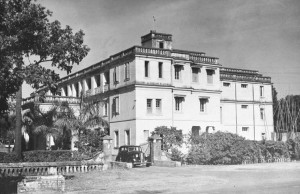 The Sinha Library in Patna is located near the main gate of the Museum. It also known as Srimati Radhika Sinha Institute Library was established in February 9, 1924 in the presence of Sir Henry Wheeler, the then governor of Bihar and Orissa. . Dr. Sachidananda Sinha built this library in the memory of his late wife Srimati Radhika Devi in a section of his own house. There are reading room, research room and newspaper reading room in the Sinha Library of Patna. Here you can read many foreign and Indian journals that the library subscribes to. In the different sections of the Sinha Library of Patna you will find books on literature, biography, sociology, history, philosophy and various other subjects.Even you can read the daily newspapers here in a calm and quite newspapers reading room. You can find out old newspapers when needed for research. Though it was once a private library, lately the administration of the Sinha Library has been undertaken by the State Government in 1955.
The Sinha Library in Patna is located near the main gate of the Museum. It also known as Srimati Radhika Sinha Institute Library was established in February 9, 1924 in the presence of Sir Henry Wheeler, the then governor of Bihar and Orissa. . Dr. Sachidananda Sinha built this library in the memory of his late wife Srimati Radhika Devi in a section of his own house. There are reading room, research room and newspaper reading room in the Sinha Library of Patna. Here you can read many foreign and Indian journals that the library subscribes to. In the different sections of the Sinha Library of Patna you will find books on literature, biography, sociology, history, philosophy and various other subjects.Even you can read the daily newspapers here in a calm and quite newspapers reading room. You can find out old newspapers when needed for research. Though it was once a private library, lately the administration of the Sinha Library has been undertaken by the State Government in 1955.
This library has Sinha’s collection of 10,000 rare books, besides some invaluable collection of newspapers like Harijan, published by Mahatma Gandhi from 1933 to 1948, Indian People, Bihari, Bihar Times, Criterion, Searchlight, Leader, Aryavarta, Weekly Hindustan and Indian Nation. Old copies of Manu Smriti, Sacred Book of the East – edited by F Max Muller, Koran, Buddhist Suttas, a copy of the original Indian constitution, and Selected works of Jawaharlal Nehru are also available there. Besides, it has books on national and international history, politics, literature etc. Books on Arya Samaj, Buddhism, Hindu cults, Puranas and Islamic scriptures are also there. Congress proceedings since 1885 and parliamentary debates since the inception of parliament are kept here.
Patna Museum :-It is located on the Buddha Marg (Old Patna Gaya road). It is also called as the Jadu Ghar. It is established in the year 1917.Built in the Indo-Saracenic architecture style with square corner towers capped by domes , the building was constructed in the year 1928 within its own measuring 700 x 500 sq.ft. The Patna Museum is a multipurpose  museum. The collection of varied nature are classified into eleven section.The Patna Museum houses a First World War cannon, metal and stone sculptures of the Mauryan and Gupta periods, Buddhist sculptures and quaint terracotta figures. The Didarganj Yakshi and the ashes of Buddha along with the 16 m long fossil of a tree of Pine family discovered near Asansol in 1927, believed to be 200 million years old are situated here which makes the museum one of its kinds in the country.The Museum has the honour to preserve a few of the important finds from the classical Harappan sites which include terracotta figurines, potteries, copper and bronze objects, seals-sealings and weights.
museum. The collection of varied nature are classified into eleven section.The Patna Museum houses a First World War cannon, metal and stone sculptures of the Mauryan and Gupta periods, Buddhist sculptures and quaint terracotta figures. The Didarganj Yakshi and the ashes of Buddha along with the 16 m long fossil of a tree of Pine family discovered near Asansol in 1927, believed to be 200 million years old are situated here which makes the museum one of its kinds in the country.The Museum has the honour to preserve a few of the important finds from the classical Harappan sites which include terracotta figurines, potteries, copper and bronze objects, seals-sealings and weights. 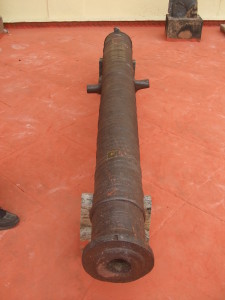
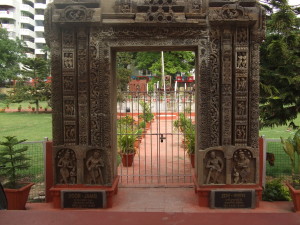 The museum displays a rich collection of Buddhist art that date back mostly to Pala period, from 8th to 12th century.Of special notice are two exceptionally beautiful statues of Avalokitesvara and Maitreya in the main gallery. The statues have their heads tilted to one side and their face conveying a gentle smile.The highly clustered stone torso of a Jain Tirthankar from Lohanipur (Patna) is the earliest example of Jaina art. The eighteen Jain bronzes from Chausa are one of the most important collection of this Museum. These consist of Dharmachakra, Kalpavriksha and sixteen images of Jain Tirthankaras. These are the earliest known Jain bronzes in India and first known bronze hoard from Gangetic valley. For the study of Jaina iconography, besides bronzes from Chausa, metal images from Alaura belonging to 11th-12th cent. A.D. are very important. Out of twenty nine, one depicts the Jain Ambika and rest the Jaina Tirthankaras.The Museum possesses the best collection of bronze, Kurkihar(Gaya), Nalanda, Belwa(Saran), Aluare(Dhanbad, Jharkhand), Sonepur(Orissa), Nagapattom(Tamil Nadu), and Nellore(Andhra Pradesh). The Museum has got good collection of coins of different period. Also to be seen in the museum is a collection of Tibetan thangkas (not in a very good state) that were donated by the renowned Indian monk, Rahul Sankrityayan. The lion head from Masarh (Bhojpur) and the bull capital from Hajipur of Mauryan period are also worth to mention.Some beautiful door frames with the figures of Ganga and Yamuna are worth watching.The pre-historic objects include palaeoliths, microliths and neoliths from different parts of Bihar and from foreign countries as well. The palaeolithic tools from Bariar (M.P.) and Lalitpur (U.P.) and also chellean and acheulean implements from Attrimpakkam (Tamil Nadu) are important. There are some fine neoliths from Bihar and Uttar Pradesh kept in the museum. The museum also displays the gifts of late Dr. Rajendra Prasad, the first President of Indian Republic, which he had received during the tenure of his Presidency.Besides the above and so many undescribed ones, there are a very rare collection housed in the Museum. The museum is open between 10.30 am to 4.30 pm everyday except Monday.
The museum displays a rich collection of Buddhist art that date back mostly to Pala period, from 8th to 12th century.Of special notice are two exceptionally beautiful statues of Avalokitesvara and Maitreya in the main gallery. The statues have their heads tilted to one side and their face conveying a gentle smile.The highly clustered stone torso of a Jain Tirthankar from Lohanipur (Patna) is the earliest example of Jaina art. The eighteen Jain bronzes from Chausa are one of the most important collection of this Museum. These consist of Dharmachakra, Kalpavriksha and sixteen images of Jain Tirthankaras. These are the earliest known Jain bronzes in India and first known bronze hoard from Gangetic valley. For the study of Jaina iconography, besides bronzes from Chausa, metal images from Alaura belonging to 11th-12th cent. A.D. are very important. Out of twenty nine, one depicts the Jain Ambika and rest the Jaina Tirthankaras.The Museum possesses the best collection of bronze, Kurkihar(Gaya), Nalanda, Belwa(Saran), Aluare(Dhanbad, Jharkhand), Sonepur(Orissa), Nagapattom(Tamil Nadu), and Nellore(Andhra Pradesh). The Museum has got good collection of coins of different period. Also to be seen in the museum is a collection of Tibetan thangkas (not in a very good state) that were donated by the renowned Indian monk, Rahul Sankrityayan. The lion head from Masarh (Bhojpur) and the bull capital from Hajipur of Mauryan period are also worth to mention.Some beautiful door frames with the figures of Ganga and Yamuna are worth watching.The pre-historic objects include palaeoliths, microliths and neoliths from different parts of Bihar and from foreign countries as well. The palaeolithic tools from Bariar (M.P.) and Lalitpur (U.P.) and also chellean and acheulean implements from Attrimpakkam (Tamil Nadu) are important. There are some fine neoliths from Bihar and Uttar Pradesh kept in the museum. The museum also displays the gifts of late Dr. Rajendra Prasad, the first President of Indian Republic, which he had received during the tenure of his Presidency.Besides the above and so many undescribed ones, there are a very rare collection housed in the Museum. The museum is open between 10.30 am to 4.30 pm everyday except Monday.
Hazrat Makhdum Kirmani Urf Data Shah Rahh Alaih Dargah Sharief (Kotwali Chauraha, Budha Marg ) :-
Kotwali Thana Building :-Kotwali Police Station was notified in 1915 to cover the New accretion. The then Lieutenant Governor though that Kotwali Police Station was a bad neoplasm’ but allowed the new commodious two-floor building for the Kotwali had staff quarters on the first floor. 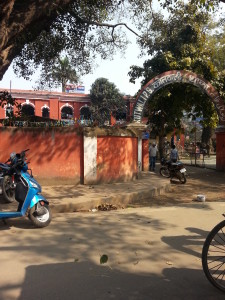 With security assured, new residential buildings started coming up all around. Across the road, the Allahabad Bank opened its first branch in a majestic building still standing.
With security assured, new residential buildings started coming up all around. Across the road, the Allahabad Bank opened its first branch in a majestic building still standing.
Dakbungalow(Lat. 250 36’ 34” N ; 850 8’ 14” E):-The site is located in the heart of the Patna. It is a chance finding. In 1991, during digging a foundation for multi-storeyed commercial building by Bihar state Government authorities few terracotta antiquities recovered by the labourers. ASI conduct a trial excavation for proper investigation of the site in 1991-92.
Two trenches measuring 55 meters and 85 mts with the orientation of north-south and east-west respectively have been undertaken for digging to ascertain the antiquarian remains of the site.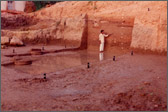
Excavation has been conducted upto a depth of 1.75 mts. after which the work was not possible due to oozing of water from the sections. The excavation yielded dump of two level formed by throwing up earth of recent period. Some terracotta balls and mixed pottery have also been collected in course of excavation. Again the digging work was resumed upto a depth of 3.40 mts. Altogether 7 layers have been encountered in course of excavation. The remains of three ring-wells are exposed. The antiquities of this trench includes terracotta balls, beads, animal figurines etc.
The ceramic industry encountered mainly N.B.P.W. and its associated wares indicate that this site was probably the western limit of the ancient Pataliputra.
Mazharul Haque Residence (Fraser road):-
Rizwan castle :-(Fraser road)
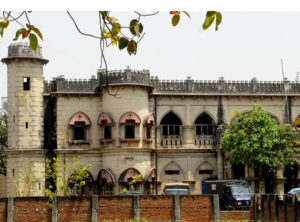 The Rizwan Castle near Dak Bungalow crossing is being used for accommodation of a small contingent of Bihar Police. Rizwan Castle was the residence of Syed Hasan Imam (1871-1933), a leading barrister-cum-politician of Patna, who designed it to resemble Tudor Castle of Scotland. It is built in the early 20th century. It is a beautiful piece of architecture where the four bastions at its four corners give it a look of the castle. This is further accentuated by the battlements on its parapet. Gothic arches were freely used all over with tracery in cross-shaped used for the windows.
The Rizwan Castle near Dak Bungalow crossing is being used for accommodation of a small contingent of Bihar Police. Rizwan Castle was the residence of Syed Hasan Imam (1871-1933), a leading barrister-cum-politician of Patna, who designed it to resemble Tudor Castle of Scotland. It is built in the early 20th century. It is a beautiful piece of architecture where the four bastions at its four corners give it a look of the castle. This is further accentuated by the battlements on its parapet. Gothic arches were freely used all over with tracery in cross-shaped used for the windows.
The Bihar State Tourism Development Corporation (BSTDC) is working on a project to converted , two of the city’s architectural marvels and heritage monuments – Sultan Palace on Beer Chand Patel Marg and Rizwan Castle on Fraser Road -into star-category hotels.The hotels will be developed in the public-private-partnership mode.
Sachidanand Sinha Residence ( Bihar school examination Board):-
Dr. Sachchidananda Sinha (November 10, 1871- March 6, 1950) was one of the eminent and noted parliamentarian, educationist, lawyer and journalist of India.
He was born in Arrah, in Bihar in a well-to-do Kayastha family. He did his study of Law at London to become a Barrister. He was hardly in his twenties, when he launched the movement for a separate Bihar, soon after returning from England as a barrister in year 1891-92. Away back in 1890 most of the people believed that it was not possible or even desirable. But, a small group of others and he persisted and the dream came true in 1911 when Bihar And Orissa came into existence as a separate province from Bengal.
In his early years was a member of the Indian National Congress from the years 1899 till 1920 and even became its Secretary once.He participated in the Home Rule League Movement.He was one of the Vice-chancellors of Patna University and held the post from years 1936 to 1944. He built the famous Sinha Library in 1924 in memory of his wife.
He was a member of the Imperial Legislative Council from 1910 to 1920 . He was Deputy President of the Assembly in 1921.He also held the office of the President in the Bihar and Orissa Legislative Council. He was appointed Executive Councillor and Finance Member of the Government of Bihar and Orissa, and, thus, was the first Indian who was ever appointed as a Finance Member of a Province. Later, he also was a member of the Bihar Legislative Assembly. In 1946, he was made the Interim President of the Constituent Assembly of India.
Patna Planetorium (Taramandal):-
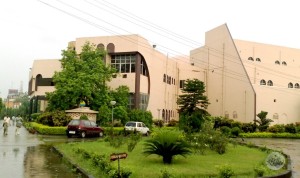 Indira Gandhi Science Complex, is one of the must visiting places in Patna located on Bailey road near Income tax office building. This is among few Planetarium’s (Taramandal) in India. It is one of the largest planetariums in Asia. The foundation stone was laid in october 1989 by former chief minister of Bihar late Satyendra Narayan Sinha and it was inaugurated in 21st March 1993 by the then C.M. of Bihar Shri Lalu Pd Yadav.The Patna Planetarium was dedicated to the Nation and opened for the public from April 1, 1993.
Indira Gandhi Science Complex, is one of the must visiting places in Patna located on Bailey road near Income tax office building. This is among few Planetarium’s (Taramandal) in India. It is one of the largest planetariums in Asia. The foundation stone was laid in october 1989 by former chief minister of Bihar late Satyendra Narayan Sinha and it was inaugurated in 21st March 1993 by the then C.M. of Bihar Shri Lalu Pd Yadav.The Patna Planetarium was dedicated to the Nation and opened for the public from April 1, 1993. 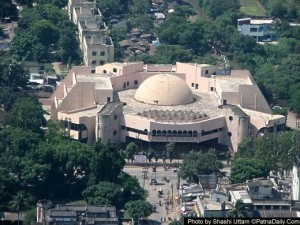 The planetarium has regular film shows on objects related to astronomy. It also holds exhibitions.
The planetarium has regular film shows on objects related to astronomy. It also holds exhibitions.
Sri Sri Radha Bankebihari Ji Temple ISKCON :-
 Sri Sri Radha Banke Bihari Ji temple is dedicated for worship of the Lord by vedic Pancharatra process. The importance of 84 pillars is well established by Shri Vishwakarma Ji himself. So, this temple will be based on 84 pillars and will be most glorious. It will consist of three deity alters.
Sri Sri Radha Banke Bihari Ji temple is dedicated for worship of the Lord by vedic Pancharatra process. The importance of 84 pillars is well established by Shri Vishwakarma Ji himself. So, this temple will be based on 84 pillars and will be most glorious. It will consist of three deity alters.
Sri Sri Gaur Nitai – Consists of Lord Chaitanya Mahaprabhu & Lord Sri Nityananda Prabhu
Sri Sri Radha Banke Bihari Ji – Consists of Sri Krishna-Smt. Radha Rani & lalita-Vishakha
Sri Sri Ram Darbar – Consists of Lord Sri Ram-Janki-Laxman & Hanuman.
Its outer transparent portion will be designed in such a way that it will enlighten internally and naturally at day time, and it will throw focused light at night. Designed marble and wooden structures will show the advance art of ancient Bihar.
The above proposed temple is is under construction now.
The Proposed ISKCON Temple(Patna), is not only a temple, but also a Vedic Sanskar Kendra where all rituals, Bhajans, Kirtans, Krishan Literature and many more will be taught.
College of Art & craft:-This college was set up on January 25, 1939 at Govind Mitra Road, Patna by late Radha Mohan. India’s first president Rajendra Prasad was the first member of the management committee of the college.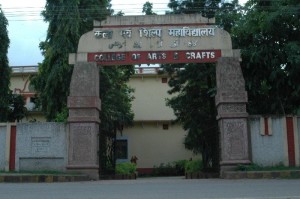 In 1949, the Bihar government took over the college, and as government’s School of Arts & Crafts, it used to offer a five-year diploma course. In 1957, the school was transferred to its newly-constructed building at Vidyapati Marg in Patna. In 1972, it was renamed College of Arts & Crafts. On April 12, 1977, the college was handed over to Patna University and its diploma course was converted into a degree course. The college, located at a distance of nearly one km from Patna railway station, is an institution for advanced training in visual arts (creative and applied).
In 1949, the Bihar government took over the college, and as government’s School of Arts & Crafts, it used to offer a five-year diploma course. In 1957, the school was transferred to its newly-constructed building at Vidyapati Marg in Patna. In 1972, it was renamed College of Arts & Crafts. On April 12, 1977, the college was handed over to Patna University and its diploma course was converted into a degree course. The college, located at a distance of nearly one km from Patna railway station, is an institution for advanced training in visual arts (creative and applied).
State Art Gallery(College of arts & Crafts, Patna) :-The state Art Gallery was established in 1951 at the Patna College of Arts & crafts. The foundation stone of the Gallery was laid by Dr. Rajendra Prasad, the first president of India. The collection of paintings of renaissance, post-renaissance and modern times and foreign specimens from Nepal, Tibet and Japan has been kept in the Art Gallery. The miniature paintings are executed on paper, mica and ivory, while the contemporary ones are respectively in opal, water and pastel colours. A few graphic pictures and two figures, one each of terracotta and bronze and some black and white photographs are also noteworthy in the collection.
It is situated in front of Golghar. The school was founded by Mrs. Kamini Devi in 1892 AD in order to promote education among the girls. Starting with the primary classes, the school had only 13 student in the first batch. Within two year of its foundation, its prestige rose and girls from far areas also began arriving. Six year later, in 1898, the school was promoted to High School. Due to its constant performance, in 1914 , the school was incorporated under the government.The popularity of School increased so much that it became difficult to run the school in one shift, so in 1971, two shifts were introduced which is continuing till this day.
The School is situated in lush green campus. It has all the facilities of a modern school. It has good library, Laboratory classes and computer lab facilitated by NIC. A canteen serves the purpose on daily basis and special occasions. The class rooms are big, airy and natural lighted. There are special arrangements for the girls belonging to reserved classes and weaker section of the society. The result of the school has always been appreciable. The syllabus has been modified as per CBSE curriculum since 2008.
Sri Siyam Bihari Kunj Thakurbari (Rajapur):-
Kali Mandir(Rajapur) :-
Bansh Ghat :-
The burning ghat now has Electric Crematorium
Rajendra Ghat :-Ghat dedicated to India’s first president Dr. Rajendra Prasad, held that position for 12 years . After 12 years as president – from 1950 to 1962, Rajendra Prasad retired and was subsequently awarded the Bharat Ratna, the nation’s highest civilian honour. He spent the last months of his life at the Sadaqat Ashram in Patna.His last rituals was performed here.His memorial was built in 1955.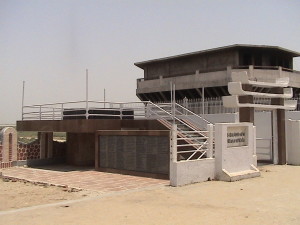
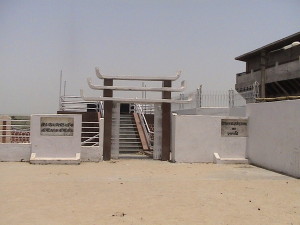
Golghar :-Alarmed by the famine of 1770, captain John Garstin built this huge granary for the British army in 1786. The massive structure is 29 m high and the walls are 3.6 m wide at the base. It has a theoretical capacity of 137,000 tons and a spectacular internal echo. 137 meter round at the base and about 33 meter in diameter. The winding stairway 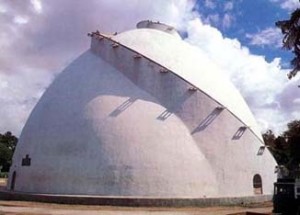 around this monument offers a brilliant panoramic view of the city and the Ganga flowing by.It is an adaptation of the classical Indian stupa architecture by the British Engineer. It is alleged that Sir Jang Bahadur of Nepal once rode a pony to the summit. There is the plaque commemorating Garstin at the base.There are ambitious plans to host a sound & light show highlighting the glorious past and exciting present of the city of pataliputra in the Golghar Complex.
around this monument offers a brilliant panoramic view of the city and the Ganga flowing by.It is an adaptation of the classical Indian stupa architecture by the British Engineer. It is alleged that Sir Jang Bahadur of Nepal once rode a pony to the summit. There is the plaque commemorating Garstin at the base.There are ambitious plans to host a sound & light show highlighting the glorious past and exciting present of the city of pataliputra in the Golghar Complex.
Akhand Vindhyavasini Temple :-The temple is located near Golghar. It is around 350 years old. It has two lamp, one filled with ghee and another with mustard oil, burning continuously for over a hundred years. The fire to start the lamp was brought from Vindhyachal.
Ganga Rail–Road Bridge(Digha):-It is a bridge across river Ganges connecting Digha Ghat in Patna and Pahleja Ghat in Sonepur. The bridge would provide easy roadway and railway link between northern and southern parts of Bihar.First trial with one engine done on 08 August 2015 is successful.
Initially sanctioned as a rail bridge, the Ganga Rail Bridge project was converted to a rail-cum-road bridge in 2006. Total cost of the project was put at Rs 13,890 million, out of which Rs8, 350 million was for the rail part, and Rs 5,540 million was for the road part.
In 1996, survey work for the proposed bridge was initiated by the Railways at three possible sites – Digha-Sonepur, Gulzarbagh-Hajipur and LCT Ghat-Sonepur. Ram Vilas Paswan was then the Union Railway Minister and he lent his support to the Gulzarbagh-Hajipur site. Lalu Prasad Yadav, then C.M of Bihar, lent his support to the Digha-Sonepur site. In the wake of the conflicting support of the political heavy weights, disturbances broke out at Sonepur. One person was shot dead. Many experts opined in favour of building the rail bridge adjacent to the Mahatma Gandhi Setu. However, political opinion prevailed and the Digha-Sonepur site was selected. Rs. 24 million was spent on the survey alone. The bridge was finally sanctioned during the term as Union Railway Minister of Nitish Kumar, present Chief Minister of Bihar.The scope of work was expanded when Lalu Prasad Yadav was the Union Railway Minister.
The construction work on the bridge was completed in August 2015, and a trial run of a diesel locomotive was undertaken on the bridge in the same month.
Ganga rail–road bridge project was executed by Icon International and the bridge was completed at ₹1,570 crore (US$240 million). The electrification work on the Patna- Sonepur-Hajipur Section was completed by July 2016. The doubling of railway tracks on the bridge will be done at an estimated cost of Rs 156.09 crore and will be completed by October 2018.
This bridge of 4,556 metres (14,948 ft) length is amongst the longest bridge in India. The total length of construction, including approaches, would be 20 km. It is a K-truss bridge. There will be two rail tracks (up and down tracks) and a two lane road.
Construction of the bridge being completed, the inaugural commercial run on the rail bridge took place on 3 February 2016. The Digha–Sonepur rail bridge was officially inaugurated by Prime Minister Narendra Modi on 12 March 2016.
The road bridge was inaugurated on 11 June 2017. Link roads to connect National Highways on both ends are still to be completed.
R.C. Cemetery:-The 280×150 feet Kurji graveyard has approximately 600 graves. The records of the necropolis date back to 1885 but the site is well maintained.
Queen of the Apostles’ Church , Kurji (Patna ):-
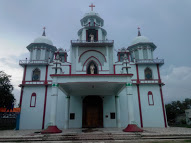 Queen of Apostles Church was inaugurated on May 31, 2009, after the old church was razed to the ground, as it could not accommodate all parish residents. Its origin and development are linked to the founding of St Michael’s High School. It was in 1890 when the Church, named Sacred Heart Church, began as a chapel for the school. Work on building a new and bigger church began in 1975. In 1977, the church was blessed and became an independent parish with a new name, Queen of the Apostles Church, Kurji.
Queen of Apostles Church was inaugurated on May 31, 2009, after the old church was razed to the ground, as it could not accommodate all parish residents. Its origin and development are linked to the founding of St Michael’s High School. It was in 1890 when the Church, named Sacred Heart Church, began as a chapel for the school. Work on building a new and bigger church began in 1975. In 1977, the church was blessed and became an independent parish with a new name, Queen of the Apostles Church, Kurji.
Sadaqat Ashram :-It is situated at the bank of the river Ganga on Patna- Danapur Road. In 1920, Maulana Mazharul Haque donated his 16 bigha land for Sadaqat Ashram and Vidya Peeth which served as college for students . Sadaqat Ashram played 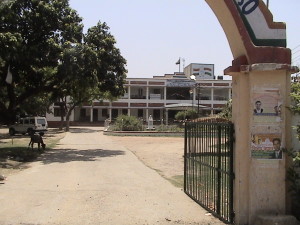 important role in Independence movement in Bihar. Sadaqat Ashram is Associated with the memories of Mahatma Gandhi, Dr. Rajendra Prasad, Mautana Mazharal Haque and other leaders.It is the headquarters of the Bihar Vidyapeeth, a National University. This place is more famous for the fact that Dr. Rajendra Prasad, the first President of India spent the last few days of his life at this place, in retirement. There is a small museum in the Sadaqat Ashram that displays his personal belongings. The museum has a well-stocked library.
important role in Independence movement in Bihar. Sadaqat Ashram is Associated with the memories of Mahatma Gandhi, Dr. Rajendra Prasad, Mautana Mazharal Haque and other leaders.It is the headquarters of the Bihar Vidyapeeth, a National University. This place is more famous for the fact that Dr. Rajendra Prasad, the first President of India spent the last few days of his life at this place, in retirement. There is a small museum in the Sadaqat Ashram that displays his personal belongings. The museum has a well-stocked library.
Sri Braj Kishor Smark Pratisthan ( At Sadaqat Ashram);-
Rajendra Smriti Sangrahalaya (At sadaqat Ashram):-
 It is a small biographical museum and a heritage building located in city of Sadaquat Ashram Patna. It is established in year 1963. It is dedicated to the life and works of Dr. Rajendra Prasad, 1st President of India
It is a small biographical museum and a heritage building located in city of Sadaquat Ashram Patna. It is established in year 1963. It is dedicated to the life and works of Dr. Rajendra Prasad, 1st President of India
Md. Majrul Hak Smark Pustakalaya (At Sadaqat Ashram):-
Balu Ghat:-During Archaeological Exploration performed by KP Jayaswal Research Institute Medieval Period site have been brought to light.
St.Michael’s High School :-
 It was founded in year 1854, by the Congregation of Irish Christian Brothers in the city of Patna.Now a day it is managed by the members of the Society of Jesus, a group of men dedicated to God’s greater glory through the service of mankind. The Society of Jesus, founded by St. Ignatius of Loyola in 1540, has been active in the field of education throughout the world since its origin.
It was founded in year 1854, by the Congregation of Irish Christian Brothers in the city of Patna.Now a day it is managed by the members of the Society of Jesus, a group of men dedicated to God’s greater glory through the service of mankind. The Society of Jesus, founded by St. Ignatius of Loyola in 1540, has been active in the field of education throughout the world since its origin.
XTTI church(digha ghat):-It is the largest church in patna.
Bihar Institute of Handicraft and Design :-Located in the Pataliputra Colony, the institute is trying to revive the old crafts and art of Bihar to modern use, especially Mithila paintings. If you are interested in seeing the revival of Mithila paintings suggested to visit it .
Small Scale Industrial Museum :-Under the Department of Industries Govt. of Bihar established a Small Scale Industrial Museum with the view of displaying the different objects collected and prepared as representatives of Small Scale Industries and there by promoting the interest of the concerned industry among the concerned artisans.
Durga Mandir (At Pani tanki Boring road) :-
A.N. College :-Anugrah Narayan College, is a constituent unit of Magadh University Bodh Gaya. It was established in the year 1956 and is situated in Boring Road ,Patna. It bears the pious name of reverend leader Dr. Anugrah Narayan Sinha, popularly known as “Babu Sahab”. 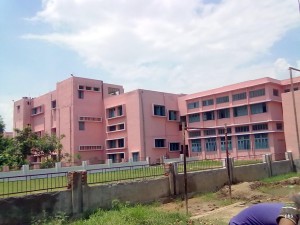 A. N. College is most centrally located in Patna at a distance of about 4Kms from the railway station and from the airport. The college compound is situated on 13 acres of land in the posh locality of Patna on the main Boring-Patliputra road. There are 13 separate blocks for housing 19 post graduate and 22 under graduate departments. In addition to this, there is a central library block, an examination hall, a canteen, a hostel, a playground, sprawling gardens and plenty of open space.
A. N. College is most centrally located in Patna at a distance of about 4Kms from the railway station and from the airport. The college compound is situated on 13 acres of land in the posh locality of Patna on the main Boring-Patliputra road. There are 13 separate blocks for housing 19 post graduate and 22 under graduate departments. In addition to this, there is a central library block, an examination hall, a canteen, a hostel, a playground, sprawling gardens and plenty of open space.
Shiva Temple ( S.K.Puri):-
Children Park (Sahdeo Mahto Marg, S.K.Puri):-
This park has a long jogging track all around the park which is used by people of all age group.The park is dotted with stone benches where one can sit and enjoy the surroundings. It has swings and slides also for children. Daily hundreds of people visit the park for jogging and relaxing with families. Being situated in the tuition hub of the City, many student visit the park in the evening. It is a bustling place during morning and evening.
Basawan Park (S.K.Puri):-
Shiva Mandir (Boring road chauk):-
Hanuman Mandir(Boring road chauk):-
Panchmukhi Hanuman Mandir (East Boring Canal Road):-
Sri Krishna Nagar Park:-
Panch Mandir (Daroga Rai Path):-
Patna High Court :-Situated on Bailey Road is a fine exercise in civic Baroque closely-modelled on the High Court at Allahabad by Frank Lishman.Internally, there is a fine marble staircase behind the pedimented entrance portico. 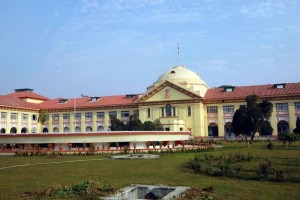 Patna high court was established on February 3, 1916 and later affiliated under the Government of India Act, 1915. The court is headquartered in Patna, the administrative capital of the state. Hon’ble Sri Justice Edward Maynard Deschamps Chamier was the first Chief Justice of Patna High Court. The foundation-stone of the High Court Building was laid on Monday, December 1, 1913 by the then Viceroy and Governor-General of India, Sir Charles Hardinge of Penshurst. The Patna High Court building on its completion was formally opened by the same Viceroy on Thursday February 3, 1916. The Patna High Court started functioning in his building on march 1,1916. This Building reflect overt renaissance influence.
Patna high court was established on February 3, 1916 and later affiliated under the Government of India Act, 1915. The court is headquartered in Patna, the administrative capital of the state. Hon’ble Sri Justice Edward Maynard Deschamps Chamier was the first Chief Justice of Patna High Court. The foundation-stone of the High Court Building was laid on Monday, December 1, 1913 by the then Viceroy and Governor-General of India, Sir Charles Hardinge of Penshurst. The Patna High Court building on its completion was formally opened by the same Viceroy on Thursday February 3, 1916. The Patna High Court started functioning in his building on march 1,1916. This Building reflect overt renaissance influence.
Patna Women’s College :-
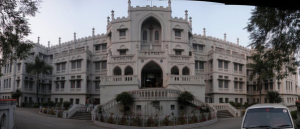 Patna Women’s College is one of the prestigious institutions of Bihar State, India. It was founded on 14 September 1940 by Bishop B. J.
Patna Women’s College is one of the prestigious institutions of Bihar State, India. It was founded on 14 September 1940 by Bishop B. J.
Sulivan.It is situated at Bailey Road, in front of Patna High Court. Its run by missionaries and is affiliated to Patna University.Initially it was allowed to teach up to Intermediate level in arts by the Senate of Patna University, but 3 years later, it started to offer courses for even higher studies. It became constituent unit of the Patna University in 1952.It is mostly known for its Arts and Vocational sections. The college started offering courses in Science only after 1988.
Hazrat Shahid Syed Gulam Safdar Pir Murad Shah (Rh) Mazar Urf Highcourt baba Mazar :-
World-class Bihar Museum:-
(A Bird’s Eye View of Proposed Bihar Museum)
The museum is coming up in nearly 13 acres area off Bailey Road here, for which six colonial-era bungalows were dismantled. The department of art, culture and youth has planned this iconic museum to focus on the contributions made by the ancient Magadha empire and the entire region of Bihar to the evolution of history and civilization in the Indian subcontinent and throughout Asia.
Nitish kumar C.M Bihar had laid the foundation stone of the museum, considered his pet project, on July 9, 2013.
CM Nitish Kumar has inaugurate the world-class Bihar Museum, estimated to be built at a cost of Rs 530 crore, on August 7, 2015. Initially, three sections of the museum – children’s section, main entrance area and orientation theatre — have be thrown open to the public.
Water Tower :-
Office of Patna Water Board, a water supply office under jurisdiction of Patna Corporation area Near Millar High School. It houses one of the tallest and oldest water towers in city. The circular water tower is a tourist attraction for it’s unique architecture.
Shaheed Suraj Narayan Singh Musem :-It is established on 17.05.2006 at building situated in 4, Veerchand Patel Path, Patna to preserve the memories of Suraj Narayan Singh, an eminent socialist leader and freedom fighter. Hon’ble Chief Minister Bihar, Shri Nitish unveiled the statue of Shaheed Suraj Narayan Singh on 14th August, 2009.
Free Opens: 10.30 am to 4.30 pm. Monday closed
Paribahan Bhawan (Sultan Palace ) :-
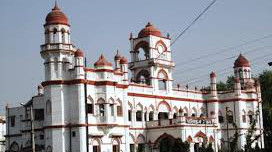 Sultan Palace is a beautiful piece of architecture in Beer Chand Patel Marg and is currently the office of State Transportation Department . This building is built in Islamic style. It was built in 1922 by Sir Sultan Ahmed and it costed approx Rs 3 Lakh and took two year time. Sultan Palace is a perfect example of Islamic architecture. Its palatial looks come from its high-domed tower in the centre and the domed pavilions at the two ends of the roof. This is further stressed by the slender minarets rising at the angles
Sultan Palace is a beautiful piece of architecture in Beer Chand Patel Marg and is currently the office of State Transportation Department . This building is built in Islamic style. It was built in 1922 by Sir Sultan Ahmed and it costed approx Rs 3 Lakh and took two year time. Sultan Palace is a perfect example of Islamic architecture. Its palatial looks come from its high-domed tower in the centre and the domed pavilions at the two ends of the roof. This is further stressed by the slender minarets rising at the angles 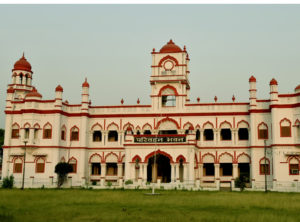 and the series of multi-foliated arches in the facade. The Haveli, as Sultan Palace is fondly called, was constructed in two parts. The front portion was meant for men while the rear one for the women.The most important portion was the drawing room in the front with a fireplace, mouldings and an ornamental ceiling painted with the gold powder.
and the series of multi-foliated arches in the facade. The Haveli, as Sultan Palace is fondly called, was constructed in two parts. The front portion was meant for men while the rear one for the women.The most important portion was the drawing room in the front with a fireplace, mouldings and an ornamental ceiling painted with the gold powder.
The Bihar State Tourism Development Corporation (BSTDC) is working on a project to take two buildings, Sultan Palace on Beer Chand Patel Marg and Rizwan Castle on Fraser Road, in its possession and convert them into royal lodging facilities. Once developed, the two monuments would be on a par with the “palace hotels” in Rajasthan.
Rabindra Bhawan :-In the year 1955, Rabindra Parishad started constructing its own building with the help of Late Sri Krishna Sinha, first Chief Minister of Bihar and completed in year 1961 . A small library of about 500 books containing volumes of Rabindra Literature and books written by him started functioning. In the year 1957, the musical wing of Rabindra Parishad named as Geeta Bhawan was started with the sole idea of imparting music specially Rabindra Sangeet and Manipuri Dance.Geeta Bhawan is affiliated to Gitabitan of Kolkata established by Gurudev.  It is also affiliated to Prayag Sangeet Samiti, Allahabad & also Pracheen Kala Kendra, Chandigarh. A renovation work of the old building had started in August 2009 and completed in 2011. About 80% of the old building was demolished to build the new structure. After renovation, the auditorium’s seating capacity has increased to 1,000. The hall has been made fully Air-conditioned and the stage has also been widened. Chief Minister Nitish Kumar inaugurated the new improved auditorium on Sunday 6.2.2011. The CM and deputy CM also honoured the engineers, architects, consultants and others who were associated with the renovation process.
It is also affiliated to Prayag Sangeet Samiti, Allahabad & also Pracheen Kala Kendra, Chandigarh. A renovation work of the old building had started in August 2009 and completed in 2011. About 80% of the old building was demolished to build the new structure. After renovation, the auditorium’s seating capacity has increased to 1,000. The hall has been made fully Air-conditioned and the stage has also been widened. Chief Minister Nitish Kumar inaugurated the new improved auditorium on Sunday 6.2.2011. The CM and deputy CM also honoured the engineers, architects, consultants and others who were associated with the renovation process.
New Patna Club:-With the establishment of the high court at Patna in 1917, the English judges and English-educated barristers took the initiative to set up a new club (patna already had Bankipore Club) . On New Year’s Day in 1918, judges E P Chapman and F Roe, Mazharul Haque, Syed Sultan Ahmed, Syed Hasan Imam, P R Das and Sachchidanand Sinha met Sir Edward Albert Gait, the then Lt Governor of Bihar and Orissa, and within a fortnight a plot of land extending from the present Beer Chand Patel Path, then called Gardiner Road, was selected and leased out for the club on an annual rental of Rs one. But the plot was less than required. Sir Sultan Ahmed then came forward to help by surrendering a large portion of the land from the compound of his Sultan Palace adjoining the club land.
This club was named New Patna Club. Duly registered in March 1918, the club was formally established the following year, 1919. It was essentially an evening club where people activated the day’s club life with a game of tennis in the afternoon. This was followed by the arrival after sunset of members fond of billiards, bridge. A quiet drink in the bar and perhaps dinner rounded off the evening well spent.The lush green grass courts of New Patna Club were to even host a Davis Cup tie between India and Pakistan later. The clubhouse has lounges and a family room too. The well-stocked bar and the sprawling lawns, tennis courts and the large swimming pool, which was added later, add to the beautiful ambiance of this club. It has also emerged as a favourite venue to host wedding receptions in this fast-expanding city where open space is now at a premium. New Patna Club is affiliated to 63 top clubs across the country.
IEI Bihar Centrec(Kranti Marg, Near R-Block Chauraha):-“We design, we construct, we observe, we initiate, we drive, we move, we accelerate the world, we are the gears of progress, we are the future of the nation, we are the engineers, and I am proud to be an engineer”, it is the thought of the IEI.
The Institution has more than 120 State and Local Centres, located at capital cities and towns of industrial and academic importance. In addition to that IEI has five Overseas Chapters in the Middle East. These centers are organizing various technical activitieslocally under the guidelines of the Council.
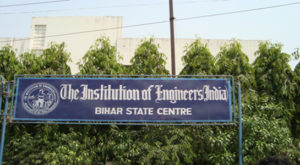 IEI Bihar Centre is one of them. Bihar State Centre has two local Centres: Muzafferpur Local Centre and Baruni Local Centre.
IEI Bihar Centre is one of them. Bihar State Centre has two local Centres: Muzafferpur Local Centre and Baruni Local Centre.
The Institution was further diversified in search of avenues of services to the nation. In this context The Institution of Engineers (India) has opened its limbs in the form of Fora and Organs.
- Engineering Staff College of India (ESCI):- It is situated at Old Bombey Road, Gachipowli; Hyderabad (Telangana-500032).It is established in 1981, to serve as a nucleus for assisting the engineering fraternity to keep itself abreast of the advances in the area of the science and technology.
- National Design and Reseach Forum (NDRF):- It is situated at 3Dr Ambedkar Veedhi Banglalore-560001. It is established in 1985, to provide a national platform for promotion of design, research and development in a multi-dimensional framework and for useful interaction between designs, research and development and construction engineering with encouragement to and recognition of creative design talents by presentation National design awards every year.
- Water Management Forum (WMF):- It is situated at Bjalokaka Bhavan, Law College Road, Ahmedabad-380006. It is established in 1986, to promote and advance the engineering and practice of economic and cost effective management of water resources in its totality. The activities and services have attracted the attention of Central Government and a number of State Governments.
- Rural Development Forum (RDF):- It is situated at 8, Gokhale Road, Kalata-700020. IT is established in 1985, for developing and promoting newer technologies, such as, non conventional energy, bio gas plant, solar cookers, improved Chulas, etc. For multi-faceted development of rural India.
- Sustainable Development Forum (SDF):- It is situated at Kranti Marg, Near R-Block Chauraha in Bihar Centre. It is established in 1998, for developing and promoting advancement of engineering for sustainable development in totality. The Forum will not only undertake specific programmes pertaining to sustainable development in collaboration with central and state governments but will also evolve and make policy recommendations in the field of sustainable development.
- Safety & Quality Forum (SQF):- It is situated at Bahadur Shah Zafer Marg, New Delhi-110002. It is established in Octuber 2003, to promote and propagate the concept of Safety and Quality through networking mechanism, assist industrial/government unit in undertaking quality and/or safety audits and develop courses, syllabi and course materials for ‘Safety Engineering’, ‘Quality Management’ and ‘Reliability Engineering’ for different levels of engineering education and recommend the same to educational authorities/institutions.
The Institution of Engineers (India) IEI has entered into an Agreement of Cooperation with the following professional bodies functioning in the country,
- Consulting Engineers Assocation of India (CEAI),
- World Energy Council-India Member Committee (WEC-IMC),
- The institute of Electronics and Telecommunication Engineer (IEIE),
- The Computer Society of India (CSI),
- Centre for Innovatons in Public Systems (CIPS),
- Indian Society for Technical The Institution of Engineers (India) IEI has entered into an Agreement of Cooperation with verious professional bodies functioning in the country, in the interest of the engineering profession and the fraternity at large, and also to promote the development of a closer working relationship with these organizations for mutual benefit of the members of both the organizations.
The Institution of Engineers (India) IEI has been associated with the various International professional bodies, as a member organization representing India, for several years altogether, with the objective of the advancement of engineering profession and the fraternity at large, and also to promote the development of a closer working relationship with these organizations for a closer interaction on the topics of significance and professional relevance.
The Institution of Engineers (India) IEI has entered into an Agreement of Cooperation with the verious professional bodies all over the world, in the interest of the engineering profession and the fraternity at large in both the countries, and also to promote the development of a closer working relationship with these organizations for mutual benefit of the members of both the organizations, and also to promote and enlarge the exchange of technical, scientific and professional knowledge to better serve the interests and welfare of the members, the engineering profession in general, and the public in both countries.
Martyr’s Memorial:-A bronze statue memorial to seven freedom fighters who sacrificed their lives in the Quit India Movement of August 1942. The Martyr’s Memorial is a modern sculpture facing the Secretariat, where they were shot in their attempt to host the national flag on dated 11 August 1942. It is dedicated to the following martyrs whose names are engraved :-
Late Umakant Prasad Singh. Ram Mohan Roy Seminary, Class IX. village Narendrapur, Saran
Late Ramanand Singh.of Ram Mohan Roy Seminary, Class IX. village Sahadat Nagar, Patna
Late Satish Prasad Jha. Patna Collegiate School, Class X. village Kharhara , Bhagalpur
Late Jagpati Kumar. Bihar National College, 2nd year. village Rawrathi , Gaya
Late Devi Prasad Choudhary. Miller High English School, Class IX. village Jamalpur, Silha
Late Rajendra Singh. Patna High English School, Matric. village Banwarchak , Saran
Late Ram Govind Singh. Punpun High English School, class IX. village Dusartha, Patna
Goriya Math (Mithapur) :-
Jain Mandir (Mithapur) :-
Kali Mandir (Jakanpur):-
Karbigahiya Mosque:-
Legislative Assembly (Vidhan Sabha) House :-
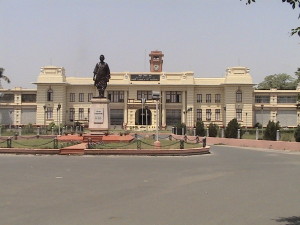 The Bihar Legislative Assembly also known as the Bihar Vidhan Sabha, is the lower house of the bicameral legislature of the Indian state of Bihar.Bihar Legislative Assembly came into existence in 1937. The construction of Legislative Assembly building was started on march 1920 and completed in that year also for this credit goes to the architect I.F.Munnings.This building reflect Indo-Saracenic influence.
The Bihar Legislative Assembly also known as the Bihar Vidhan Sabha, is the lower house of the bicameral legislature of the Indian state of Bihar.Bihar Legislative Assembly came into existence in 1937. The construction of Legislative Assembly building was started on march 1920 and completed in that year also for this credit goes to the architect I.F.Munnings.This building reflect Indo-Saracenic influence.
Legislative council (Vidhan Parishad)House :-It was during the early days of freedom struggle when a few intellectuals started a movement for separation of the State of Bihar from Bengal. On seeing the gravity of such a demand, the then Govt. of India recommended, through a letter to the Secretary of State, for the creation of a post of Lieutenant Governor for Bihar & Orissa, formation of a Legislative Council and making Patna the Capital of Bihar & Orissa. 25th August, 1911 is an important date in the parliamentary history of Bihar as on this date such a recommendation was made by the Govt. of India. The Council was formed under the Indian Councils Act 1861, Govt. of India Act 1909 (as amended in 1912) and a total of 43 members belonging to different categories were taken into it.The first sitting of the Council was convened on 20th January, 1913 at Bankipore. Another change in the parliamentary system of Bihar took place in 1917 when Bihar and Orissa were jointly called as the Governor’s Province and the Council was named as the Bihar & Orissa Legislative Council.The third and last step of parliamentary development in Bihar took place in 1936, when Bihar attained its separate statehood. Under the Govt. of India Act, 1919, the unicameral legislature got converted into a bicameral shape, that is, the Bihar Legislative Council and the Bihar Legislative Assembly.Under the Govt. of India Act, 1935 the Bihar Legislative Council consisted of 29 members. The members were elected indirectly and a few were nominated, too. By the order of the Governor, Rai Bahadur Satish Chandra Sinha became its Chairman. Later, Rajiv Ranjan Sinha was elected as the Chairman of the Bihar Legislative Council. During the period, 1939 to 1946, the BLC was not in function. In year 1938 Legislative council started functioning in this present building.
The foundation stone of the building was laid on Monday the 1st December 1913 by then Viceroy and Governor-General of India, Sir Charles Hardinge of Penshurst.
State Secretariat Buildings :-
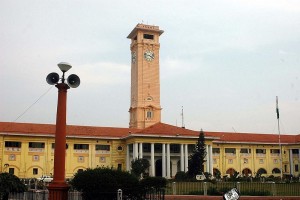 The State Secretariat Building is situated in the old part of Patna besides the Patna High Court. The sprawling building covers a huge area and houses almost all the important offices and departments of the state Government.The beside the Secretariat building , Old Secretariat building is one of the architectural marvels of the ancient city of Patna. The Old or Main Secretariat was designed by an architect, Joseph Fearis Munnings, Sydney, Australia, and built by M/s Martin Burn of Calcutta in year 1917. It is 716 feet long and 364 feet wide and remains the largest building in Patna. The architecture of the lavish building of the Old Secretariat is modeled on the lines of the Indo-Saracenic architectural style. Some parts of the building of the Old Secretariat have effects of the architectural designs of the Renaissance period. The most impressive structure within the premises of the Old Secretariat is the huge “Clock Tower”
The State Secretariat Building is situated in the old part of Patna besides the Patna High Court. The sprawling building covers a huge area and houses almost all the important offices and departments of the state Government.The beside the Secretariat building , Old Secretariat building is one of the architectural marvels of the ancient city of Patna. The Old or Main Secretariat was designed by an architect, Joseph Fearis Munnings, Sydney, Australia, and built by M/s Martin Burn of Calcutta in year 1917. It is 716 feet long and 364 feet wide and remains the largest building in Patna. The architecture of the lavish building of the Old Secretariat is modeled on the lines of the Indo-Saracenic architectural style. Some parts of the building of the Old Secretariat have effects of the architectural designs of the Renaissance period. The most impressive structure within the premises of the Old Secretariat is the huge “Clock Tower”
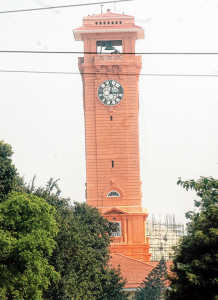 that stands tall amidst the beautiful and green lawns of the place. The “Clock Tower” is a magnificent architectural wonder of the British period that reflects the artistic skill of the British Rulers.Originally, it was 198 feet high but a part of it fell down in 1934 earthquake, reducing it to its present height of 184 feet from the ground up to the lightning conductor.In the time of the Second World War the balconies and corridors were converted into improvised rooms and this has badly impaired the character of the building.
that stands tall amidst the beautiful and green lawns of the place. The “Clock Tower” is a magnificent architectural wonder of the British period that reflects the artistic skill of the British Rulers.Originally, it was 198 feet high but a part of it fell down in 1934 earthquake, reducing it to its present height of 184 feet from the ground up to the lightning conductor.In the time of the Second World War the balconies and corridors were converted into improvised rooms and this has badly impaired the character of the building.
Ecological Park(Rajdhani Vatika) :-A dream plan of Chief Minister Mr Nitish Kumar, having jogging track and theme park was inaugurated by him on March 23, 2010, 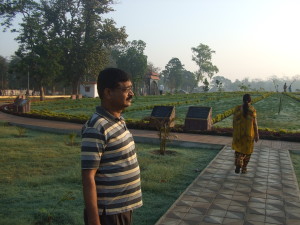 within the Secretariat campus at a simple
within the Secretariat campus at a simple 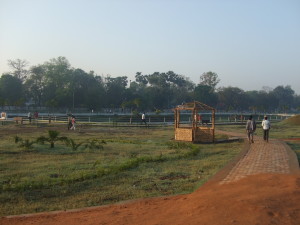 ceremony attended by Deputy Chief Minister Sushil Kumar Modi, Cooperative Minister Giriraj Singh, Water Resources Minister Vijendra Prasad Yadav, and other government officials. On the occasion, Chief Minister Mr Kumar and other VIPs planted a number of trees and plants. The second part of the Rajdhani Vatika, the Smriti Van, that was also dedicated to the public by chief minister Nitish Kumar on Sep 9, 2010.The Rajdhani Vatika, spreading over 9.2 hectares, has two main parts, namely the eco park (5.7 ha) and the Smriti Van (3.5 ha) which was developed at the cost of Rs 9.14 crore , connected each other by an underpass (Sub-Bay), first in Bihar
ceremony attended by Deputy Chief Minister Sushil Kumar Modi, Cooperative Minister Giriraj Singh, Water Resources Minister Vijendra Prasad Yadav, and other government officials. On the occasion, Chief Minister Mr Kumar and other VIPs planted a number of trees and plants. The second part of the Rajdhani Vatika, the Smriti Van, that was also dedicated to the public by chief minister Nitish Kumar on Sep 9, 2010.The Rajdhani Vatika, spreading over 9.2 hectares, has two main parts, namely the eco park (5.7 ha) and the Smriti Van (3.5 ha) which was developed at the cost of Rs 9.14 crore , connected each other by an underpass (Sub-Bay), first in Bihar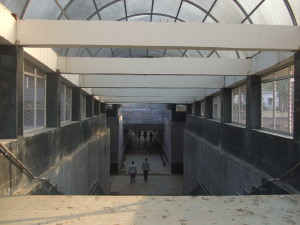 .These two parks are developed with different motives. The eco park is equipped with a jogging track, a water-body with fountains and ducks, a children’s park, a grass field and over 2,000 ornamental and shade bearing plants and trees. It has equipment for exercise as well.The Smriti Van are be a uniquely theme-based park encompassing designs from
.These two parks are developed with different motives. The eco park is equipped with a jogging track, a water-body with fountains and ducks, a children’s park, a grass field and over 2,000 ornamental and shade bearing plants and trees. It has equipment for exercise as well.The Smriti Van are be a uniquely theme-based park encompassing designs from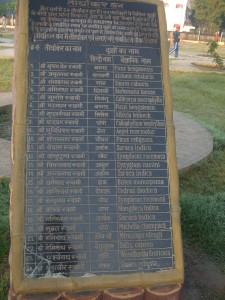 the Hindu, Islamic, Buddhist, Jain and Sikh mythologies. Nakshatra Van, Rashi Van, Panchavati Van, Buddha Vatika, Guru Vatika and Tirthankar Van are from important sections within the park.The plant species have been selected as mentioned in religious scriptures like the Puranas. Every “nakshatra” has its own tree and keeping the importance of individual trees in mind, they are planted here accordingly.
the Hindu, Islamic, Buddhist, Jain and Sikh mythologies. Nakshatra Van, Rashi Van, Panchavati Van, Buddha Vatika, Guru Vatika and Tirthankar Van are from important sections within the park.The plant species have been selected as mentioned in religious scriptures like the Puranas. Every “nakshatra” has its own tree and keeping the importance of individual trees in mind, they are planted here accordingly.
Bihar Police HQ Bhawan:-
The stone of the Bihar Police Bhawan was laid by former CM Jitan Ram Manjhi on January 7 last year.Once the eco-friendly and earthquake-resistant four-storey building is ready, all wings of the state police will have their HQ under the same roof.
The state-of-the-art facilities at the upcoming police HQ building include a rooftop helipad, open space for ceremonial parade for one company force, a safe house, an infirmary and a reception-cum-waiting hall.
Haj Bhavan:-
Hajj Bhavan is one of the beautiful buildings of recent time. It is constructed to serve to Hajj pilgrims. Construction of this building was started in 2002 and is completed in October 2007. Bihar Chief Minister Nitish Kumar inaugurated new palatial Haj building on 17th October 2007.Approx 5 and half crores of rupees has spent on it.
Maulana Mazharul Haque Arabic and Persian University (34, Ali Imam Path, Patna):–
Maulana Mazharul Haque Arabic and Persian University Patna were established under the provisions of the Bihar State Universities Act. 1976 (as amended by Bihar Act.9, 1992) with effect from 10 April 1998 (vide MHRD, Govt. of Bihar notification no. 1998 dated 22 November 2006). The Jurisdiction of this University is whole of Bihar and it is recognized under 2(f) of the UGC Act 1956. The University is enrolled as a member of Association of Indian Universities (AIU) New Delhi with effect from December 2009.
Jana-Nayak Karpoori Thakur Smriti Sangrahalaya :-
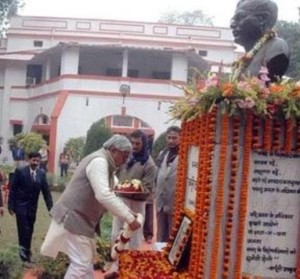 Bihar Gov. has declared 1, Deshratna Marg, the official residence of former Chief Minister late Shri Karpoori Thakur as the memorial museum in the year 1990 to commemorate the life, achievement and philosophy of the late Shri Thakur. It displays and preserves the articles of daily-use, dresses, documents, letters, diaries, writings and several other things belonging to late Shri Karpoori Thakur.There is a very good library having a very good collection of Hindi, English, Bangla and a few Urdu books on various subjects and topics which had been collected and preserved by the late-CM.
Bihar Gov. has declared 1, Deshratna Marg, the official residence of former Chief Minister late Shri Karpoori Thakur as the memorial museum in the year 1990 to commemorate the life, achievement and philosophy of the late Shri Thakur. It displays and preserves the articles of daily-use, dresses, documents, letters, diaries, writings and several other things belonging to late Shri Karpoori Thakur.There is a very good library having a very good collection of Hindi, English, Bangla and a few Urdu books on various subjects and topics which had been collected and preserved by the late-CM.
Sri Sri Panchrupa Hanuman Mandir ( Rajbanshi nagar at Bailey Road ):-
Panchmukhi hanuman mandir dedicated to lord hanuman, is a well known temple in patna located on bailey road near rajbanshi nagar. The temple is also known as shri shri panchrupa hanuman mandir. The temple is famous for the big idol of lord hanuman incarnated in “panch mukh” or five face. The temple usually remains comparatively crowded on Tuesdays and Saturdays, The days believed to be dedicated to lord hanuman and so devotees come to worship in large numbers.
Navin Park(Rajbanshi nagar):-
Indira Gandhi Institute of Medical Sciences (IGIMS):-
 IGIMS was established on 19th November 1983, as an autonomous organisation on the pattern of All India Institute of Medical Sciences, New Delhi. The objective was to provide super specialty medical facilities in Bihar. On 27th January 1983 Cabinet approved the completion of this massive project in 4 phases within a span of six (6) years. According to the decision of State Government, 130.20 Acres of land was transferred to IGIMS. It was proposed that the hospital will be completed by 1990 with a capacity to house 1000 beds. The estimated cost was 110 Crore rupees which was later revised to 133 crores .
IGIMS was established on 19th November 1983, as an autonomous organisation on the pattern of All India Institute of Medical Sciences, New Delhi. The objective was to provide super specialty medical facilities in Bihar. On 27th January 1983 Cabinet approved the completion of this massive project in 4 phases within a span of six (6) years. According to the decision of State Government, 130.20 Acres of land was transferred to IGIMS. It was proposed that the hospital will be completed by 1990 with a capacity to house 1000 beds. The estimated cost was 110 Crore rupees which was later revised to 133 crores .
IGIMS was set up with the following objectives :
To establish an apex centre for delivery of health and medical care of highest standard
To train specialists of high order in different branches of medical services
To improve the health service in the State through appropriate linkage and referral system with Medical Colleges and District and Sub divisional hospitals.
To developed the continued education programme and award degrees and certificates and Post Graduate degrees.
To develop clinical research centre for conducting investigation on the problems of human health and diseases peculiar to and prevent in this part of the country.
To developed Community Health Research Centre to study and find out solutions to the problems of health of the community with particular emphasis on reproductive biology and population control.
To develop research and training in basic sciences relevant to the problems and needs of the Community.
 It got affiliation of medical college from MCI in September 2011 for its MBBS course. First batch started from October 2011.It is 3rd medical college in patna and 10th in bihar. It is recognised to provide degree of MBBS, MD, MS, M.Ch, DM, DNB and various paramedical degrees.
It got affiliation of medical college from MCI in September 2011 for its MBBS course. First batch started from October 2011.It is 3rd medical college in patna and 10th in bihar. It is recognised to provide degree of MBBS, MD, MS, M.Ch, DM, DNB and various paramedical degrees.
Gardanibagh Thakurbari :-It is over a century old located at Gardanibagh.The management of the temple is under the supervision of Bihar State Religious Trust Board.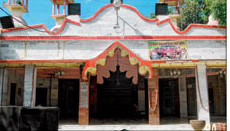
Gardanibagh Thakurbari Chitragupta Puja Samiti celebrates “Chitragupta Puja” every year perhaps since 1935. Available records suggests Dr. Rajendra Prasad as President of Chitragupta Committee and organised community feast in the year 1937 on Chitragupta Puja Day. The objective was to promote social harmony as caste tension was prevailing at that time and since then Chitragupta Puja is being organised every year in a most befitting manner. People from every walk of life particularly renowned person participates every year. It is also said that Lord Chitragupta Temple was constructed in 1945. Today “Thakurbari Chitragupta Samiti” is run under the aegis of “Gardanibagh Thakurbari Prabandhak Nyas Samiti” which has been constituted by the “Bihar State Board Of Religious Trust” through a notification issued in 1992.
Bihar Police Museum:-Bihar Police Museum is situated near the Patna Golf Club, towards the north of Jawaharlal Nehru Marg. This museum houses a unique collection of ancient arms, ammunitions and uniforms, which are often used by modern day police officers.
Golf Club :-The Patna Golf Club was established on March 21, 1916 when the Government of the Province of Bihar and Orissa had sanctioned the lease of 165 acres (0.67 km2) of land west of the Government House to the South Bihar Gymkhana Club. The club was formed by Mr. C.S. Bailey, among others, who would later become the Governor of Bihar. The first President and Secretary of the club were Mr. W. Maude and Mr. H. K. Briscoe, respectively. The annual rental of the lease was fixed at 8 annas per acre per annum.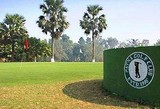
The club was kept alive by a handful of persons from the city’s upper echelons of society even after the British left. Several top mercantile houses chipped in to sustain and develop the club. By April 1968, twenty-five people formed a small organisation with a membership fee of Rs 10 per month. The group included Prem Seth, whose son Vikram was to later pen ‘A Suitable Boy’, a best selling novel about a Patna story. It is Patna’s largest golf course. This eighteen hole golf course includes one of the toughest holes is a fine place for all kind of golf lovers. Amateurs, professionals, adults and even children will like the lush green surroundings of the course.
Sanjay Gandhi Zoological and Botanical garden :-Sanjay Gandhi Biological Park, declared a protected forest by the state government, spread over 34 acres of land, is located in the well known area of Baily Road. Established in 1969 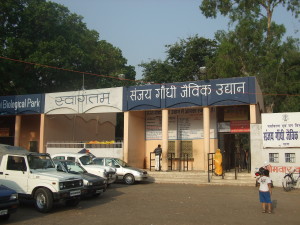 as a botanical garden, it was later developed into a biological park. It was opened to the public as a zoo in 1973, and is one of the 16 largest zoos in India and one of the biggest zoological and botanical gardens in the country.
as a botanical garden, it was later developed into a biological park. It was opened to the public as a zoo in 1973, and is one of the 16 largest zoos in India and one of the biggest zoological and botanical gardens in the country.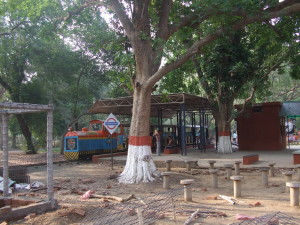 The park is home to over 300 species of trees, herbs and shrubs. There is an exclusive nursery for medicinal plants. Rose garden, orchid house and grass lawns can also be found here. Apart from this, it harbors more than 800 animals. Aquarium and snake house are the added attractions.The zoo habitat provides a healthy breeding ground for rhinos and also home to second largest rhino population in the world. It is one of the most visited site of the city and a big hit with the children.
The park is home to over 300 species of trees, herbs and shrubs. There is an exclusive nursery for medicinal plants. Rose garden, orchid house and grass lawns can also be found here. Apart from this, it harbors more than 800 animals. Aquarium and snake house are the added attractions.The zoo habitat provides a healthy breeding ground for rhinos and also home to second largest rhino population in the world. It is one of the most visited site of the city and a big hit with the children.  A fee-based cycle service is available for youngsters , beside thee battery-operated ‘golf carts’ for use buy old, physically challenged,women and children inside the zoo .The Zoological and Botanical garden is a perfect gateway to nature and wildlife amid the concrete jungle of the city.
A fee-based cycle service is available for youngsters , beside thee battery-operated ‘golf carts’ for use buy old, physically challenged,women and children inside the zoo .The Zoological and Botanical garden is a perfect gateway to nature and wildlife amid the concrete jungle of the city.
This wonderful garden remains open throughout the year for morning walker free of cost upto 8 A.M .
Brahms than(Botanical garden):-
Old Temple( Botanical Garden) :-
Raj Bhawan :-
 Designed by Munnings, The ground floor is given over to reception rooms, including the main dining and drawing rooms.The Durbar Hall and ballroom are located to the west side of the main block and rise through two storeys, overlooked by the colonnaded balconies of the first floor. By 1916–1917 was ready for occupation. This building reflect overt Renaissance influence.
Designed by Munnings, The ground floor is given over to reception rooms, including the main dining and drawing rooms.The Durbar Hall and ballroom are located to the west side of the main block and rise through two storeys, overlooked by the colonnaded balconies of the first floor. By 1916–1917 was ready for occupation. This building reflect overt Renaissance influence.
Patna Veterinary college :-Bihar Veterinary College, Patna, the 5th oldest Veterinary College in undivided India was founded on 2nd April, 1927 by Sir Henry Wheeler, the then Governor of Bihar & Orissa. The buildings were completed, laboratories were equipped and teaching & professional staff joined the alma mater in 1930. However, the college started functioning w.e.f. 7th April, 1927.
In the beginning (1930-1949), a three year diploma course was started awarding G.B.V.C. (Graduate of Bihar Veterinary College) Diploma. Keeping pace with the advancement of Science & Technology, four-year degree course awarding the degree of B.V.Sc. & A.H. was started in 1949. An emergency Diploma-Shift-Degree course was introduced in the year 1954-55. The professional competency of diploma holders was also updated by subjecting them to “Condensed degree course” of two years and awarding B.V.Sc.& A.H. degree.
For the award of diploma or degree, the Bihar Veterinary College, had been affiliated to different Universities of the state like Bihar University, Magadh University etc. The P.G. programme in different subjects of Veterinary Science and Animal Husbandry was started in 1960.
Under the provisions made through enforcement of Bihar Agricultural University Act (1971), the Bihar Veterinary College, Patna became one of the pioneer constituent colleges of Rajendra Agricultural University, Pusa, Bihar in 1971
Mariam Manzil ( Anisabad):-
Mariam Manzil deals with a Patna-based barrister, Imam Ali, who built a memorial for his second wife, Mariam.
Sun Temple (Anisabad) :-
Mata Vindhyavasini Temple (Gardanibagh):-
Sanjay Gandhi Stadium (Gardanibagh) :-
Mans Mandir( chitkohra):-
Shiv Mandir (Police colony):-
PHULWARI SHARIF BLOCK
Phulwarisharif is a satellite town of Patna strategically located between Patna and Danapur at a distance of 7 Km from Patna. The town is an important religious centre in the state. The town is well connected on the NH 98 connecting Patna with Arrah. Phulwarisharif town is spread over 6.48 sq km and is divided into 28 wards. The municipality was established in 1978.
Phulwarisharif is an important exporter of cotton yarn. Services and trade and commerce contribute maximum to the economy while agriculture also plays a significant role. Although tourism has not much contributed towards economic generation of the town yet it has immense potential for economy generation through tourism.
The present city of Phulwari Sharif constitutes majority of the Muslim population. The civilization of the city dates back to the days of inception of the Sufi culture in our country.
How to Reach
By Air (Airport):-
The nearest Airport, Patna airport which is 3 KM’s from Phulwari Sharif Block Head Quarter
By Rail:-
Phulwari Sharif railway station,(PWS) is a railway station serving the locality of Phulwari Sharif in the Patna district. The Phulwari Sharif railway station is well connected to most of the major cities in India by the railway network, which lies in between Howrah- Delhi main line which serves it with numerous numbers of trains. Phulwari Sharif is well connected to Patna, Delhi, Mumbai, Kolkata, Varanasi, Kanpur, Guwahati and other cities.
By Road:-
Phulwari Sharif is located on NH98 on the Khagaul road in Patna.
Naui Masjid(Phulwari Sharif) :-
Ali Nagar Mosque(Phulwari Sharif):-
Dargah of Shah Pashmina Posh(Phulwari Sharif) :-(Temple site)
Dargah of Minhaju’d-Din Rasti(Fulwari sarif):-(Temple site)He is Khalifa of Hazrat Makhdoom Sharfa Bihari R.A
Dargah of Lal Mian(Phulwari sharif):-Temple site
Shahi Sangi Masjid:-The Shahi Sangi Masjid bears relics of the rich architectural past of the region. Built in red sand stone by the Mughal Emperor Humayun, the Mosque is one of the main attraction for the tourist and believers of the Muslim religion. The present city of Phulwari Sharif constitutes majority of the Muslim population. The civilization of the city dates back to the days of inception of the Sufi culture in our country.
Sheesh Mahal:-
Lal miyan ki dargah:-Near the Shahi Sangi Masjid there is a shrine (Tomb) of Lal shah baba.It is known as Lal miyan ki dargah.
The Imarat-E-Shariya:-The “Imarat-E-Shariya” of Bihar is also located in the small town of Phulwari Sharif of Patna.The “Imarat-E-Shariya” is a socio-religious organization of the Islam religion that spreads the message of the “Holy Koran” through a organized chain of educational and social institutions. This socio-religious organization was established in the year 1921.The “Imarat-E-Shariya” preaches and propagates the main principles of the holy “Shariat”. The Islam religion is guided by a strict principle and codes of conduct which is inscribed in the holy “Shariat”.(1549-50).
St Mary Church(Phulwari Sharif) :-
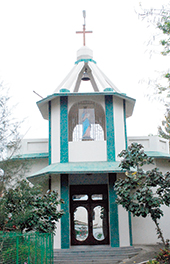 St Mary’s Church in Phulwarisharif is not just another place to pray. It is a natural energy hub.
St Mary’s Church in Phulwarisharif is not just another place to pray. It is a natural energy hub.
The church has several curved dishes of mirror, used to tap the sun’s energy. People work at a solar research and development laboratory on its campus round the year on how to use solar energy better.
All appliances in the church, runs on solar energy since 2010 .
A visit to the Solar Energy Park within St Mary’s Church compound at Phulwari Sharif, near Patna, makes one wonder at the power of the sun.
Khankah Mujibia (Phulwari Sharif) :-Phulwari Sharif is an important Islamic pilgrimage. It has been always a favorite abode of Sufi saints in various times. Hazrat Pir Mujeeb Ullah Qadri a Sufi Saints was one of those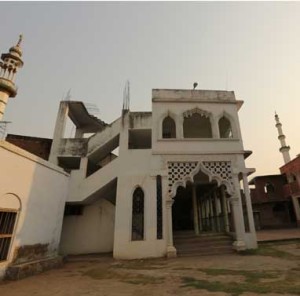 in the 18th Century. The Khankah Mujibia, founded by him at Phulwari Sharif is called the Bari Khankah. An old Madrasa here has been the most important centre for teaching of Islamic philosophy since its establishment. Sacred hairs of the beard of Paigambar Hazrat Muhammad Saheb are preserved here in Bari Khankah that attracts throngs of his followers and a big mela is held every year.
in the 18th Century. The Khankah Mujibia, founded by him at Phulwari Sharif is called the Bari Khankah. An old Madrasa here has been the most important centre for teaching of Islamic philosophy since its establishment. Sacred hairs of the beard of Paigambar Hazrat Muhammad Saheb are preserved here in Bari Khankah that attracts throngs of his followers and a big mela is held every year.
DARGAH SYED PIR MUJEEB ULLAH QUADRI R.A
The mosque of Hazrat Ataullah Zasinabi at Phulwari :-Bearing an inscription of Akbar’s time, still stands and the madrasa still continues.
Khanqah Sulaimania (Phulwari Sharif):-
Hz. Syed Shah Raihan Chisti
Dargah Hazrat Makhdoom Rasti R.A:-Every Year on 29-Dhu al-Hijjah there is an Urs at the Mazar of Hazrat Makhdoom Rasti R.A and disciple from all over India came here to tribute and get spiritual satisfaction.
Puneswar Mahadev Mandir (Punandunagar,Phulwarisharif):-
Khajpura Siva Mandir :-
Kali Mandir (Block office compound, Phulwarisharif):-
Shiv Mandir (Lachanibigha ):-This temple is 300 year old.
Adhpa:- During Archaeological Exploration performed by KP Jayaswal Research Institute Early Medieval antiquities was found here. Nizampur:-During Archaeological Exploration performed by KP Jayaswal Research Institute Early Medieval antiquities was found here. Shorampur:-During Archaeological Exploration performed by KP Jayaswal Research Institute Early Medieval Period site have been brought to light. Janipur:-During Archaeological Exploration performed by KP Jayaswal Research Institute Early Medieval Period site have been brought to light. Koriawan:-During Archaeological Exploration performed by KP Jayaswal Research Institute Early Medieval Period site have been brought to light. Koioribigha:-During Archaeological Exploration performed by KP Jayaswal Research Institute Early Medieval Period site have been brought to light. Alampur Gonpura:-During Archaeological Exploration performed by KP Jayaswal Research Institute Medieval Period site have been brought to light. Madhopur:-During Archaeological Exploration performed by KP Jayaswal Research Institute Early Medieval Period site have been brought to light. Saraiyan:-During Archaeological Exploration performed by KP Jayaswal Research Institute Early Medieval Period site have been brought to light.
Sampatchak Block
Sampatchak is a Block in Patna District of Bihar State. Sampatchak Block Head Quarters is Sampatchak town. It belongs to Patna Division. It is located 7 KM towards South from District head quarters Patna. Sampatchak Block is bounded by by Patna Block towards North, Phulwari Block towards west, Punpun Block towards South, and Fatuha Block towards East. Sampatchak consist of 47 Villages and 8 Panchayats. Hindi is the Local Language here. Also People Speaks Magahi, Maithali, Bhojpuri, English, Angika.
How to Reach
By Air (Airport):-
The nearest Airport Patna airport which is 8 KM’s from Sampatchak Block Head Quarter
By Rail:–
Parsa Bazar Rail Way Station (3.7 K.M), Rajendra Nagar Rail Way Station(6 K.M), Patna Jn Rail Way Station (7 K.M) and Sachiwalay halt Rail Way Station (7 K.M)) are the very nearby railway stations to Sampatchak Block.
By Road:-
Patna are the nearby by towns to Sampatchak having road connectivity to Sampatchak.
Popular tourist destinations
Funtasia Water Park –
 It is the first Water park in Patna. Created and promoted by Takshila Seas & Resorts Pvt. Ltd. Spread over approx.5 acres on Sampatchak- Parsa road. The work started in November, 2011 and inaugurated in October 2012, . It is just 9km away from Patna station. Funtasialand will definitely an ultimate destination and source of entertainment for all age groups.It is a rare combination of Modern Technology and traditionalist making it a kind of place for exhilarating thrills and funs.
It is the first Water park in Patna. Created and promoted by Takshila Seas & Resorts Pvt. Ltd. Spread over approx.5 acres on Sampatchak- Parsa road. The work started in November, 2011 and inaugurated in October 2012, . It is just 9km away from Patna station. Funtasialand will definitely an ultimate destination and source of entertainment for all age groups.It is a rare combination of Modern Technology and traditionalist making it a kind of place for exhilarating thrills and funs. 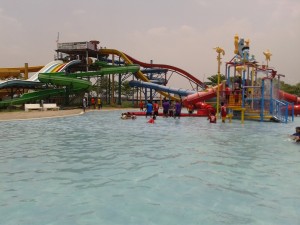 It has different types of rides for all childrens as well as adults, not only this but it also consists of wave pool, swimming pool, restaurant, coffee shop, Souvenir Shop, Banquet hall.
It has different types of rides for all childrens as well as adults, not only this but it also consists of wave pool, swimming pool, restaurant, coffee shop, Souvenir Shop, Banquet hall.
- Timing : 11 AM to 6 PM
- Wednesday closed
- Weekday fee (Monday – Friday) : Rs 300
- Weekend fee ( Saturday and Sunday) : Rs 400
Sona dih:- During Archaeological Exploration performed by KP Jayaswal Research Institute NBPW Phase site have been brought to light. Gopalpur:- During Archaeological Exploration performed by KP Jayaswal Research Institute Early Medieval Period site have been brought to light. Fatehpur:-During Archaeological Exploration performed by KP Jayaswal Research Institute Early Medieval Period site have been brought to light. Jaiber:-During Archaeological Exploration performed by KP Jayaswal Research Institute Early Medieval Period site have been brought to light. Kandap:-During Archaeological Exploration performed by KP Jayaswal Research Institute Early Medieval Period site have been brought to light. Hander:-During Archaeological Exploration performed by KP Jayaswal Research Institute NBPW Phase site have been brought to light. Taranpur:-During Archaeological Exploration performed by KP Jayaswal Research Institute Early Medieval Period site have been brought to light. Kunda:-During Archaeological Exploration performed by KP Jayaswal Research Institute Early Medieval Period site have been brought to light. Nawada:-During Archaeological Exploration performed by KP Jayaswal Research Institute Gupta Period site have been brought to light.
DANAPUR BLOCK
Danapur (also known as Dinapur Nizamat or Dinapur) is a satellite town of Patna. It is part of the Patna Metropolitan Regime. It was constituted as a municipality in 1887. The Sub-Area Headquarters of Bihar and Jharkhand is situated in the army cantonment here.
How to Reach
By Air (Airport):-
Patna Airport is the nearest airport.
By Rail:-
Danapur Station(Station Code DNR) is the main railway station of the area. It is also the divisional headquarter of the Danapur Division of the East Central railway. The town is located in the Mughalsarai – Howrah main line.
By Road:-
NH30 links the town to other cities of Bihar.
Popular tourist destinations
Manthan Church :-It is situated in khagol Medical Colony , constructed on 8 december 1907 under supervision of Father John Ohsi.
Arya samaj mandir danapur:-
Jhakhri Mahadev Mandir:-
Goraiya Mahadev:-
Mazar near contunment:-
Jhunjhunwala park Danapur:-
Thakurbari:-
Bird wach Danapur:- In monsoon and rain has rejuvenated the cantonment area of Danapur as the season has brought along with it a huge flock of migratory birds. In fact, the sub-area of the Cantonment has turned into a bird watcher’s’ delight. The tall, huge trees are home to a large number of Asian Open Bill Storks, popularly known as Jhangils, for the next four-five months. As such, the area has virtually turned into a bird sanctuary for migrating Siberian Crane locally called Janghil for laying eggs and hatching then.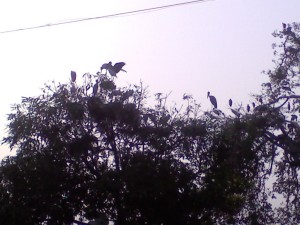
Many residents call these migratory visitors as ‘Siberian Cranes’. However, keen bird watchers and ornithologists say that though these birds belong to the family of cranes, they are not Siberian. “They are basically Open Bill Storks, who migrate from different Asian countries, especially during the monsoon, in search of wetlands.
TRIVUBAN PARK DANAPUR:-
Kali Mandir (Danapur near park):-

Ramjanki Mandir (Danapur):-
Mahbir Mandir :
Sai Baba Mandir:-
Danapur cantonment :-
 It is one of the oldest European cantonments in the region established in year 1765. It was the only white cantonment of the East India Company between at one point of time.
It is one of the oldest European cantonments in the region established in year 1765. It was the only white cantonment of the East India Company between at one point of time.
It was the largest military cantonment in Bengal, with accommodation for two batteries of artillery, a European and a native infantry regiment.Danapur cantonment located on the outskirts of Patna is the second oldest cantonment in the country after Barrackpur cantonment. West Bengal. Danapur is the regimental centre of BRC.
Gurudwara Handi Sahib :-
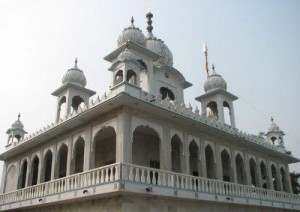 Gurdwara Handi Sahib is situated in Danapur is a cantonment area on NH 30. Guru Tegh Bahadur had returned to Punjab in April 1670 leaving his family behind at Patna. The family after leaving Patna Sahib made their first halt here. An old lady named Mai Pardhani served a kettleful (handi) of khichari to them after which the shrine subsequently built here was named as Handiwali Sangat, which is now called Gurdwara handi Sahib.
Gurdwara Handi Sahib is situated in Danapur is a cantonment area on NH 30. Guru Tegh Bahadur had returned to Punjab in April 1670 leaving his family behind at Patna. The family after leaving Patna Sahib made their first halt here. An old lady named Mai Pardhani served a kettleful (handi) of khichari to them after which the shrine subsequently built here was named as Handiwali Sangat, which is now called Gurdwara handi Sahib.
St Luke Church :-
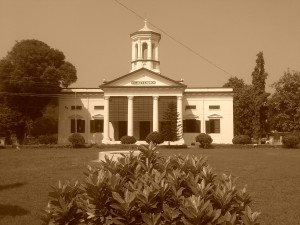 St Luke Church is one of the oldest churches in Bihar spread over an area of about an acre. Capt I Thompson had started its construction in April, 1827, but it was completed in 1830 by Capt Sage. St Luke Church, which is known for its marvellous carvings on the wooden sheets, was originally a big hall with the sitting capacity for 400 people. Plaques installed on the walls record the history of the cantonment. These plaques are dedicated to the memory of soldiers. The British retreat in Kabul and the First War of Independence in 1857 come alive in these plaques dedicated to the memory of Lt A S Bechar who fell victim to bullets of the mutineers on October 9, 1857, in Lucknow.
St Luke Church is one of the oldest churches in Bihar spread over an area of about an acre. Capt I Thompson had started its construction in April, 1827, but it was completed in 1830 by Capt Sage. St Luke Church, which is known for its marvellous carvings on the wooden sheets, was originally a big hall with the sitting capacity for 400 people. Plaques installed on the walls record the history of the cantonment. These plaques are dedicated to the memory of soldiers. The British retreat in Kabul and the First War of Independence in 1857 come alive in these plaques dedicated to the memory of Lt A S Bechar who fell victim to bullets of the mutineers on October 9, 1857, in Lucknow.
St Stephen Church :-
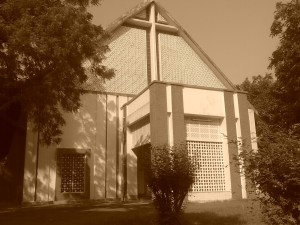 The Catholic St Stephen Church is another pride of the Danapur Cantonment. It was completed in 1854 under the supervision of Italian priests. The earthquake of 1930 had badly damaged its walls. The unique feature of this church is the Baptismal Font made of wood. While every artistic piece bears the symbol of the cross, the brass flower pots and candelabra are 138 years old. During the First War of Independence in 1857, the sisters of St Joseph with children took shelter in the Church to save their lives. They stayed in the church till August 1857. However, Mother Josephine and her sister Mathide Koch died during their confinement.
The Catholic St Stephen Church is another pride of the Danapur Cantonment. It was completed in 1854 under the supervision of Italian priests. The earthquake of 1930 had badly damaged its walls. The unique feature of this church is the Baptismal Font made of wood. While every artistic piece bears the symbol of the cross, the brass flower pots and candelabra are 138 years old. During the First War of Independence in 1857, the sisters of St Joseph with children took shelter in the Church to save their lives. They stayed in the church till August 1857. However, Mother Josephine and her sister Mathide Koch died during their confinement.
Historial building of British rule :-
Naulakha temple(bihar Regimental Centre, Danapur Cantt):-
Flag staff ghat:-Flag staff ghat on the Ganges, 1859 is one of the oldest ghats.
Kachahari ghat :-
MH ghat (Danapur):-
Syed Shahid Sash Pir Baba Mazar:-
Khanqah Chistia Nizamia (Shahtoli, Danapur):-
Hz. Dr. Syed Shah Talha Rizvi Barq
Khanqah Sajjadia Abulullaia (Danapur):-
Hz. Hz Syed Shah Saifullah Abululai
Nasriganj:-During Archaeological Exploration performed by KP Jayaswal Research Institute Early Medieval Period site have been brought to light. Chauhatta:-During Archaeological Exploration performed by KP Jayaswal Research Institute Early Medieval Period site have been brought to light. Takiapar:- During Archaeological Exploration performed by KP Jayaswal Research Institute Medieval Period site have been brought to light.
Sun Temple (Shahpur):-The Sun Temple of Shahpur has been dated to later Gupta Period (740 A.D). There is also a tank of scared to Sun God.
Daudpur:- During Archaeological Exploration performed by KP Jayaswal Research Institute Early Medieval Period site have been brought to light.
Hungama World –A water-cum-amusement park developed by Dreamline Hospitality Private Ltd at Danapur-Bihta road was inaugurated on Sunday 14th December 2014. This is the second such facility in Patna. Bollywood singer Udit Narayan inaugurated the facility.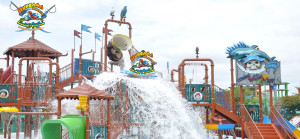
The water park section includes three slides. The tallest slide is around 150ft high. This section also has a play station and a base pool around 6ft deep. There is a section dedicated to kids called child corner, which has a baby train and a frog jump. We also have a section for archery and shooting.
Mustafapur :-The First Modern Gurukul (Most Idealistic Great Center of Learning) of Twentieth Century AD was established in the name of Vedaratna Vidyalaya at Cant. Road, Mustafapur, Khagaul, Patna by Pundit Hari Narayan Sharma.For further expansion of the aforesaid “Gurukul”, he acquired the nearby plots of land by purchasing the same at three to four times higher rate than the prevailing market price or by exchange of plots of land by giving three to four times extra land in exchange to his own co-villagers. After its expansion in the year 1915, Vedaratna Vidyalaya Gurukul became world famous great center of learning from primary level education to graduate and post graduate level education in a single campus. It became a great center of education and training of Vedic Studies, Mathematics, Science, Astronomy, Astrology, Indian Medical Science or Ayurveda, Diagnostic Science (Nadi Vigyan), Philosophy, Sanskrit Literature, Grammar, Archery, Fencing, Shooting, Wrestling, Football Training etc. It was spresd over an area of about four acres of land with all round boundary wall. It was a residential ideal educational institution with hostel facilities, Yagyashala, Conference Hall, Ayurvedic Medicine Manufacturing Unit, Ayurvedic Hospital and Playground.
The first publication of the famous Hindi News Paper ARYAVARTA was started by Pundit Hari Narayan Sharma in the year 1916 from this very premises of Vedaratna Vidyalaya Gurukul, which was printed at a press at Danapur.
In the year 1926, Higher Education Section of Vedaratna Vidyalaya Gurukul was shifted or transferred to Gurukul Mahavidyalaya, Baidyanathdham near Deoghar (Deoghar Vidyapeeth).
Subsequently, within the aforesaid old premises of the aforesaid Gurukul, he established “Veda Ratna Uchcha Vidyalaya” (Hindi – English Medium High School) and “D.A.V. Madhya Vidyalaya” (Hindi – English Medium Middle School) at Cantt. Road, Mustafapur, Khagaul, Patna in the State of Bihar (India).
In the year 1916, on his own land Pundit Hari Narayan Sharma established two famous Ayurvedic Hospitals, each of which was housed in double storey pucca buildings constructed by him over an area of about 6,000 square feet, one of which was located in front of his ancestral house at “Cantt. Road, Mustafapur, Khagaul, Patna in the State of Bihar (India), in the north of his sprawling garden of mangoes and guavas spread over an area of about one acre of land, the other such Ayurvedic Hospital was located at the township of Punpun, Patna , where apart from others, thousands of extremely poor and helpless people, irrespective of caste and religion, were used to be provided free of cost medical aid facilities.
Maner Block
Maner also spelled Maner or Maner Sharif, is a Satellite town in Patna Metropolitan Region, in the Patna district. Maner is an important tourist areas and tourism centre.It is a large village of historical antiquities, situated in the extreme north west of Danapur Sub-division, about 32 kms west of Patna on NH 30 Patna-Arrah Highway. In the early ages Maner was a centre of learning and it is said that Grammarian Panini, and also Bararuchi, lived and studied here.Maner enjoys position of one of the chief spiritual centres in India.It is well known for its Bari and Choti Dargah in the memory of Sufi saint Hazrat Makhdoom Yahya Maneri of the 13th century and his descendent Shah Makhdum Daulat. Maner is also famous for its sweet delicacy ladoos made with pure ghee called as “Maner ka Laddoo”.
Inscriptions noticed at Maner
1. Copper Plate inscription of Gahadvala king Govinda Chandra of Kanauj, dated V.S. 1183 (A.D. 1126),
2. On a dwarf wall north of the graves of the saints Hazi Nizamuddin and Haji Sharfuddin. It is dated A.H. 798 (A.D. 1396) and records original construction of a mosque by one Jalilul Haq, a celebrated saint of his age, and its rebuilding by Hammad Khatir Buzubair during the reign of Sultan Mahmud Shah (i.e. of the Tughlaq dynasty of Delhi) in A.H. 798 (A.D. 1396). Jalilul Haq was probably a son of Makhdum Yahya,
3. On the grave of Tangar Quli Khan. It is dated A.H. 983 (i.e. A.D. 1575) and records the death of Tangur Quli Khan in that year,
4. On the central gateway of Badi Dargah. It is dated A.H. 1014 (1605-06 A.D.) and records construction of the
mosque (attached to Badi Dargah),
5. On the entrance of Chhoti Dargah. It gives two dates, viz. A.H. 1017 (i.e. A.D. 1608), the date of death of Shah Daulat Maneri, the inmate of the tomb, and A.D. 1616, the date of completion of the construction of the building,
6. On the main gate of the Chhoti Dargah enclosure, recording its construction by Ibrahim Khan. Kuraishi in his list at Page 61 gives the date as 1002 A.H. (or A.D. 1593), while at Page 63 he gives the same as A.H. 982 (A.D. 1574). Hafiz Ahmad Asst Professor of Patna College (1930) gives the same date as A.H. 1032 (A.D. 1622). Bukhari however gives it as A.H. 1022 (A.D. 1613). There is also a Persian verse added to this inscription,
7. On the entrance to the mosque, attached to Chhoti Dargah enclosure, to the left of main gate of the chhoti Dargah. The inscription is damaged and is variously read by Kuraishi, Hafiz S. Ahmad and Bukhari. According to Bukhari it
records completion of the construction of the gate in A.H. 1022 ( A.D.1612),
8. On the central mihrab of the screen wall of Jami Masjid are a few inscriptions. Of them one records construction of the Jami Masjid by Maulana Abdush Shakur in the reign of emperor Aurangzeb in the year A.H. 1103 (A.D. 1691-92) and its rebuilding by one Ibrahim Khan and Khadim Ali in A.H. 1283 (A.D. 1866).
How to Reach
By Air (Airport):-The nearest Airport Patna airport which is 27 KM’s from Maner Block Head Quarter
By Rail:–Bihta Rail Way Station (7 K.M), Danapur Rail Way Station (20 K.M), Patna Jn Rail Way Station (32 K.M) and Sachiwalay halt Rail Way Station (31 K.M) are the very nearby railway stations to Maner Block.
By Road:- Maner Sharif lies 24 km west of Patna on National Highway 30.
Popular tourist destinations
Tomb of Hazrat Makhdoom Yahia Maneri (Bari Dargah) :-Hazrat Makhdoom Yahya Maneri was an Indian Sufi saint of 13th century.His complete name is Kamaaluddin Ahmed Yahya Maneri. He was son of Makhdoom Israil, son of Hazrat Imam Taj Faquih Hashmi (also called Sheikh Al Hind). His family settled in Maner which was later also called Maner Sharif. He studied Islamic law at Al-Nizamiyya of Baghdad Academy. He was a disciple of Sheikh Shahab al-Din Abu Hafs Umar al-Suhrawardi of Suhrawardiyya Sufi order. His associates include Hazrat Baha-ud-din Zakariya Multani, Shaykh Saadi Shirazi and Kamal al-Din Isma’il al-‘Isfahani and Makhdoom Shahabuddin Pir Jagjot of Balkh who settled in Jaitley near Patna. His tomb, the sacred shrine is locally known as Bari Dargah 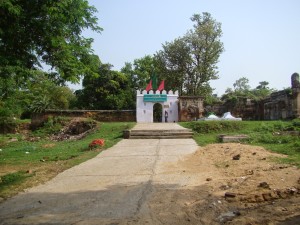 lies in courtyard of a mosque, walls and ghats, and pillared porticos jutting out into it, which is connected with the old bed of the River Sone by a Tunnel 400-ft long. The Tomb is situated in an enclosure half filled with graves and an ancient trees, on the north and west of which are a Three-Domed Mosque and some quient little cloisters built by Ibrahim Khan in 1605-06.Yahia Maneri born at Maner and died there in 1290-91A.D.This is the most secred Muslim shrine in Bihar. Like several other shrines of Sufi saints, Hazarat Makhdoom Yahya Maneri is revered both by Muslims as well as by Hindus. This shrine has remained a place of pilgrimage since very old time, and Sikandar Lodi and the Mughal emperor Babar (1520-1530) had also visited the shrine.
lies in courtyard of a mosque, walls and ghats, and pillared porticos jutting out into it, which is connected with the old bed of the River Sone by a Tunnel 400-ft long. The Tomb is situated in an enclosure half filled with graves and an ancient trees, on the north and west of which are a Three-Domed Mosque and some quient little cloisters built by Ibrahim Khan in 1605-06.Yahia Maneri born at Maner and died there in 1290-91A.D.This is the most secred Muslim shrine in Bihar. Like several other shrines of Sufi saints, Hazarat Makhdoom Yahya Maneri is revered both by Muslims as well as by Hindus. This shrine has remained a place of pilgrimage since very old time, and Sikandar Lodi and the Mughal emperor Babar (1520-1530) had also visited the shrine.
Tomb of Shah Makhadum Daulat Maneri (Chhoti Dargah) :-
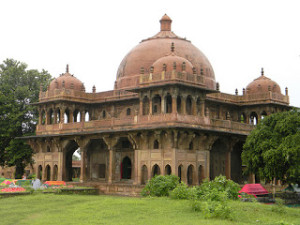 The well preserved mausoleum of a later Firdausya Shaikh, Shah Makhdum Daulat is also known as Chhoti Dargah. He is descendent of Hazrat Makhdoom Yahya Maneri. Makhdum Daulat died at Maner in 1608, and Ibrahim Kankar, the Mughal Governor of Bihar and one of the saint’s disciples completed the erection of his mausoleum in 1616. It is built within a large walled courtyard and garden in the Mughal style with extensive Chunar sandstone walls containing carvings of great delicacy and high finish. A great dome crowns it with four twelve-sided minarets in its flanks, and the ceiling is covered with carved inscriptions from the Quran. Every detail of it is characteristic of the architecture of Jehangir’s region, and it is by far the finest monument of the Mughals in Eastern India.
The well preserved mausoleum of a later Firdausya Shaikh, Shah Makhdum Daulat is also known as Chhoti Dargah. He is descendent of Hazrat Makhdoom Yahya Maneri. Makhdum Daulat died at Maner in 1608, and Ibrahim Kankar, the Mughal Governor of Bihar and one of the saint’s disciples completed the erection of his mausoleum in 1616. It is built within a large walled courtyard and garden in the Mughal style with extensive Chunar sandstone walls containing carvings of great delicacy and high finish. A great dome crowns it with four twelve-sided minarets in its flanks, and the ceiling is covered with carved inscriptions from the Quran. Every detail of it is characteristic of the architecture of Jehangir’s region, and it is by far the finest monument of the Mughals in Eastern India.
There are two inscriptions on this building including one indicating the date of death of Hazrat Makhdum Shah Daulat of Maner, whose remains lie buried in this building . The grave of Shah Daulat is in the centre of the
chamber, while that of Ibrahim Khan, the builder of the tomb is in the middle of the western gallery of the enclosure and has an inscription in Persian couplets, recording its completion by Ibrahim Khan, the builder of the main tomb.
Mosque:-Inside the west side of the compound of choti dargah there is a three-bay mosque built by Ibrahim Khan. The most striking feature of the Mosque is the absence of the usual domes in it. Instead of domes, a long arched roof has been provided, the exterior of which has been beautifully moulded into a roof slanting thatch-like on both sides,  while the interior reveals a fine arched ceiling which is supported on the pilasters that rise along the walls in relief and bend inwards, presenting an appearance of ribs in the ceiling. The designer of the building probably did not like to detract from the grandeur of the domed mausoleum, and so, designed a new type of roof for the mosque. The inscription on the mosque bears the date of 1028 A.H. (1619 A.D.)
while the interior reveals a fine arched ceiling which is supported on the pilasters that rise along the walls in relief and bend inwards, presenting an appearance of ribs in the ceiling. The designer of the building probably did not like to detract from the grandeur of the domed mausoleum, and so, designed a new type of roof for the mosque. The inscription on the mosque bears the date of 1028 A.H. (1619 A.D.)
Fine gateway :-
 Emperor Jahangir added gateway on the north of the mausoleum bearing an older inscription corresponding to 1603-01.The gate as having been beautifully designed after the usual Moghal style. However, a reading of the inscription as above suggests that the Gate may have been pre-existing and may have been suitably modeled according to the needs of the Chhoti Dargah. This is more so since there are sculptures of elephants on all balconies which suggest a Hindu origin for the Gate, as Islamic monuments of that age do not have such figures of animals. However, this seems to have missed the attention of the surveyors or they have preferred to no pay much attention to this element of surprise.
Emperor Jahangir added gateway on the north of the mausoleum bearing an older inscription corresponding to 1603-01.The gate as having been beautifully designed after the usual Moghal style. However, a reading of the inscription as above suggests that the Gate may have been pre-existing and may have been suitably modeled according to the needs of the Chhoti Dargah. This is more so since there are sculptures of elephants on all balconies which suggest a Hindu origin for the Gate, as Islamic monuments of that age do not have such figures of animals. However, this seems to have missed the attention of the surveyors or they have preferred to no pay much attention to this element of surprise.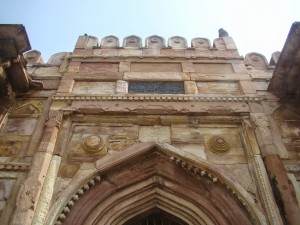
The main entrance is on the north, having guard rooms on both sides of the entrance passage and a dome above, flanked by a small octagonal tower on its either side. The entrance gate has an inscription in Arabic verse
referring to its construction in A.H. 1022 (i.e. A.D. 1613) A wide flight of stone steps from the ground leads to it, and the top portion of the gate has an inscription as follows:“
In the name of God, kind and merciful. There is no God but Allah: Muhammad is his prophet.
I was thinking of the date of this gate, My heart was living in its vicinity:
My intelligence said, by way of command, Say, ‘Whoever entered it is safe’.
When in this sacred shrine of the king, The face of decoration was completed,
I searched for its date; My intelligence, for this auspicious place,
Opened its lips in prayer and said:‘
May the gate of Daulat (Fortune) remain always open’.”
Sidaul(Figure of the tiger) :-
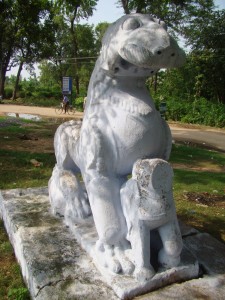
 The site where the tomb stands formerly occupied by a Hindu shrine,which the Muhammadan destroyed , purposely, it is said , leaving one of the idols to remind the people of its destruction. This is the figure of a tiger carved in stone called the Sidaul, which lies near the noble gateway of the north.
The site where the tomb stands formerly occupied by a Hindu shrine,which the Muhammadan destroyed , purposely, it is said , leaving one of the idols to remind the people of its destruction. This is the figure of a tiger carved in stone called the Sidaul, which lies near the noble gateway of the north.
Tomb of Ibrahim Khan Kakar:- The main builder of the monuments at Maner was Ibrahim Khan Kakar. He was an Afghan by race, and was a disciple of Hazrat Makhdum Shah Daulat of Manner. Abdur Rahim Khan Khanan, the renowned general of Akbar and Governor of Gujarat, also was a disciple of the same saint. Ibrahim was a poor man and in very straitened circumstances. Once, he was recommended by the saint to Khan Khanan who took him along himself to Gujarat and employed him in his army. Ibrahim proved his worth and valour, rose in the Imperial service, and in Emperor Jahangir’s time, the title of Dilawar Khan was conferred on him. He remained during the rest of the life in Kishtawar and Gujarat, and did excellent service there; as has been mentioned in the memoirs of Jahangir. He died in 1028 A.H. (1619 A.D). While in Gujarat, he planned the construction of the tank and the mausoleums at Maner and deputed a certain engineer, Tangur Kuli Khan of Badakshan, to make the project and prepare the drawings of the proposed buildings. This engineer made his plans, and probably started the construction of the tank, but he did not live long enough to see his whole project materialise. Ibrahim Khan Kakar was, however, more fortunate in this respect; for he saw the construction of all his proposed buildings, so close to his heart, fairly started; though he also died before the completion of the best of them. He died in the year 1619 A.D. as mentioned before and was buried beside his spiritual guide, Makhdum Shah Daulat of Maner.”
Tank:-
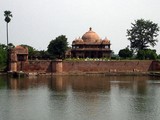 A vast water tank, or baoli, is located to the south of the mausoleum.“According to the traditions, this tank was cutcha during the Hindu period, and a large temple overlooked it on the eastern side. It was beautifully designed and made pucca with masonry and stone, during the Muhammadan period, under the orders of Ibrahim Khan Kakar. These buildings at the four ghats are not only useful and convenient to the bathers, but are also fine places for fishing, picnic and pleasure parties.
A vast water tank, or baoli, is located to the south of the mausoleum.“According to the traditions, this tank was cutcha during the Hindu period, and a large temple overlooked it on the eastern side. It was beautifully designed and made pucca with masonry and stone, during the Muhammadan period, under the orders of Ibrahim Khan Kakar. These buildings at the four ghats are not only useful and convenient to the bathers, but are also fine places for fishing, picnic and pleasure parties.
Tunnel :- A one hundred and twenty two metre long tunnel has connected the tank to the old course of the Sone River.The tunnel is 6’ in diameter and is throughout its length, arched over and provided with apertures, fitted with stone slabs at intervals for facility of periodical clearance.
Tomb of Tingur Kuli Khan :-It is situated on the bank of a tank where the stone inscription remain.Tingur died in 1575, and his tomb is now in a ruinous state, the canopy and pillars lying in broken fragments, but a stone with an inscription still remains which has been translated – Alas, that many a year when I am gone, The rose will bloom, the new spring blossom forth and those new left behind will tread my dust, Not knowing and not caring who’s it is.
Tangur Kuli Khan was the architect or engineer, who designed the tank, the Chhoti Dargah and other important buildings, but died long before the completion of these works
An old Fort :-
 The city of Manner used to form the western gate of Pataliputra, in the period of the Mauryan Empire. The work of excavation undertaken at this place unearthed some of the remains of an old fort
The city of Manner used to form the western gate of Pataliputra, in the period of the Mauryan Empire. The work of excavation undertaken at this place unearthed some of the remains of an old fort
Ancient Mound and ruined brick walls together with adjucent land comprising part of survey plot No. 608 & 611:-
Ancient Mound and ruined brick walls together with adjucent land comprising of survey plot No. 399:-
Tomb of Makhdum Shah Baran Malikul-Ulama :-Makhdum Shah Baran Malikul-ulama, was the Pir of Sher Shah. It is said the latter hastily killed the Saint for having made a false prediction, but later repented for the act. Further west from Chhoti Dargah, across the passage from the village to the tank, is the tomb of Makhdum Shah Baran Malikul-Ulama, another well known saint, who was the Pir of Sher Shah Sur. According to the local tradition, Makhdum Shah Baran once told Sher Shah that the throne of Delhi was lying vacant for him. Sher Shah took the hint and prepared for attacking Humayun, who at this time happened to be away from his capital on a hunting trip. Sher Shah, however, took a long time in making his preparations, and when he proceeded to attack Humayun, the latter had returned and was fully prepared to meet him. The result was that Sher Shah failed in his attempt and became furious that his Pir had made a false prediction. So, he returned to Manner and killed Makhdum Shah Baran. Later on, however, when he succeeded in wresting the throne of Delhi from Humayun, he recollected the prediction of his Pir and repented his hasty action. So he sent a large amount of money to his Pir’s successor and asked for pardon. The latter, however, refused to take the money, but declared that, as Sher Shah was a just king, he would go to paradise after his death; but for his great sin of killing his Pir, instead of burning in the fires of hell, he would burn to death in this world. And so it happened, for Sher Shah was burned by an explosion of his magazine while supervising the siege of the fort of Kalinjar and died shortly after.”
Tomb of Hazrat Momin Arif:-Arif was probably the earliest Muslim inhabitant of Manner. The monument is a simple grave without any building or canopy over it, at some distance on the north from the building mentioned above. The anniversary of Hazrat Momin Arif is celebrated in the month of Raniu-l-Awal with due ceremonies every year.
Tombs of Haji Safiuddin and Haji Nizamuddin :-These were two brothers and their tombs, situated near the tomb above in the south-east corner from the Inspection Bungalow, are frequently resorted to by people, especially women-folk, who are supposed to be possessed by evil spirits. They were perhaps some mystics but little is known of their history. Nearby are tombs of nine unknown persons who might likewise have been mystics.
Other buildings and tombs at Maner include
- Tomb of Mir Qitab Abdal, a nephew of Hazrat Qadir Jilani of Bagdad, and a very great saint, also known as Baba Pir Sahib.
- Tomb of Hussain Khan, a great wrestler and comrade of Taj Faqih.
- Tomb of Hazrat Jalal Maneri, a cousin of Makhdum Yahya Maneri.
- A very small mosque called as “Dhai Kangure ki Masjid” (Mosque of two and half minarets). Nothing is known of its history and builder.
Qazi Tola Tomb:- The tomb in Qazi Tola of the village, however is said to be of Hazrat Makhdum Ruknuddin Marghilani who was a teacher of Makhdum Yahya. It is thus a very old structure, standing on a small mound of earth and has an open mosque attached to it.
Khanqah Alia ( Maner Sharif):-
Hz Syed Shah Tarique Enayatullah Firdausi Maneri
Barah Gor :-A place south of the main road and west of the Police Station which is called Barah Gor (twelve tombs). This place is said to possess the efficacy of curing persons bitten by dogs; and men suffering from hydrophobia are often taken to that place and it is said they are cured of their malady.”
Mahadev Mandir (Maner)
Bahpura:- During Archaeological Exploration performed by KP Jayaswal Research Institute Medieval Period site have been brought to light. Rampur Ismail:-During Archaeological Exploration performed by KP Jayaswal Research Institute Early Medieval Period site have been brought to light. Chhitnawan:- During Archaeological Exploration performed by KP Jayaswal Research Institute Early Medieval Period site have been brought to light. Madhopur:-During Archaeological Exploration performed by KP Jayaswal Research Institute Early Medieval Period site have been brought to light. Sehalichak(Ahiyapur):-During Archaeological Exploration performed by KP Jayaswal Research Institute Medieval Period site have been brought to light. Dost Nagar:-During Archaeological Exploration performed by KP Jayaswal Research Institute NBPW Phase site have been brought to light. Khaspur:- During Archaeological Exploration performed by KP Jayaswal Research Institute Early Medieval Period site have been brought to light.
Naubatpur Block
Naubatpur Block is a satellite town of Patna. It is part of the Patna Metropolitan Regime. It is located 30 km west of Patna. Naubatpur Block is one among the 23 blocks of Patna district. According to the government register, the block number of Naubatpur is 392. The block has 96 villages
How to Reach
By Air (Airport):– Patna Airport is the nearest airport which is 16 km from Naubatpur Block.
By Rail:- Nearest railway station is Danapur which is 15 km far from here.
By Road: –
Popular tourist destinations
Naubatpur:-During Archaeological Exploration performed by KP Jayaswal Research Institute Late Medieval Period site have been brought to light.
Tomb of the father of Makhdum Sahib of Bihar Sharif (Goraila):-It is 5 km south of Naubatpur.
Pakri:-It is 1.5 kms south of Naubatpur.It is famous for Hindu pilgrims, who congregate oblation to their deceased ancestors.
Chak Nizani(Chaknagam):-During Archaeological Exploration performed by KP Jayaswal Research Institute Early Medieval Period site have been brought to light. Nakti Murat:–During Archaeological Exploration performed by KP Jayaswal Research Institute Early Medieval Period site have been brought to light. Chesi:-During Archaeological Exploration performed by KP Jayaswal Research Institute Early Medieval Period site have been brought to light. Sekhpura:-During Archaeological Exploration performed by KP Jayaswal Research Institute Early Medieval Period site have been brought to light. Pali:-During Archaeological Exploration performed by KP Jayaswal Research Institute Early Medieval Period site have been brought to light. Boipur:-During Archaeological Exploration performed by KP Jayaswal Research Institute Early Medieval Period site have been brought to light. Taret:-During Archaeological Exploration performed by KP Jayaswal Research Institute Early Medieval Period site have been brought to light. Shirwar:-During Archaeological Exploration performed by KP Jayaswal Research Institute Early Medieval Period site have been brought to light. Chichaurha:-During Archaeological Exploration performed by KP Jayaswal Research Institute Early Medieval Period site have been brought to light. Nisharpura:-During Archaeological Exploration performed by KP Jayaswal Research Institute Early Medieval Period site have been brought to light. Naubatpur Lock:-During Archaeological Exploration performed by KP Jayaswal Research Institute Early Medieval Period site have been brought to light. Parsottumpur:-During Archaeological Exploration performed by KP Jayaswal Research Institute Early Medieval Period site have been brought to light. Tegraila:-During Archaeological Exploration performed by KP Jayaswal Research Institute Early Medieval Period site have been brought to light. Alipur:-During Archaeological Exploration performed by KP Jayaswal Research Institute Early Medieval Period site have been brought to light. Rostamgani:-During Archaeological Exploration performed by KP Jayaswal Research Institute Medieval Period site have been brought to light. Rampur:-During Archaeological Exploration performed by KP Jayaswal Research Institute Early Medieval Period site have been brought to light. Bedauli:-During Archaeological Exploration performed by KP Jayaswal Research Institute Early Medieval Period site have been brought to light. Dhobia Kalapur:-During Archaeological Exploration performed by KP Jayaswal Research Institute Early Medieval Period site have been brought to light. Charra:-During Archaeological Exploration performed by KP Jayaswal Research Institute Early Medieval Period site have been brought to light. Nandiha:-During Archaeological Exploration performed by KP Jayaswal Research Institute Early Medieval Period site have been brought to light. Ramcharan Chattni (Rampur):-During Archaeological Exploration performed by KP Jayaswal Research Institute Early Medieval Period site have been brought to light. Karai:-During Archaeological Exploration performed by KP Jayaswal Research Institute Early Medieval Period site have been brought to light. Paltu Chatni:-During Archaeological Exploration performed by KP Jayaswal Research Institute Early Medieval Period site have been brought to light. Sarari:-During Archaeological Exploration performed by KP Jayaswal Research Institute Early Medieval Period site have been brought to light. Dariyapur:-During Archaeological Exploration performed by KP Jayaswal Research Institute Early Medieval Period site have been brought to light. Jaitipur:-During Archaeological Exploration performed by KP Jayaswal Research Institute Early Medieval Period site have been brought to light. Gopalpur:-During Archaeological Exploration performed by KP Jayaswal Research Institute Early Medieval Period site have been brought to light. Jalpura:-During Archaeological Exploration performed by KP Jayaswal Research Institute Early Medieval Period site have been brought to light. Pitwas:-During Archaeological Exploration performed by KP Jayaswal Research Institute Early Medieval Period site have been brought to light. Saluri:-During Archaeological Exploration performed by KP Jayaswal Research Institute Early Medieval Period site have been brought to light. Tiwari Chauk:-During Archaeological Exploration performed by KP Jayaswal Research Institute Late Medieval Period site have been brought to light. Tilu Tola(Tin Chak):-During Archaeological Exploration performed by KP Jayaswal Research Institute Early Medieval Period site have been brought to light.
Gonawan:-During Archaeological Exploration performed by KP Jayaswal Research Institute Early Medieval Period site have been brought to light. Ajwan:-During Archaeological Exploration performed by KP Jayaswal Research Institute Early Medieval Period site have been brought to light. Tiskhora:-During Archaeological Exploration performed by KP Jayaswal Research Institute Late Medieval Period site have been brought to light.Khaspur:-During Archaeological Exploration performed by KP Jayaswal Research Institute Early Medieval Period site have been brought to light.
Bihta Block
Bihta is also upcoming satellite town of Patna.
Bihta is now emerging as a new education hub in Bihar, in 2008. It is located 28 km west of Patna.
How to Reach
By Air (Airport):-
Patna Airport is the nearest airport which is 35km from Bihta Block. Bihta has one airforce base station. Airports Authority of India has planned to develop Bihta airport for international operations. In October 2016, Bihar cabinet approved the Patna master plan 2031 which envisages development of a new airport at Bihta. Bihar government is acquiring 126 acres of land for construction of the new airport. Bihar cabinet approved a budget of Rs 260 crore for the acquisition of 126 acres for Bihta airport which will be completed by October 2019. Of the 126 acres- 99 acre in Vishambhar and 27 acre in Kultupur localities from 400-odd landowners were acquired for the new airport.
By Rail: –
Bihta is the main railway station.
By Road:-
Popular tourist destinations
Indian Institute of Technology (IIT)Patna :-
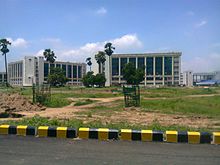 The Indian Institute of Technology Patna (abbreviated IIT Patna or IITP) is an autonomous institute of education and research in science, engineering and technology located in parameters of Amhara and Dilawarpur village of Bihta block, 35 km from Patna at a 500 acres (200 ha) site. It is recognized as an Institute of National Importance by the Government of India.
The Indian Institute of Technology Patna (abbreviated IIT Patna or IITP) is an autonomous institute of education and research in science, engineering and technology located in parameters of Amhara and Dilawarpur village of Bihta block, 35 km from Patna at a 500 acres (200 ha) site. It is recognized as an Institute of National Importance by the Government of India.  IIT Patna is part of National Knowledge Network (NKN) which provides a high speed core networking for all the knowledge related institutions in India to integrate seamlessly all of the scientific community of India. The foundation stone of the IIT Patna, Bihta Campus was laid by Kapil Sibal in 2011. IIT Patna started its new session (from July 2015) in its permanent campus located at Bihta. The campus at Bihta was inaugurated by Prime Minister Narendra Modi on 25 July 2015. Earlier, the institute was operating from a temporary 10 acres (4.0 ha) complex in Pataliputra colony, Patna, building witch have been renovated and were previously used by the Navin Government Polytechnic.
IIT Patna is part of National Knowledge Network (NKN) which provides a high speed core networking for all the knowledge related institutions in India to integrate seamlessly all of the scientific community of India. The foundation stone of the IIT Patna, Bihta Campus was laid by Kapil Sibal in 2011. IIT Patna started its new session (from July 2015) in its permanent campus located at Bihta. The campus at Bihta was inaugurated by Prime Minister Narendra Modi on 25 July 2015. Earlier, the institute was operating from a temporary 10 acres (4.0 ha) complex in Pataliputra colony, Patna, building witch have been renovated and were previously used by the Navin Government Polytechnic.
IIT Patna awards Bachelor of Technology degrees in the following disciplines: 1. Bachelor of Technology in Computer Science and Engineering , 2.Bachelor of Technology in Electrical Engineering , 3.Bachelor of Technology in Mechanical Engineering, 4.Bachelor of Technology in Civil Engineering and 5.Bachelor of Technology in Chemical Engineering .
Admission to these programs for 225 seats is through the Joint Entrance Examination (JEE)-Advanced, taken by students seeking admission into the IITs after completing 10+2 years of schooling.
The M.tech program, started in 2012, awards degrees in following disciplines:1.Master of Technology in Mathematics and Computing, 2.Master of Technology in Nanotechnology, 3.Master of Technology in Mechatronics, 4.Master of Technology in Computer Science and Engineering and 5.Master of technology in Communication Systems Engineering
IIT Patna is the first IIT in the whole IIT system to start a M.tech program in Nanotechnology. Admission to M.tech is through GATE after which an interview is held to screen the shortlisted candidates. Sponsored Candidates are not required to appear in GATE and are directly called for interview on applying for admission to M.Tech Program (if selected).
Started in 2009, Phd degrees are awarded by all the departments. Requirements for admission into the Ph.D. programs include a master’s degree and prior academic achievement. Students undergo an interview before gaining admission.
National Institute of Technology (NIT) Patna:-NIT Patna origin can be traced to 1886 with the establishment of a survey training school and subsequent renaming it to Bihar college of Engineering in 1900. A graduate level curriculum was introduced in 1924. It was renamed Bihar College of Engineering in 1932. In 2004 the government of India upgraded the college to National Institute of Technology (NIT) status. Bihar College of Engineering was the first institute to be directly upgraded to NIT status.
NIT Patna functions from a 40 acres (16 ha) campus along Ashok Rajpath. Land for a new campus, a 100 acres (40 ha) plot, has been assigned at Sikandarpur village in Bihta. Once NIT-Patna shifts to its new campus in Bihta, it will run some management courses on the present campus at Ashok Rajpath.
Netaji Subhas Institute of Technology (NSIT):-
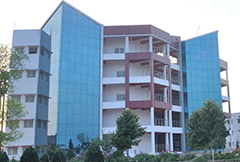 NSIT opened its new college in Amhara. It is approved by AICTE, New Delhi and recognized by Department of Science & Technology, Government of Bihar, affiliated to Aryabhatta Knowledge University Patna and State Board of Technical Education, Patna. The institution is ISO 9001:2008 Certified.
NSIT opened its new college in Amhara. It is approved by AICTE, New Delhi and recognized by Department of Science & Technology, Government of Bihar, affiliated to Aryabhatta Knowledge University Patna and State Board of Technical Education, Patna. The institution is ISO 9001:2008 Certified.
NSIT has the huge infrastructure of 1, 50,000 Sq.Ft of Built up area on approximately 12 Acres of land at Amhara, Bihta.
Employee’s State Insurance Corporation (ESIC) medical college and hospital:-Former Union minister of labour and employment M. Mallikarjun Kharge laid the foundation of the 100-seat medical college and 500-bed hospital in September 25, 2009 in the presence of Lok Sabha Speaker Meira Kumar and Bihar CM Nitish Kumar .
ESIC hospital and college is on a 25-acre plot at Bihta Village, 40 Kms. from Patna.
National Institute of Electronics and Information Technology:-NIELIT Centre, Patna was established in the year 2008 and is operational from 11th floor, Biscomaun Tower, Gandhi Maidan, Patna, with an objective to co-ordinate the activities of the various NIELIT Centres in the Eastern Region and to undertake pro-active role for promotion of NIELIT activities in the region thereby, extending the access of NIELIT to promote knowledge and skill development in Information, Electronics and Communications Technology (IECT) at various levels which will meet the requirement of the industry, thereby making the overall development of the region specially in Bihar State.
NIELIT Patna centre has been established on 26th October 2012 with objective of training, consultancy, design and product development in IECT area.
Union minister Kapil Sibal on July 3, 2013 laid the foundation stone of the permanent campus of National Institute of Electronics and Information Technology (NIELIT) at Bihta. NIELIT Patna is an Autonoumous Scientific Society under, Ministry of Electronics and Information Technology Govt of India.
Inauguration of NIELIT City Centre at Biscomaun Tower Gandhi Maidan, Patna on July 14, 2015 By Shri Ravi Shankar Prasad, Hon’ble Minister of Communications & IT in august presence of other dignitaries.
IT Park:-On the lines of Hyderabad’s Software Technology Park and Bangalore’s International Tech Park, Patna is all set to get an Information Technology (IT) Park in the heart of the city very soon.
The IT Park will be set up at Bihta, 30 km from Patna.
Bihar government has acquired 25 acres for the IT Park.
Bihta Air Force Station:-It is an Indian Air Force base. The military airfield commanded by a Group Captain rank IAF officer lies 40 kilometres southwest of state capital Patna and is spread over an area of around 900 acres.
Bhita Air Base:-The Airport Authority of India (AAI) has proposed to develop a civil enclave at this airbase to serve as the new airport for Patna. AAI has estimated a requirement of 600 acres of land for the first Phase and another 790 acres for the second Phase in lieu of the existing Lok Nayak Jayprakash Airport in Patna.
In October 2016, Bihar cabinet approved the Patna master plan 2031 which envisages development of a new airport at Bihta. Bihar government is acquiring 126 acres of land for construction of the new airport. Bihar cabinet approved a budget of Rs 260 crore for the acquisition of 126 acres for Bihta airport which will be completed by October .
Sitaram ashram (Bihta 25°33’15″N 84°52’1″E):-Sitaram ashram was set up by Swami Sahajanand Saraswati.Swami Sahajanand Saraswati (1889-1950), was born in a Jijhoutia Bhumihar Brahmin family of Gazipur of Uttar Pradesh state of India He was an ascetic (Dandi sanyasi) of Dashnami Order (Dasanami Sannyasi order) of Adi Shankara Sampradaya (a monastic post which only Brahmins can hold) as well as a nationalist and peasant leader of India. Although he was born in Uttar Pradesh (U.P.), his social and political activities centered mostly in Bihar in the initial days, and gradually spread to the rest of India with the formation of All India Kisan Sabha. He had set-up an ashram at Bihta and carried out most of his work in the later part of his life from there. He was an intellectual, prolific writer, social reformer and revolutionary all rolled into one. The Kisan Sabha movement started in Bihar under the leadership of Swami Sahajanand Saraswati who had formed in 1929 the Bihar.
Maulana Azad College Of Engineering & Technology:-It is one of the most prestigious Minority Engineering College of Bihar. The college was established in 1988 by Millat 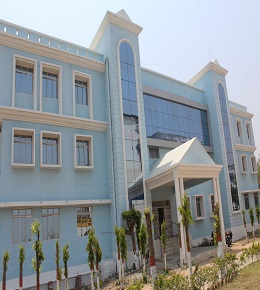 Education Society, registered under Society Registration Act 21, 1860 vide Registration No. 277 dated 19/10/1987. It is the oldest private Engineering College of Bihar. It is the oldest private Engineering College of Bihar. The college has a sprawling campus and state-of-the-art laboratories. Maulana Azad College of Engineering and Technology is a degree level Technical College, approved by AICTE, New Delhi and affiliated to Magadh University, Bodh Gaya.
Education Society, registered under Society Registration Act 21, 1860 vide Registration No. 277 dated 19/10/1987. It is the oldest private Engineering College of Bihar. It is the oldest private Engineering College of Bihar. The college has a sprawling campus and state-of-the-art laboratories. Maulana Azad College of Engineering and Technology is a degree level Technical College, approved by AICTE, New Delhi and affiliated to Magadh University, Bodh Gaya.
Baba Bihteswar Nath Temple(Bihta) :-
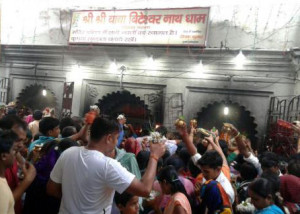
 The Temple consists four headed Shiva Linga (Chatur Mukhi Shivling) as in Pashupatinath, Kathmandu and Mahamandaleshwar, Mundeshwari Dham.It is said that Bihta was the residence of Bhan Bhat so this Temple is also called as a Bhanbhateswar temple.
The Temple consists four headed Shiva Linga (Chatur Mukhi Shivling) as in Pashupatinath, Kathmandu and Mahamandaleshwar, Mundeshwari Dham.It is said that Bihta was the residence of Bhan Bhat so this Temple is also called as a Bhanbhateswar temple.
Sheo Gang Talab(Bihta) :-
During Banbatt
Jama Masjid (Neora):-
Dihari:-During the excavation work for construction of building 1300 year old Shivling of Granite stone was found. Molahinpur:-During Archaeological Exploration performed by KP Jayaswal Research Institute Early Medieval Period site have been brought to light. Sikaiya:-During Archaeological Exploration performed by KP Jayaswal Research Institute Early Medieval Period site have been brought to light. Paharpur:-During Archaeological Exploration performed by KP Jayaswal Research Institute Late Medieval Period site have been brought to light. Shivgarh:-During Archaeological Exploration performed by KP Jayaswal Research Institute Late Medieval Period site have been brought to light. Taranagar:-During Archaeological Exploration performed by KP Jayaswal Research Institute Early Medieval Period site have been brought to light. Kauria:-During Archaeological Exploration performed by KP Jayaswal Research Institute Early Medieval Period site have been brought to light. Kujwan:-During Archaeological Exploration performed by KP Jayaswal Research Institute Medieval Period site have been brought to light. Purnia:-During Archaeological Exploration performed by KP Jayaswal Research Institute NBPW Phase site have been brought to light. Makhdumpur:-During Archaeological Exploration performed by KP Jayaswal Research Institute NBPW Phase site have been brought to light. Dikshit Chak:-During Archaeological Exploration performed by KP Jayaswal Research Institute Medieval Period site have been brought to light. Painal:-During Archaeological Exploration performed by KP Jayaswal Research Institute Late Medieval Period site have been brought to light. Tarvan:-During Archaeological Exploration performed by KP Jayaswal Research Institute NBPW Phase site have been brought to light.Parari(Yamunapur):–During Archaeological Exploration performed by KP Jayaswal Research Institute NBPW Phase site have been brought to light. Sadisopur:-During Archaeological Exploration performed by KP Jayaswal Research Institute Early Medieval Period site have been brought to light. Amahara:-During Archaeological Exploration performed by KP Jayaswal Research Institute Early Medieval Period site have been brought to light. Kanhauli:-During Archaeological Exploration performed by KP KP Jayaswal Research Institute Late Medieval Period site have been brought to light. Gokhulpur Korhar:-During Archaeological Exploration performed by KP Jayaswal Research Institute Early Medieval Period site have been brought to light. Deokuli:-During Archaeological Exploration performed by KP Jayaswal Research Institute NBPW Phase site have been brought to light. Anandpur:-During Archaeological Exploration performed by KP Jayaswal Research Institute NBPW Phase site have been brought to light.
Bikram Block
Bikram is a Nagar Panchayat city in district of Patna. It is located 36 KM towards west from District head quarters Patna.
How to Reach
By Air (Airport):-
By Rail:-
There is no railway station near to Bikram in less than 10 km. Chhotaki Masaudhi Halt Rail Way Station (near to Masaurhi) , Taregna Rail Way Station (near to Masaurhi),Bihta Railway Station are the Rail way stations reachable from near by towns. How ever Patna Jn Rail Way Station is major railway station 36 KM near to Bikram, Bihta railway Station
By Road: –
Patna Aurangabad Road SH139
Popular tourist destinations
Patut:-During Archaeological Exploration performed by KP Jayaswal Research Institute Early Medieval Period site have been brought to light.
Gorakhari:-
Temple:-
During Archaeological Exploration performed by KP Jayaswal Research Institute Early Medieval Period site have been brought to light.
Aspura Lakh:-During Archaeological Exploration performed by KP Jayaswal Research Institute Early Medieval Period site have been brought to light.
Aspura Sun Temple :-The site is a temple of the Sun god established about 30 to 35 years ago by the local people of Aspura. It is one of the popular Sun temple of Patna district
Birdhaur:-During Archaeological Exploration performed by KP Jayaswal Research Institute Early Medieval Period site have been brought to light. Barah:-During Archaeological Exploration performed by KP Jayaswal Research Institute Early Medieval Period site have been brought to light. Berar:-During Archaeological Exploration performed by KP Jayaswal Research Institute Early Medieval Period site have been brought to light.
Pakrandha:-During Archaeological Exploration performed by KP Jayaswal Research Institute Early Medieval Period site have been brought to light. Kanpa:-During Archaeological Exploration performed by KP Jayaswal Research Institute Early Medieval Period site have been brought to light. Raghunathpur:-During Archaeological Exploration performed by KP Jayaswal Research Institute Early Medieval Period site have been brought to light. Amirabad:-During Archaeological Exploration performed by KP Jayaswal Research Institute Early Medieval Period site have been brought to light. Akhtiyarpur:-During Archaeological Exploration performed by KP Jayaswal Research Institute Early Medieval Period site have been brought to light. Beni Bigha:-During Archaeological Exploration performed by KP Jayaswal Research Institute Later Gupta Period site have been brought to light. Chichaurha:-During Archaeological Exploration performed by KP Jayaswal Research Institute Early Medieval Period site have been brought to light. Jamalpur:-During Archaeological Exploration performed by KP Jayaswal Research Institute Early Medieval Period site have been brought to light. Gona:-During Archaeological Exploration performed by KP Jayaswal Research Institute Early Medieval Period site have been brought to light. Barda:-During Archaeological Exploration performed by KP Jayaswal Research Institute Early Medieval Period site have been brought to light. Saidabad:-During Archaeological Exploration performed by KP Jayaswal Research Institute Early Medieval Period site have been brought to light. Habaspur:-During Archaeological Exploration performed by KP Jayaswal Research Institute Early Medieval Period site have been brought to light. Chandani(Haibaspur):-During Archaeological Exploration performed by KP Jayaswal Research Institute NBPW Phase site have been brought to light. Bikram:-During Archaeological Exploration performed by KP Jayaswal Research Institute Early Medieval Period site have been brought to light. Telpa:-During Archaeological Exploration performed by KP Jayaswal Research Institute Early Medieval Period site have been brought to light. Khoaitha:-During Archaeological Exploration performed by KP Jayaswal Research Institute Early Medieval Period site have been brought to light. Arap:-During Archaeological Exploration performed by KP Jayaswal Research Institute Early Medieval Period site have been brought to light. Datiana:-Sculpture and Images of Early Medieval Period have been brought to light.
Dulhin Bazar Block
How to Reach
By Air (Airport):-
Patna Airport is the nearest airport which is 39 km from Dulhin Bazar Block.
By Rail: –
Chhotki Masaurhi Halt Rail Way Station (near to Masaurhi), Taregna Rail Way Station (near to Masaurhi), Bihta Railway Station (21km). However Patna Jn Rail Way Station is major railway station 43 KM near to Bikram, Bihta railway Station
By Road: –
Patna Aurangabad road (42 km) NH 139
Popular tourist destinations
Safuddinpur:-During Archaeological Exploration performed by KP Jayaswal Research Institute Early Medieval Period site have been brought to light. Sabadipur:-During Archaeological Exploration performed by KP Jayaswal Research Institute Early Medieval Period site have been brought to light. Kopa:-During Archaeological Exploration performed by KP Jayaswal Research Institute Early Medieval Period site have been brought to light.
Rajipur:-During Archaeological Exploration performed by KP Jayaswal Research Institute Early Medieval Period site have been brought to light. Dhana:-During Archaeological Exploration performed by KP Jayaswal Research Institute Medieval Period site have been brought to light.
Bharatpura Garh:-
 Bharatpura is named after its ruler Raja Bharat Singh who was the founder of Bharatpura Gadh. His descendants, came to be known as the Dhari Family. Some of them also migrated to nearby places like Dharhara. In the years to come they ruled the area during the Mughal period and later become the Zamindar in the British period. Post independence in 1947 the Zagir and Zamindari was seized by the government and large part of the family got settled in Patna.Dozens of coins, including the gold-mix coins belonging to the mughal period,were recently discovered here.In the last six years, 1,314 such coins have been recovered from this site alone.
Bharatpura is named after its ruler Raja Bharat Singh who was the founder of Bharatpura Gadh. His descendants, came to be known as the Dhari Family. Some of them also migrated to nearby places like Dharhara. In the years to come they ruled the area during the Mughal period and later become the Zamindar in the British period. Post independence in 1947 the Zagir and Zamindari was seized by the government and large part of the family got settled in Patna.Dozens of coins, including the gold-mix coins belonging to the mughal period,were recently discovered here.In the last six years, 1,314 such coins have been recovered from this site alone.
Gopalnaran public library and Museum(Bharatpura Garh):-
G N Public Library that possesses more than 5,000 rare manuscripts in Sanskrit, Arabic & Persian.The surroundings of this library are dotted with mounds of archaeological importance. This library is also located on one of them.
Temple:-
During Archaeological Exploration performed by KP Jayaswal Research Institute Early Medieval Period site have been brought to light
Alipur Pakibag:-During Archaeological Exploration performed by KP Jayaswal Research Institute Early Medieval Period site have been brought to light. Rakasira:-During Archaeological Exploration performed by KP Jayaswal Research Institute Late Medieval Period site have been brought to light. Bhalua Tola:-During Archaeological Exploration performed by KP Jayaswal Research Institute Late Medieval Period site have been brought to light.
Fatuha Block
Fatuha is situated at the confluence of the Ganges and Punpun Rivers. The area is known as Triveni, as the mythical river Saraswati is deemed to unite with these two rivers here. Fatuha is regarded as a very sacred ‘sangam’ place in Hindu mythology and is a major pilgrimage and historical centre for Hinduism, Buddhism, Jainism, Islam and Sikhism.The Ganges river water carried from Triveni is the only water which is offered to Lord Shiva at Siddhanath temple, which is located at the historical Barabar hills in the Jehanabad district of Bihar.
Many major religious, mythological and historical figures are said to have visited or passed through Fatuha, and it is part of the Ramayana, Buddhist and Jains circuits. In ancient times, Lord Sri Rama and all his brothers, guru Vishwamitra, Lord Sri Krishna, Bheema, emperor Jarasandha, Ajatshatru, Udayin, Lord Mahatma Buddha, and Mahavira Jain were said to have visited Fatuha.
According to Hindu tradition, Lord Vamana laid his second step at this ‘sangam’ while measuring the entire universe as a gift from the demon king Bali; an annual fair called ‘Varuni Mela’ is celebrated on every Vaman Dwadashi day (day of incarnation of Lord Vamana) as per Vikram calendar to commemorate that event, which coincides with the great festival ‘Onam’ of Kerala where king Bali is invoked. In Fatuha, Lord Vamana is invoked on this day with great number of rural people assembling at ‘Triveni’ to swim in the holy waters. A ancient temple of Lord Vamana is situated here.
Fatuha is said to have hosted Lord Sri Ram with all his brothers as bride-grooms with their groom party while heading for Janakpuri for their marriages to be organised with the daughters of king Janaka and his brother. They crossed the Ganges River at Fatuha to reach the district of Vaishali on the way to the kingdom of Mithila, the abode of Mother Sita. Fatuha is very important to the Ramayana circuit.
Lord Sri Krishna and Bhima are also said to have passed through Fatuha to kill the first great Magadha king Jarasandha. Jarasandha was a devout Shaivite and used to visit a very ancient temple dedicated to Lord Shiva at Baikunthpur on the banks of the Ganges River near Fatuha.
Fatuha was a great centre for the great medieval sant poet Kabir. There is a very large and rich Kabir monastery at Fatuha, which runs many welfare programmes for the local people. Prominent among them is the donation of a very big tract of prime land at the heart of the city to establish a college, which is now known as the Sant Kabir Mahant Vidyanand Mahavidyalaya.
In the medieval period, Bakhtiyar Khilji, an aide of Muhammad Ghori, passed through Fatuha to sack and burn the great universities of Nalanda, Odantapuri and Vikramshila in 1193. The places of Bakhtiarpur and Khusropur near Fatuha still bear the names of Bakhtiyar Khilji and his commander-in-chief Khusro. Burning of these great universities by Bakhtiyar Khilji led to a dark age in India and Bihar in particular as all the great libraries of those universities containing the entire great knowledge of India were burned.
Fatuha also became a centre of Sufi saints in medieval times and was visited by many Muslim rulers and conquerors. There is a very famous Sufi shrine at Kachchi Dargah in Fatuha.
Fatuha was a thriving centre of textile production during the medieval period; a caste called Patwa, experts in textile industry, was concentrated there. It is said that the entire Patwa community has some kind of a root from Fatuha and that the city itself was named Fatwa after the Patwa community. Textile workers still form a very large proportion of city’s population and many of them still practice in their traditional textile industry despite severe hardships arisen in modern era.
How to Reach
By Air (Airport):-
Patna Airport is the nearest airport which is 36 km from Fatuha Block.
By Rail: –
Fatuha Junction is the railway station for the city of Fatuha on the Howrah-Delhi Main Line. The Fatuha-Islampur (Nalanda) rail line was also resurrected in 2002 by then-rail minister Sri Nitish Kumar. The line is being further expanded to Natesar to connect with Gaya. Fatuha now has been connected to Rajgir via Daniwan-Biharsharif. Prime Minister Narendra Modi is inaugurated Fatuha-Daniwan-Biharsharif-Rajgir railway line.
By Road: –
Fatuha is well connected by roads to different cities. NH-30 A connects Patna via Fatuha to Nalanda district and beyond. Fatuha thus serves as the gateway of the capital city of Patna to central and southern Bihar. Similarly, NH 30 connects Patna via Fatuha to northeastern India, making Fatuha an eastern gateway of Patna. Fatuha connects to the trans-Ganges district of Vaishali through the Kachchi Dargah-Rustampur link.
Popular tourist destinations
Kachi Dargah(Jethuli village) :- It contains the toms of Hazrat Shahabuddin popularly known as Jagat Jot, who flourished about seven hundred years ago. He was the maternal grandfather of Makhdum Shah Sharif ud-din, also called Makhdum-ul-Mulk, father in law of Hazrat Makhdoom Yahya Maneri and a contemporary of the great Persian poet Shaikh Saadi. Numerous people visit the place daily. Days of Thursday & Friday are considered very auspicious. It is like an Ajmer Sharif for the local people where people from all walk of life throng to pay homage to the Sufi saint.
Paki Dargah (Jethuli) :- It contains the Tombs of Shah Adam Sufi.The pious people assemble here every Thursday. An annual fair is held on the 21st day of Zikad, the 11th month of the Mahomedan year.
Khanqah Balkhia (Fatua):-It contains the toms of Hz. Hakeem Syed Shah Aleem Ud Din Balkh.Kharodharpur:-During Archaeological Exploration performed by KP Jayaswal Research Institute Late Medieval Period site have been brought to light. Dariyapur:-During Archaeological Exploration performed by KP Jayaswal Research Institute Late Medieval Period site have been brought to light. Nohata:-During Archaeological Exploration performed by KP Jayaswal Research Institute Medieval Period site have been brought to light. Raipura:-During Archaeological Exploration performed by KP Jayaswal Research Institute Medieval Period site have been brought to light. Bankipur Girah:-During Archaeological Exploration performed by KP Jayaswal Research Institute Late Medieval Period site have been brought to light. Ospha:-During Archaeological Exploration performed by KP Jayaswal Research Institute Early Medieval Period site have been brought to light. Pakki Dargah:-During Archaeological Exploration performed by KP Jayaswal Research Institute Medieval Period site have been brought to light. Dhbara:-During Archaeological Exploration performed by KP Jayaswal Research Institute Early Medieval Period site have been brought to light. Machhriyawan:-During Archaeological Exploration performed by KP Jayaswal Research Institute Early Medieval Period site have been brought to light. Kolhar:-During Archaeological Exploration performed by KP Jayaswal Research Institute Early Medieval Period site have been brought to light. Janardanpur:- During Archaeological Exploration performed by KP Jayaswal Research Institute Early Medieval Period site have been brought to light. Janardanpur Mor:-During Archaeological Exploration performed by KP Jayaswal Research Institute Early Medieval Period site have been brought to light. Abdullah Chak:-During Archaeological Exploration performed by KP Jayaswal Research Institute Early Medieval Period site have been brought to light.Chamar Dih:-During Archaeological Exploration performed by KP Jayaswal Research Institute Early Medieval Period site have been brought to light.
Khusrupur Block
Popular tourist destinations
Ghari Chak:-During Archaeological Exploration performed by KP Jayaswal Research Institute Early Medieval Period site have been brought to light. Kurtha:-During Archaeological Exploration performed by KP Jayaswal Research Institute Late Medieval Period site have been brought to light. Chak Hussan:-During Archaeological Exploration performed by KP Jayaswal Research Institute Late Medieval Period site have been brought to light. Chak Chanda:-During Archaeological Exploration performed by KP Jayaswal Research Institute Early Medieval Period site have been brought to light. Lodipur:-During Archaeological Exploration performed by KP Jayaswal Research Institute Late Medieval Period site have been brought to light. Safipur:-During Archaeological Exploration performed by KP Jayaswal Research Institute Late Medieval Period site have been brought to light. Haridas Bigha:-During Archaeological Exploration performed by KP Jayaswal Research Institute Late Medieval Period site have been brought to light. Kuan Bazar:-During Archaeological Exploration performed by KP Jayaswal Research Institute Late Medieval Period site have been brought to light. Uttampur Malpur:-During Archaeological Exploration performed by KP Jayaswal Research Institute Late Medieval Period site have been brought to light. Khusrupur:-During Archaeological Exploration performed by KP Jayaswal Research Institute Late Medieval Period site have been brought to light.
Gourisankar Baikath Nath Mandir ( Baikatpur) :-
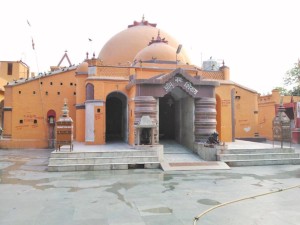 It is situated about 36 km east from Patna. It contains a very big ancient temple of Lord Shiva with a spacious compound containing a number of pucca building and verandas. Importance of this temple is that Shiv and Parvati both are jointly worshiped in one Shivling.Its design is a combination of both Hindu and Muslim architectural styles. This temple looks like a temple from front and like a mosque from behind.According to local people, this temple exist from Mahabharat times and the king Jarasandh (the ruler of Magadh) used to worship this Shivling. Formerly the temple was situated on the southern bank of the Ganges. Now, the Ganges has receded about 5 km north.
It is situated about 36 km east from Patna. It contains a very big ancient temple of Lord Shiva with a spacious compound containing a number of pucca building and verandas. Importance of this temple is that Shiv and Parvati both are jointly worshiped in one Shivling.Its design is a combination of both Hindu and Muslim architectural styles. This temple looks like a temple from front and like a mosque from behind.According to local people, this temple exist from Mahabharat times and the king Jarasandh (the ruler of Magadh) used to worship this Shivling. Formerly the temple was situated on the southern bank of the Ganges. Now, the Ganges has receded about 5 km north. 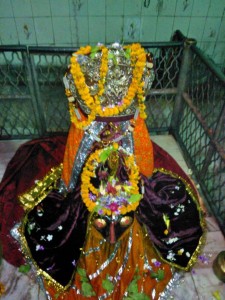
It was at this place that the mother of Maharaja Man Singh of Amber breathed her last and was cremated , when the said Maharaja on completing the term of his Viceroyalty of Bengal and Bihar and finally crushing, defeating and reducing the Afghans to submission in 1592 A.D. was on his way back to Delhi. The present temple was repaired by him in 1597 A.D.
Chhatri of Raja Man Singh (Baikatpur) :-It is one of the few remaining pieces of the art of Mughal times in this part of the country.
Temple of Naiea baba :-A saint always remained on a boat in the water of the Ganges. Management has constructed great cemented boat and temple in his memory on the Samadhi of the saint.
Bakhtiyarpur – Tajpur Bridge :-It is under construction which will connect Bakhtiyarpur in Patna And Tajpur in Samastipur. The bridge will provide an easy roadway link between the northern and southern parts of Bihar also reduce the traffic in the capital city of Patna. Chief minister Nitish Kumar inaugurated the construction of the 5.575 km long bridge in June, 2011.
Daniawan Block
Popular tourist destinations
Taraura:-During Archaeological Exploration performed by KP Jayaswal Research Institute Early Medieval Period site have been brought to light. Hasanpur:-During Archaeological Exploration performed by KP Jayaswal Research Institute Early Medieval Period site have been brought to light. Rampur(Sigriyama):-During Archaeological Exploration performed by KP Jayaswal Research Institute Early Medieval Period site have been brought to light. Maksudpur:-During Archaeological Exploration performed by KP Jayaswal Research Institute Early Medieval Period site have been brought to light. Barki Kewai:-During Archaeological Exploration performed by KP Jayaswal Research Institute Early Medieval Period site have been brought to light. Faidpur:-During Archaeological Exploration performed by KP Jayaswal Research Institute Early Medieval Period site have been brought to light. Daniawan:-During Archaeological Exploration performed by KP Jayaswal Research Institute Early Medieval Period site have been brought to light. Shahjahanpur:-During Archaeological Exploration performed by KP Jayaswal Research Institute Shunga Period site have been brought to light. Mustafapur:-During Archaeological Exploration performed by KP Jayaswal Research Institute NBPW Phase site have been brought to light.
Arai:-During Archaeological Exploration performed by KP Jayaswal Research Institute Early Medieval Period site have been brought to light.
Kanchanpur:-
Nabi Chak:-
Bakhtiyarpur Block
Popular tourist destinations
Bakhtiyarpur:-During Archaeological Exploration performed by KP Jayaswal Research Institute Late Medieval Period site have been brought to light. Vidhipur:-During Archaeological Exploration performed by KP Jayaswal Research Institute Early Medieval Period site have been brought to light. Rukunpura:-During Archaeological Exploration performed by KP Jayaswal Research Institute Early Medieval Period site have been brought to light. Lakhipur:-During Archaeological Exploration performed by KP Jayaswal Research Institute Early Medieval Period site have been brought to light. Ghansurpur:-During Archaeological Exploration performed by KP Jayaswal Research Institute Late Medieval Period site have been brought to light. Gayaspur:-During Archaeological Exploration performed by KP Jayaswal Research Institute Early Medieval Period site have been brought to light. Karauta:-During Archaeological Exploration performed by KP Jayaswal Research Institute Late Medieval Period site have been brought to light.
Jagdamba temple
Chakchhitu:-During Archaeological Exploration performed by KP Jayaswal Research Institute Late Medieval Period site have been brought to light. Mohammadpur:-During Archaeological Exploration performed by KP Jayaswal Research Institute Medieval Period site have been brought to light. Tarapur:-During Archaeological Exploration performed by KP Jayaswal Research Institute Late Medieval Period site have been brought to light. Hakikatpur:-During Archaeological Exploration performed by KP Jayaswal Research Institute Medieval Period site have been brought to light. Bahapur:-During Archaeological Exploration performed by KP Jayaswal Research Institute Medieval Period site have been brought to light. Sammatpur:-During Archaeological Exploration performed by KP Jayaswal Research Institute Late Medieval Period site have been brought to light. Saidpur:-During Archaeological Exploration performed by KP Jayaswal Research Institute late Medieval Period site have been brought to light. Rawaich:-During Archaeological Exploration performed by KP Jayaswal Research Institute Early Medieval Period site have been brought to light.
Athmalgola Block
Popular tourist destinations
Sabneema:-During Archaeological Exploration performed by KP Jayaswal Research Institute Late Medieval Period site have been brought to light. Athmalgola:-During Archaeological Exploration performed by KP Jayaswal Research Institute Late Medieval Period site have been brought to light.
Barh Block
Popular tourist destinations
Dayachak:-During Archaeological Exploration performed by KP Jayaswal Research Institute Late Medieval Period site have been brought to light. Gosai Math:-During Archaeological Exploration performed by KP Jayaswal Research Institute Medieval Period site have been brought to light.
Mega power project(Barh): –
 Barh has been named a mega power project, and is owned by Indian energy company NTPC (National Thermal Power Corporation). Around 3,300MW of coal-generated power is being added at Barh .The three-unit 1.98 GW Barh I is being built by Russian firm Technopromexport (TPE), and the other two-unit 1.32 GW Barh II extension is being built by BHEL. On 12 October 2013, 660MW unit of NTPC Barh was synchronised with the grid. The then prime minister of India, Atal Bihari Vajpayee, laid the foundation stone of the main plant of stage 1 of NTPC Barh Super Thermal Power Station on 6 March 1999. Then Union power minister Sushil Kumar Shinde inaugurated the main plant house of stage 2 of NTPC Barh on 29 May 2006.
Barh has been named a mega power project, and is owned by Indian energy company NTPC (National Thermal Power Corporation). Around 3,300MW of coal-generated power is being added at Barh .The three-unit 1.98 GW Barh I is being built by Russian firm Technopromexport (TPE), and the other two-unit 1.32 GW Barh II extension is being built by BHEL. On 12 October 2013, 660MW unit of NTPC Barh was synchronised with the grid. The then prime minister of India, Atal Bihari Vajpayee, laid the foundation stone of the main plant of stage 1 of NTPC Barh Super Thermal Power Station on 6 March 1999. Then Union power minister Sushil Kumar Shinde inaugurated the main plant house of stage 2 of NTPC Barh on 29 May 2006.
Barh court area:-The Barh court area is more than 150 years old.
The tomb of Suleiman Chisti:- It was built by the Pathan emperor Sher Shah Suri.
A mosque:-It is believed locally to have been constructed by the daughter of Mughal emperor Aurangzeb is situated on the banks of the Ganges in Barh.
Karbala:-Here is Aurangzeb’s Sister’s Mazar (Barh):-
Uttarayan Ganga:-
Jal Govinda(Barh):-During Archaeological Exploration performed by KP Jayaswal Research Institute Medieval Period site have been brought to light.
Umanath( Banarsi, Barh):-The Umanath Temple is said to be more than 800 years old.
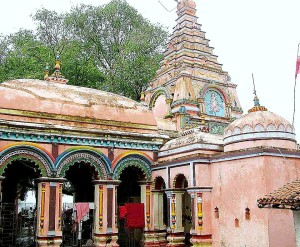 During Archaeological Exploration performed by KP Jayaswal Research Institute Late Medieval Period site have been brought to light.
During Archaeological Exploration performed by KP Jayaswal Research Institute Late Medieval Period site have been brought to light.
Bala Tripur Sundari Mandir :-
Belchhi Block
Popular tourist destinations
Andauli:-During Archaeological Exploration performed by KP Jayaswal Research Institute Late Gupta Period site have been brought to light. Saksohara:-During Archaeological Exploration performed by KP Jayaswal Research Institute Early Medieval Period site have been brought to light.Dallu Chak:-During Archaeological Exploration performed by KP Jayaswal Research Institute Early Medieval Period site have been brought to light. Kaima:-During Archaeological Exploration performed by KP Jayaswal Research Institute Early Medieval Period site have been brought to light. Kumhraura:-During Archaeological Exploration performed by KP Jayaswal Research Institute Early Medieval Period site have been brought to light. Andauli Khurd:-During Archaeological Exploration performed by KP Jayaswal Research Institute Early Medieval Period site have been brought to light.
Dhani Chak:-During Archaeological Exploration performed by KP Jayaswal Research Institute Early Medieval Period site have been brought to light. Darveshpur:-During Archaeological Exploration performed by KP Jayaswal Research Institute Early Medieval Period site have been brought to light.
Pandarak Block
Popular tourist destinations
Paithani Chak:-During Archaeological Exploration performed by KP Jayaswal Research Institute Early Medieval Period site have been brought to light. Pandarak:-During Archaeological Exploration performed by KP Jayaswal Research Institute Early Medieval Period site have been brought to light. Punarakh:-During Archaeological Exploration performed by KP Jayaswal Research Institute Early Medieval Period site have been brought to light.
Mokama Block
Mokama is a town and a municipality in Patna District situated on the southern banks of the Ganges. It is said that Mokama fell on the route of the armies moving along the river Ganges during the Mughal and British periods.
How To Reach
By Air (Airport) :-
By Rail :-
By Road :-
Mokama is the junction point of NH 80 & NH 31 .
Popular tourist destinations
Maranchi:-During Archaeological Exploration performed by KP Jayaswal Research Institute Early Medieval Period site have been brought to light. Ram Tola(Mokama):-During Archaeological Exploration performed by KP Jayaswal Research Institute Early Medieval Period site have been brought to light.
Church (Mokama):-
Hanuman Mandir(Mokamesh) :-Mokameh Mokama is situated on the southern banks of the Ganga. The landscape here is absolutely flat. Here the land strip along the north of Ganga is called Diara, which submerges in Ganga during monsoons, On the south of Mokameh is the “Tal” region which also gets submerged with the backwaters of Ganges during the monsoons.
Vishari Sthan (Mokameh):-
Parshuram Stan :-Just one km from Mokama Police Station.
Mokama Ghat :-Mokama Ghat is a village about four kilometres east of Mokama on the bank of the river Ganga. Mokama Ghat was used for ferrying cargo and passengers by ships across the river to the north eastern parts of India until the first half of 20th century. It was linked by rail to Mokama, and was once an important railway station under the Danapur division of the East Central Railway Zone. It was also linked by road. The passengers and goods would be carried by either road or rail to Mokama Ghat, where they would be transported by ship across the river to Simaria Ghat. After the construction of Rajendra Setu which was both a road and rail bridge, that importance was lost.
Mokama Ghat was brought to the map of the struggle for Indian independence in 1908 when Prafulla Chaki was spotted at Mokama Ghat railway station while he was trying to escape after throwing a bomb at a Carriage at Muzaffarpur on 30 April 1908 in which a European lady, Mrs. Kennedy and her daughter were killed. After a standoff with police, Chaki shot himself.
Rajendra bridge:-
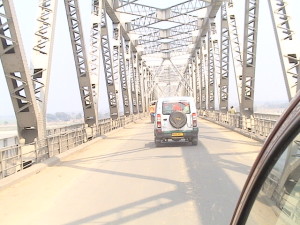 It also known as Mokama Bridge across the Ganges is the first bridge to link North Bihar and South Bihar.It is the road-cum-rail bridge near Maranchi in Patna district was inaugurated by Dr Rajendra Prasad 1st President of India. It was Constructed by The Braithwaite Burn & Jessop Construction Company Limited and designed by Dr Vishveshwarya .
It also known as Mokama Bridge across the Ganges is the first bridge to link North Bihar and South Bihar.It is the road-cum-rail bridge near Maranchi in Patna district was inaugurated by Dr Rajendra Prasad 1st President of India. It was Constructed by The Braithwaite Burn & Jessop Construction Company Limited and designed by Dr Vishveshwarya . 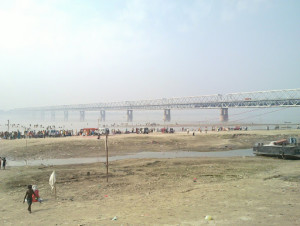 It is about 2 kilometres (1.2 mi) long and carries a two lane road and a double line railway track. It is the only bridge that carries railway tracks across the Ganges in the state of Bihar . It was opened in 1959.
It is about 2 kilometres (1.2 mi) long and carries a two lane road and a double line railway track. It is the only bridge that carries railway tracks across the Ganges in the state of Bihar . It was opened in 1959.
Shaheed Gate :-The place where the revolutionary freedom fighter Prafulla Chaki was martyred is marked by a Shaheed gate. People commemorate the anniversary of his death every year.
Bindtoli:-During Archaeological Exploration performed by KP Jayaswal Research Institute Early Medieval Period site have been brought to light. Auta:-During Archaeological Exploration performed by KP Jayaswal Research Institute Medieval Period site have been brought to light. Dhaampur:-During Archaeological Exploration performed by KP Jayaswal Research Institute Medieval Period site have been brought to light.Dariyapur:-During Archaeological Exploration performed by KP Jayaswal Research Institute Medieval Period site have been brought to light. Mor:-During Archaeological Exploration performed by KP Jayaswal Research Institute Early Medieval Period site have been brought to light. Mekra:-During Archaeological Exploration performed by KP Jayaswal Research Institute Early Medieval Period site have been brought to light. Barahpur:-During Archaeological Exploration performed by KP Jayaswal Research Institute Early Medieval Period site have been brought to light.Inglis:-During Archaeological Exploration performed by KP Jayaswal Research Institute Early Medieval Period site have been brought to light. Kanahaipur:-During Archaeological Exploration performed by KP Jayaswal Research Institute Early Medieval Period site have been brought to light. Mahendrapur:-During Archaeological Exploration performed by KP Jayaswal Research Institute Late Medieval Period site have been brought to light.
Kaji Muhalla:-During Archaeological Exploration performed by KP Jayaswal Research Institute late Medieval Period site have been brought to light. Hathi Tola:-During Archaeological Exploration performed by KP Jayaswal Research Institute Late Medieval Period site have been brought to light.
Nilkanth Mahadev Mandir(Seonar):-It is located 1.5 km west of Mokama.During Archaeological Exploration performed by KP Jayaswal Research Institute Early Medieval Period site have been brought to light.
Sultanpur:-During Archaeological Exploration performed by KP Jayaswal Research Institute Early Medieval Period site have been brought to light.
Ghoswari Block
Popular tourist destinations
Isangarh:-During Archaeological Exploration performed by KP Jayaswal Research Institute Early Medieval Period site have been brought to light. Shahri:-During Archaeological Exploration performed by KP Jayaswal Research Institute Early Medieval Period site have been brought to light. Nauadih:-During Archaeological Exploration performed by KP Jayaswal Research Institute NBPW Phase site have been brought to light.
Dhanarua Block
Popular tourist destinations
Karimdi Chak:-During Archaeological Exploration performed by KP Jayaswal Research Institute Early Medieval Period site have been brought to light. Chandu Bigha:-During Archaeological Exploration performed by KP Jayaswal Research Institute Early Medieval Period site have been brought to light. Chani Dih:-During Archaeological Exploration performed by KP Jayaswal Research Institute Early Medieval Period site have been brought to light. Bijawar:-During Archaeological Exploration performed by KP Jayaswal Research Institute Early Medieval Period site have been brought to light. Sahru:-During Archaeological Exploration performed by KP Jayaswal Research Institute Early Medieval Period site have been brought to light. Shakarpura:-During Archaeological Exploration performed by KP Jayaswal Research Institute Early Medieval Period site have been brought to light. Dhanarua:-During Archaeological Exploration performed by KP Jayaswal Research Institute Early Medieval Period site have been brought to light. Mishri Chak:-During Archaeological Exploration performed by KP Jayaswal Research Institute Early Medieval Period site have been brought to light. Nima:-During Archaeological Exploration performed by KP Jayaswal Research Institute Early Medieval Period site have been brought to light. Nadwan:-During Archaeological Exploration performed by KP Jayaswal Research Institute Medieval Period site have been brought to light. Bir:-During Archaeological Exploration performed by KP Jayaswal Research Institute Early Medieval Period site have been brought to light. Oiyara:-During Archaeological Exploration performed by KP Jayaswal Research Institute Early Medieval Period site have been brought to light. Kaili:-During Archaeological Exploration performed by KP Jayaswal Research Institute Early Medieval Period site have been brought to light. Damri Chak:–During Archaeological Exploration performed by KP Jayaswal Research Institute Early Medieval Period site have been brought to light. Nai Haweli:-During Archaeological Exploration performed by KP Jayaswal Research Institute Early Medieval Period site have been brought to light.
Punpun Block
Punpun(25°29’46″N 85°6’10″E) is a satellite town in Patna Metropolitan Region in Patna district.Mata Sita has spent some time near Punpun village at the bank of Punpun river. For Pind-daan Gaya and Punpun are the most important/ auspicious place in Hindu Dharma. Every year from Nepal and all over India Hindus come here to do pind-dan. It is saying that first pind-dan is done in Punpun after than Gaya.
How To Reach
By Air(Airport):-
By Rail:-
By Road:-
It is located 10 km south of Patna.
Popular tourist destinations
Wajitpur:-Mauritius President Rajkeswur Purryag with his wife Aneetah Purryag and Bihar Chief Minister Nitish Kumar visited Wajitpur village on sunday 6th January 2013. Purryag great-grandfather, named Prayag, lived in Wajidpur village before he migrated to Mauritius, then a British colony, in the 19th century, to work as an indentured labourer. Purryag was welcomed by villagers in traditional style and met his distant relatives Ganesh and Mahesh Mahto.
The Mahtos gifted some soil and a bushel of freshly-harvested paddy to Purryag. Some villagers also presented him a silver memento.
Narwan Chak:-During Archaeological Exploration performed by KP Jayaswal Research Institute Early Medieval Period site have been brought to light. Keora:-During Archaeological Exploration performed by KP Jayaswal Research Institute Early Medieval Period site have been brought to light. Koiri Bigha:-During Archaeological Exploration performed by KP Jayaswal Research Institute Early Medieval Period site have been brought to light. Saman Chak:-During Archaeological Exploration performed by KP Jayaswal Research Institute NBPW Phase site have been brought to light. Habbipur:-During Archaeological Exploration performed by KP Jayaswal Research Institute Early Medieval Period site have been brought to light. Jatt Dumri:-During Archaeological Exploration performed by KP Jayaswal Research Institute Early Medieval Period site have been brought to light.
Dhankipar:-During Archaeological Exploration performed by KP Jayaswal Research Institute Early Medieval Period site have been brought to light. Barawan:-During Archaeological Exploration performed by KP Jayaswal Research Institute Later Gupta Period site have been brought to light. Chandasi:-During Archaeological Exploration performed by KP Jayaswal Research Institute Early Medieval Period site have been brought to light. Tailiyanpar:-During Archaeological Exploration performed by KP Jayaswal Research Institute Early Medieval Period site have been brought to light. Mustaffapur:-During Archaeological Exploration performed by KP Jayaswal Research Institute Early Medieval Period site have been brought to light. Pothihi:-During Archaeological Exploration performed by KP Jayaswal Research Institute Early Medieval Period site have been brought to light.
Masaurhi Block
Masaurhi is located at 25°41’0″ N 85°02’0″ E. It is a city and a Nagar Parishad in Patna District.
How To Reach
By Air(Airport) :-
Here is no airport. Nearest airport Patna & Bodh Gaya
By Rail :-
Masaurhi is major railway station in Patna-Gaya railway line. Masaurhi is known as Taregna(TEA)
By Road :-
National highway No.83 ( Patna—Masaurhi- Jehanabad- Gaya -Bodhgaya-Dobhi)and State Highway No.1 . National Highway no. 83 is a part of Buddha circuit road. Masaurhi-pali Road, Masaurhi-Ekangar Sarai-Bihar Sharif Road also a very important road. There are three bus stations in Masaurhi
1. East Bus Station- For Jehanabad, Gaya via NH-83. For Patna,Dhanarua,Paveri,Gaurichak via SH-1.
2. Taregna Bus station- For Nadwan,Pothi, Punpun,Mithapur, Patna Via NH-8
3. West Bus Station- For Noorah, Pitmas, Bikram, Patna, For Pali via Masaurhi-Pali state highway road.
It is located 30 km from Patna, the capital of Bihar state.
Popular tourist destinations
Taregna (Sun Temple):-
 The statue of lord vishnu made of Black Stone and of alloys of the Ashoka time was found in 1948 while doing cultivation in paddy field .Later on it was thought by the villagers to establish a temple of Sun god along with Sri Vishnu. Many people got good return of the worship in the temple during Chath and otherwise. So earnings by donation gave the present shape and status of the temple. It is established in 3 bighas of land ,with a big pond.
The statue of lord vishnu made of Black Stone and of alloys of the Ashoka time was found in 1948 while doing cultivation in paddy field .Later on it was thought by the villagers to establish a temple of Sun god along with Sri Vishnu. Many people got good return of the worship in the temple during Chath and otherwise. So earnings by donation gave the present shape and status of the temple. It is established in 3 bighas of land ,with a big pond.
Taregna Place of Aryabhatta observatory:It is a small town about 30 km south from Patna near NH83 and also connected by rail with railway station on it’s name.There are the remains of Ashoka the Great , because in some villages Statues made of Black Stone and of alloys were found and are worshipped as God by the locals. It is workplace of 6 th century mathematician and astronomer Aryabhatta, who discovered the notion of Zero and also proposed that the earth rotates on its axis. Aryabhatta’s made his observatory on a 20 feet high land at the sun temple that once existed in Taregna.
It was from this observatory that he and his team used to gaze at the stars. He was born in 476 A D. and wrote his Kala-kriya (calculation of time) here at the age of 23 that is, 499 A.D. Their condition has become worsened without any maintenance.
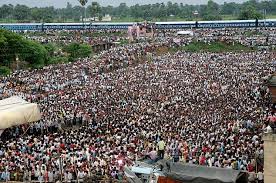


 National Aeronautics And Space Administration(NASA) affirmed after its two decades of research that Taregana is the perfect place to watch the total clear solar eclipse on 22,July ,2009.According to the US National Aeronautics and Space Agency’s observation based on satellite images, the total eclipse — expected to last three minutes and 48 seconds at Taregna — will start a little after sunrise on July 22.
National Aeronautics And Space Administration(NASA) affirmed after its two decades of research that Taregana is the perfect place to watch the total clear solar eclipse on 22,July ,2009.According to the US National Aeronautics and Space Agency’s observation based on satellite images, the total eclipse — expected to last three minutes and 48 seconds at Taregna — will start a little after sunrise on July 22.
Scientists and eclipse chasers from across the world are in this non-descript village to witness the longest total solar eclipse of the 21st century on July 22.
Drona Stupa (Bhagwanganj) :-
The ninth Drona Stupa, which is said to be the site where the last rites of Lord Buddha were performed, has been located at Bhagwanganj village .
Former director of archaeology P C Prasad, Lt Colonel Umesh Prasad of Danapur cantonment and an official of the archaeological department Jameel Akhtar discovered the Drona Stupa which is said to be built over a vessel with which a brahmin named Drona had distributed Buddha’s relics to eight claimants.
The Drona Stupa had been mentioned by Chinese traveller Hieun Tsang in his accounts and by various historians.
Bhagwanganj village has the remains of two large stupas . However, atop one Stupa villagers erected a structure about 30 years ago.
Dr Prasad said the Stupa built around six or seven B C was likely to be where the last rites of the Buddha were performed and the relics distributed to eight other places. However, a detailed research would bear testimony to the fact, the archaeologist added.
Lt Colonel Prasad said the team had clearly found antiquity of the mounds of pre-Mauryan times on the site of the original Drona Stupa.
Renowned historian J D Beglar, who visited the village in 1872-73, mentioned the Stupa in his Archaeological Survey of India report. The Drona Stupa, had a diameter of 35 to 40 feet and a height of 20 feet. The Stupa, built of large bricks laid horizontally and set in mud and bricks, was identified as the Drona Stupa by Beglar.
Sukmal Chak:-During Archaeological Exploration performed by KP Jayaswal Research Institute Early Medieval Period site have been brought to light. Salimpur:-During Archaeological Exploration performed by KP Jayaswal Research Institute Early Medieval Period site have been brought to light.. Kharjo:-During Archaeological Exploration performed by KP Jayaswal Research Institute Early Medieval Period site have been brought to light.. Gopalpur:-During Archaeological Exploration performed by KP Jayaswal Research Institute Early Medieval Period site have been brought to light. Tineri:-During Archaeological Exploration performed by KP Jayaswal Research Institute Early Medieval Period site have been brought to light.. Mathiya:-During Archaeological Exploration performed by KP Jayaswal Research Institute Early Medieval Period site have been brought to light. Rava:-During Archaeological Exploration performed by KP Jayaswal Research Institute Early Medieval Period site have been brought to light. Saguni:-During Archaeological Exploration performed by KP Jayaswal Research Institute Early Medieval Period site have been brought to light. Hansadih:-During Archaeological Exploration performed by KP Jayaswal Research Institute Early Medieval Period site have been brought to light. Nura:-During Archaeological Exploration performed by KP Jayaswal Research Institute Early Medieval Period site have been brought to light. Tulsichauk:-During Archaeological Exploration performed by KP Jayaswal Research Institute Early Medieval Period site have been brought to light. Modan Chauk:-During Archaeological Exploration performed by KP Jayaswal Research Institute Early Medieval Period site have been brought to light.
Chhata:-During Archaeological Exploration performed by KP Jayaswal Research Institute Early Medieval Period site have been brought to light. Charma:–During Archaeological Exploration performed by KP Jayaswal Research Institute Early Medieval Period site have been brought to light. Kharant:-During Archaeological Exploration performed by KP Jayaswal Research Institute Early Medieval Period site have been brought to light.
Tiskhora:-During Archaeological Exploration performed by KP Jayaswal Research Institute Early Medieval Period site have been brought to light. Begam Chak:-During Archaeological Exploration performed by KP Jayaswal Research Institute Early Medieval Period site have been brought to light. Bhgwanpur:-During Archaeological Exploration performed by KP Jayaswal Research Institute Early Medieval Period site have been brought to light. Masaurhi:-During Archaeological Exploration performed by KP Jayaswal Research Institute Early Medieval Period site have been brought to light.
Manichak Sun Temple (Masaurhi):-
Sonkukura:-During Archaeological Exploration performed by KP Jayaswal Research Institute Early Medieval Period site have been brought to light. Sahapur:-During Archaeological Exploration performed by KP Jayaswal Research Institute Early Medieval Period site have been brought to light. Vajour:-During Archaeological Exploration performed by KP Jayaswal Research Institute Early Medieval Period site have been brought to light.. Jaitti Chak:-During Archaeological Exploration performed by KP Jayaswal Research Institute Early Medieval Period site have been brought to light. Karwa:-During Archaeological Exploration performed by KP Jayaswal Research Institute Early Medieval Period site have been brought to light. Digma:-During Archaeological Exploration performed by KP Jayaswal Research Institute Early Medieval antiquities was found here.
Basaur:-During Archaeological Exploration performed by KP Jayaswal Research Institute Early Medieval Period site have been brought to light.
